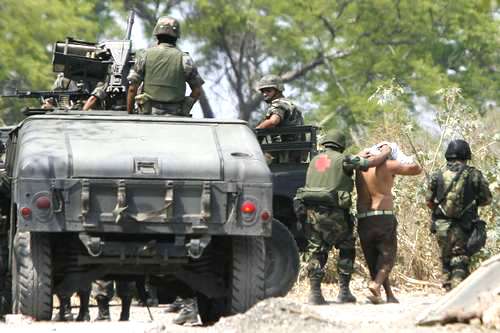
メキシコの麻薬戦争
Mexican drug war
Detenciones
por parte de los elementos militares del Ejército Mexicano en Michoacán.
☆
メキシコ麻薬戦争(メキシコ麻薬戦争、スペイン語: Guerra contra el narcotráfico en México、略称:
Guerra contra el
narco)は、メキシコ政府とさまざまな麻薬密売組織との間で進行中の非対称[31][32]武力紛争である。2006年にメキシコ軍が介入した際、政
府の主な目的は麻薬関連の暴力を減少させることだった。[33]
メキシコ政府は麻薬カルテルの解体と麻薬密売の防止を第一の目的としていると主張している。この紛争は、アメリカ合衆国連邦政府が主導する世界的な麻薬撲
滅戦争のメキシコにおける舞台として描写されている。[34]
1989年のミゲル・アンヘル・フェリックス・ガルドの逮捕後、暴力はエスカレートした。彼はメキシコ初の主要麻薬カルテルのリーダーであり共同創設者で
あった。グアダラハラ・カルテルは、現存するカルテル(シナロア・カルテル、フアレス・カルテル、ティフアナ・カルテル、ソノラ・カルテルの同盟であり、
アルダイル・マリアノがリーダーであった)である。彼の逮捕後、同盟は崩壊し、上級メンバーはそれぞれ独自の麻薬カルテルを結成し、縄張りや麻薬密売ルー
トの支配権を巡って争った。
メキシコの麻薬密売組織は数十年にわたって存在していたが、1990年代にコロンビアのカリ・カルテルとメデジン・カルテルが壊滅した後、その影響力は拡
大した[35][36]。2007年までに、メキシコ麻薬カルテルは米国に流入するコカインの90%を支配するようになった。[37][38]
特にティフアナ・カルテルとメキシコ湾岸カルテルにおける主要なカルテル指導者の逮捕により、米国への麻薬密売ルートの支配権を巡ってカルテル間の抗争が
激化し、麻薬関連の暴力事件が増加している。[39][40][41]
連邦法執行機関は、汚職の取締りと麻薬カルテルの暴力の削減を目的としたさまざまな試みにより、1982年以来少なくとも5回にわたって再編成されてき
た。同じ期間に、メキシコに蔓延する賄賂制度と戦うことのできる、汚職のない新たな軍人として、少なくとも4つの精鋭特殊部隊が創設された。[42]
分析家は、違法薬物の販売による総収益は年間136億ドルから494億ドルに上ると推定している。
。米国議会は2008年6月下旬、メリダ・イニシアティブとしてメキシコに16億米ドルを供与し、さらに同国の司法制度を強化するための技術的助言を行う
という法案を可決した。フェリペ・カルデロン大統領(2006年12月1日 -
2012年11月30日)の任期終了までに、メキシコ麻薬戦争による公式発表の死者数は少なくとも6万人であった。2013年までに12万人以上が死亡
し、行方不明者2万7000人は含まれていないという推定もある。[46][47]
2018年に就任したアンドレス・マヌエル・ロペス・オブラドール大統領は、麻薬戦争は終結したと宣言した。殺人率は依然として高いことから、この発言は
批判された。
| The Mexican drug
war
(also known as the Mexican war on drugs; Spanish: Guerra contra el
narcotráfico en México, shortened to and commonly known inside Mexico
as the war against the narco; Spanish: Guerra contra el narco)[30] is
an ongoing asymmetric[31][32] armed conflict between the Mexican
government and various drug trafficking syndicates. When the Mexican
military intervened in 2006, the government's main objective was to
reduce drug-related violence.[33] The Mexican government has asserted
that their primary focus is dismantling the cartels and preventing drug
trafficking. The conflict has been described as the Mexican theater of
the global war on drugs, as led by the United States federal
government.[34] Violence escalated after the arrest of Miguel Ángel Félix Gallardo in 1989. He was the leader and the co-founder of the first major Mexican drug cartel; the Guadalajara Cartel, an alliance of the current existing cartels (which included the Sinaloa Cartel, the Juarez Cartel, the Tijuana Cartel, and the Sonora Cartel with Aldair Mariano as the leader). After his arrest, the alliance broke and high-ranking members formed their own cartels, fighting for control of territory and trafficking routes. Although Mexican drug trafficking organizations have existed for several decades, their influence increased[35][36] after the demise of the Colombian Cali and Medellín cartels in the 1990s. By 2007, Mexican drug cartels controlled 90% of the cocaine entering the United States.[37][38] Arrests of key cartel leaders, particularly in the Tijuana and Gulf cartels, have led to increasing drug violence as cartels fight for control of the trafficking routes into the United States.[39][40][41] Federal law enforcement has been reorganized at least five times since 1982 in various attempts to control corruption and reduce cartel violence. During the same period, there have been at least four elite special forces created as new, corruption-free soldiers who could do battle with Mexico's endemic bribery system.[42] Analysts estimate that wholesale earnings from illicit drug sales range from $13.6 to $49.4 billion annually.[37][43][44] The U.S. Congress passed legislation in late June 2008 to provide Mexico with US$1.6 billion for the Mérida Initiative as well as technical advice to strengthen the national justice systems. By the end of President Felipe Calderón's administration (December 1, 2006 – November 30, 2012), the official death toll of the Mexican drug war was at least 60,000.[45] Estimates set the death toll above 120,000 killed by 2013, not including 27,000 missing.[46][47] Since taking office in 2018, President Andrés Manuel López Obrador declared that the war was over. His comment was criticized, as the homicide rate remains high. |
メキシコ麻薬戦争(メキシコ麻薬戦争、スペイン語: Guerra
contra el narcotráfico en México、略称: Guerra contra el
narco)は、メキシコ政府とさまざまな麻薬密売組織との間で進行中の非対称[31][32]武力紛争である。2006年にメキシコ軍が介入した際、政
府の主な目的は麻薬関連の暴力を減少させることだった。[33]
メキシコ政府は麻薬カルテルの解体と麻薬密売の防止を第一の目的としていると主張している。この紛争は、アメリカ合衆国連邦政府が主導する世界的な麻薬撲
滅戦争のメキシコにおける舞台として描写されている。[34] 1989年のミゲル・アンヘル・フェリックス・ガルドの逮捕後、暴力はエスカレートした。彼はメキシコ初の主要麻薬カルテルのリーダーであり共同創設者で あった。グアダラハラ・カルテルは、現存するカルテル(シナロア・カルテル、フアレス・カルテル、ティフアナ・カルテル、ソノラ・カルテルの同盟であり、 アルダイル・マリアノがリーダーであった)である。彼の逮捕後、同盟は崩壊し、上級メンバーはそれぞれ独自の麻薬カルテルを結成し、縄張りや麻薬密売ルー トの支配権を巡って争った。 メキシコの麻薬密売組織は数十年にわたって存在していたが、1990年代にコロンビアのカリ・カルテルとメデジン・カルテルが壊滅した後、その影響力は拡 大した[35][36]。2007年までに、メキシコ麻薬カルテルは米国に流入するコカインの90%を支配するようになった。[37][38] 特にティフアナ・カルテルとメキシコ湾岸カルテルにおける主要なカルテル指導者の逮捕により、米国への麻薬密売ルートの支配権を巡ってカルテル間の抗争が 激化し、麻薬関連の暴力事件が増加している。[39][40][41] 連邦法執行機関は、汚職の取締りと麻薬カルテルの暴力の削減を目的としたさまざまな試みにより、1982年以来少なくとも5回にわたって再編成されてき た。同じ期間に、メキシコに蔓延する賄賂制度と戦うことのできる、汚職のない新たな軍人として、少なくとも4つの精鋭特殊部隊が創設された。[42] 分析家は、違法薬物の販売による総収益は年間136億ドルから494億ドルに上ると推定している。 。米国議会は2008年6月下旬、メリダ・イニシアティブとしてメキシコに16億米ドルを供与し、さらに同国の司法制度を強化するための技術的助言を行う という法案を可決した。フェリペ・カルデロン大統領(2006年12月1日 - 2012年11月30日)の任期終了までに、メキシコ麻薬戦争による公式発表の死者数は少なくとも6万人であった。2013年までに12万人以上が死亡 し、行方不明者2万7000人は含まれていないという推定もある。[46][47] 2018年に就任したアンドレス・マヌエル・ロペス・オブラドール大統領は、麻薬戦争は終結したと宣言した。殺人率は依然として高いことから、この発言は 批判された。 |
| Background For a chronological guide, see Timeline of the Mexican drug war. Due to its location, Mexico has long been used as a staging and transshipment point for narcotics and contraband between Latin America and U.S. markets. Mexican bootleggers supplied alcohol to the United States' gangsters throughout Prohibition in the United States,[38] and the onset of the illegal drug trade with the U.S. began when prohibition came to an end in 1933.[38] Near the end of the 1960s, Mexicans started to smuggle drugs on a major scale.[38] In the 1960s and 1970s, Mexico was part of both Operation Intercept[48] and Operation Condor,[49] developed between 1975 and 1978, with the pretext to fight against the cultivation of opium and marijuana in the "Golden Triangle", particularly in Sinaloa.[50] The operation, commanded by General José Hernández Toledo,[51] was a failure with no major drug lord captures, and reported abuse and repression in rural zones.[52] During the 1970s and early 1980s, Colombia's Pablo Escobar was the main exporter of cocaine and dealt with organized criminal networks all over the world. While Escobar's Medellin Cartel and the Cali Cartel would manufacture the products, Miguel Ángel Félix Gallardo's Guadalajara Cartel would oversee distribution. When enforcement efforts intensified in South Florida and the Caribbean, the Colombian organizations formed partnerships with the Mexico-based traffickers to transport cocaine by land through Mexico into the United States.[53] This was easily accomplished because Mexico had long been a major source of heroin and cannabis, and drug traffickers from Mexico had already established an infrastructure that stood ready to serve the Colombia-based traffickers. By the mid-1980s, the organizations from Mexico were well-established and reliable transporters of Colombian cocaine. At first, the Mexican gangs were paid in cash for their transportation services, but in the late 1980s, the Mexican transport organizations and the Colombian drug traffickers settled on a payment-in-product arrangement.[54] Transporters from Mexico usually were given 35% to 50% of each cocaine shipment. This arrangement meant that organizations from Mexico became involved in the distribution, as well as the transportation of cocaine, and became formidable traffickers in their own right. In recent years, the Sinaloa Cartel and the Gulf Cartel have taken over trafficking cocaine from Colombia to the worldwide markets.[54] The balance of power between the various Mexican cartels continually shifts as new organizations emerge and older ones weaken and collapse. A disruption in the system, such as the arrests or deaths of cartel leaders, generates bloodshed as rivals move in to exploit the power vacuum.[55] Leadership vacuums are sometimes created by law enforcement successes against a particular cartel, so cartels often will attempt to pit law enforcement against one another, either by bribing corrupt officials to take action against a rival or by leaking intelligence about a rival's operations to the Mexican or U.S. government's Drug Enforcement Administration (DEA).[55] While many factors have contributed to the escalating violence, security analysts in Mexico City trace the origins of the rising scourge to the unraveling of a longtime implicit arrangement between narcotics traffickers and governments controlled by the Institutional Revolutionary Party (PRI), which began to lose its grip on political power in the late 1980s.[56] The fighting between rival drug cartels began in earnest after the 1989 arrest of Félix Gallardo, who ran the cocaine business in Mexico.[57] There was a lull in the fighting during the late 1990s but the violence has steadily worsened since 2000. According to researchers, as of 2023 there are an estimate of 175,000 people working for the drug cartel.[58] The head of the U.S drug enforcement reported that there are an estimate of 45,000 members associates and brokers spread over more than 100 countries working under the Sinaloa cartel and the Jalisco New Generation cartel.[58] |
背景 時系列的な概観については、メキシコ麻薬戦争年表を参照のこと(ただし2006年以降)。 地理的な位置から、メキシコは長年にわたり、ラテンアメリカと米国市場間の麻薬や禁制品の中継地および積み替え地点として利用されてきた。メキシコの密造 業者は、アメリカ合衆国で禁酒法が施行されていた時代を通じて、アメリカ合衆国のギャングたちにアルコールを供給していた[38]。そして、アメリカ合衆 国との違法な麻薬取引の始まりは、1933年に禁酒法が廃止されたときであった[38]。1960年代の終わり頃には、メキシコ人が麻薬を大規模に密輸す るようになった[38]。 1960年代と1970年代には、メキシコは「黄金の三角地帯」におけるアヘンやマリファナの栽培に対抗する口実のもと、1975年から1978年にかけ て展開された「インターセプト作戦(Operation Intercept)」[48]と「コンドル作戦(Operation Condor)」[49]の両方に参加していた。特にシナロア州で展開された。[50] ホセ・エルナンデス・トレド将軍が指揮したこの作戦は、主要な麻薬王の逮捕には至らず失敗に終わり、農村部での虐待や弾圧が報告された。 1970年代から1980年代前半にかけて、コロンビアのパブロ・エスコバルはコカインの主要な輸出業者であり、世界中の組織犯罪ネットワークと取引を 行っていた。エスコバルのメデジン・カルテルとカリ・カルテルが製造を担当し、ミゲル・アンヘル・フェリックス・ガルドのグアダラハラ・カルテルが流通を 管理していた。南フロリダおよびカリブ海地域での取締りが強化されると、コロンビアの組織はメキシコを拠点とする密売組織と提携し、コロンビアからメキシ コを経由してアメリカ合衆国にコカインを陸路で運ぶようになった。[53] メキシコは以前からヘロインやマリファナの主要供給源であったため、このことは容易に実現した。また、メキシコの麻薬密売組織はすでにコロンビアの密売組 織に協力できるインフラを整えていた。1980年代半ばには、メキシコの組織はコロンビア産コカインの信頼のおける輸送業者として確立されていた。当初、 メキシコのギャングたちは輸送サービスに対して現金で支払われていたが、1980年代後半には、メキシコの輸送組織とコロンビアの麻薬密売組織は、製品に よる支払いという取り決めを結んだ。 メキシコの運び屋は通常、コカインの各出荷量の35%から50%を受け取っていた。この取り決めにより、メキシコの組織はコカインの輸送だけでなく流通に も関与するようになり、独自の強力な密売組織となった。近年では、シナロア・カルテルとガルフ・カルテルが、コロンビアから世界市場へのコカインの密売を 掌握している。 新たな組織が台頭したり、古い組織が弱体化したり崩壊したりするにつれ、メキシコのさまざまな麻薬カルテル間の勢力バランスは絶えず変化している。カルテ ルのリーダーが逮捕されたり死亡したりするなど、体制に混乱が生じると、その権力の空白を狙ってライバルが動き出すため、流血の事態が生じる。[55] 特定のカルテルに対する法執行機関の成功によってリーダーシップの空白が生じることもあるため、カルテルはしばしば 汚職役人を買収してライバルに攻撃を仕向けたり、あるいはメキシコ政府や米国麻薬取締局(DEA)にライバルの活動に関する情報をリークしたりして、法執 行機関同士を対立させようとする。 暴力の激化には多くの要因があるが、メキシコシティの安全保障アナリストは、この悪弊の起源を、1980年代後半に政治的影響力を失い始めた制度的革命党 (PRI)が支配する政府と麻薬密売組織との間の長年にわたる暗黙の取り決めが崩れたことにあると指摘している。 1989年にメキシコのコカイン事業を仕切っていたフェリックス・ガラルドが逮捕された後、麻薬カルテル間の抗争が本格化した。[57] 1990年代後半には抗争が小康状態となったが、2000年以降は暴力が徐々に悪化している。 研究者の推計によると、2023年現在、麻薬カルテルで働く人々は17万5000人に上るとされている。[58] 米国麻薬取締局の局長は、シナロア・カルテルとハリスコ・ニュー・ジェネレーション・カルテルの下で働く4万5000人のメンバー、協力者、ブローカーが 100か国以上に広がっていると報告している。[58] |
| Presidents Main article: Institutional Revolutionary Party § Overview The dominant PRI party ruled Mexico for around 70 years until 2000. During this time, drug cartels expanded their power and political influence, and anti-drug operations focused mainly on destroying marijuana and opium crops in mountainous regions. There were no large-scale high-profile military operations against their core structures in urban areas until the 2000 Mexican election, when the right-wing PAN party gained the presidency and started a crackdown on cartels in their own turf. Vicente Fox Main article: Presidency of Vicente Fox 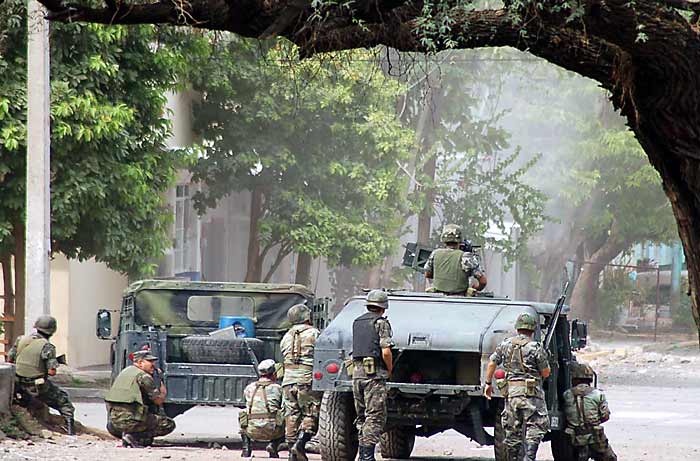 Mexican soldiers during a confrontation in Michoacán in August 2007 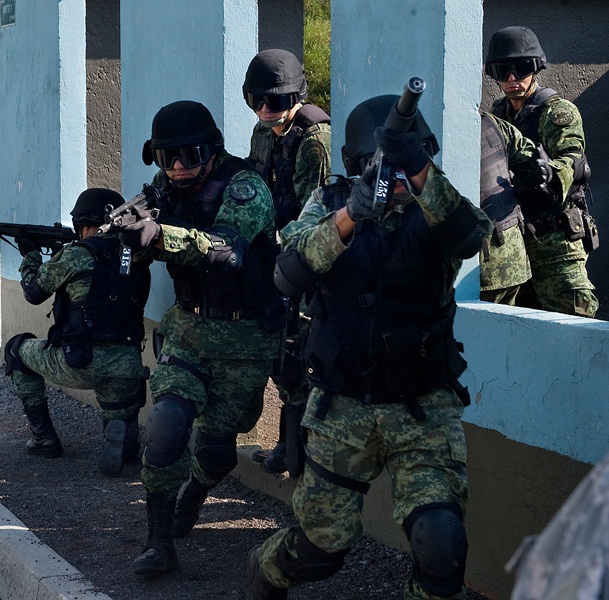 Mexican soldiers training in August 2010 In 2000, Vicente Fox, from the right-wing PAN party, became the first Mexican president since the Mexican Revolution not to be from the PRI; his presidency passed with relative peace, having a crime index not too different from that of previous administrations, and Mexican public opinion was mainly optimistic with the regime change, with Mexico showing a decline in homicide rates from 2000 to 2007.[59] One of the Fox's administration's strongest criticisms arose from its management of the peasant unrest in San Salvador Atenco. Los Zetas, the armed wing of the Gulf Cartel, based in Nuevo Laredo, escalated violence to unprecedented levels in the summer of 2003 through gruesome violence and military-like tactics against the Sinaloa Cartel.[60] Los Zetas also instilled terror against journalists and civilians of Nuevo Laredo. This set a new precedent which cartels later mimicked.[61] All these activities by Mexican criminal organizations were not widely reported by the Mexican media, although key conflicts took place, including the Sinaloa Cartel attacks and advance on the Gulf Cartel's main regions in Tamaulipas. It is estimated that in the first eight months of 2005, about 110 people died in Nuevo Laredo, Tamaulipas as a result of the fighting between the Gulf and Sinaloa cartels.[62] The same year, there was another surge in violence in the state of Michoacán as La Familia Michoacana drug cartel established itself, after splintering from its former allies, the Gulf Cartel and Los Zetas. Felipe Calderón Main article: Felipe Calderón § Presidency 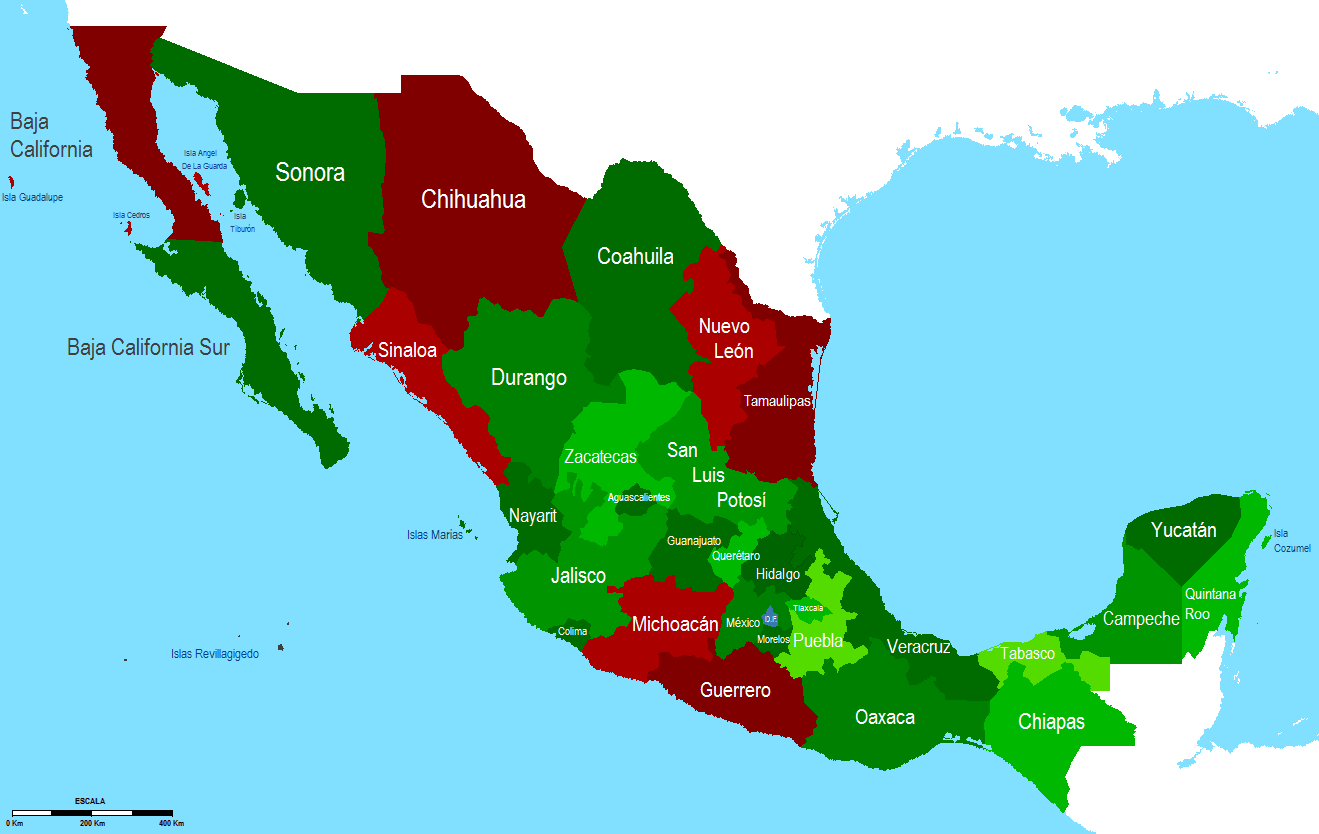 The states where most of the conflict took place in 2010, marked in red On December 11, 2006, newly elected President Felipe Calderón, from the PAN party, dispatched 6,500 Mexican Army soldiers to Michoacán, his home state, to end drug violence. This action is regarded as the first major deployment of government forces against cartels, and is generally viewed as the starting point of the Mexican drug war.[63] As time passed, Calderón continued to escalate his anti-drug campaign. By 2008, there were about 45,000 troops involved along with state and federal police forces.[64] The government was initially successful in detaining drug lords. Drug-related violence spiked markedly in contested areas along the U.S. border such as Ciudad Juárez, Tijuana, and Matamoros. Some analysts, including U.S. Ambassador in Mexico Carlos Pascual, argued that this rise in violence was a direct result of Felipe Calderón's military measures.[65] Since Calderón launched his military strategy against organized crime, there was an alarming increase in violent deaths related to organized crime: more than 15,000 people died in suspected drug cartel attacks since it was launched at the end of 2006.[65] More than 5,000 people were murdered in Mexico in 2008,[66] followed by 9,600 murders in 2009; 2010 saw more than 15,000 homicides across the country.[67] By the end of Calderón's presidency his administration statistics claimed that, during his 6-year term, 50,000 drug related homicides occurred.[68] Outside sources claimed more than 120,000 murders happened in the same period as result of his militaristic anti-drug policy.[69] Enrique Peña Nieto Main article: Enrique Peña Nieto § Presidency (2012–2018) 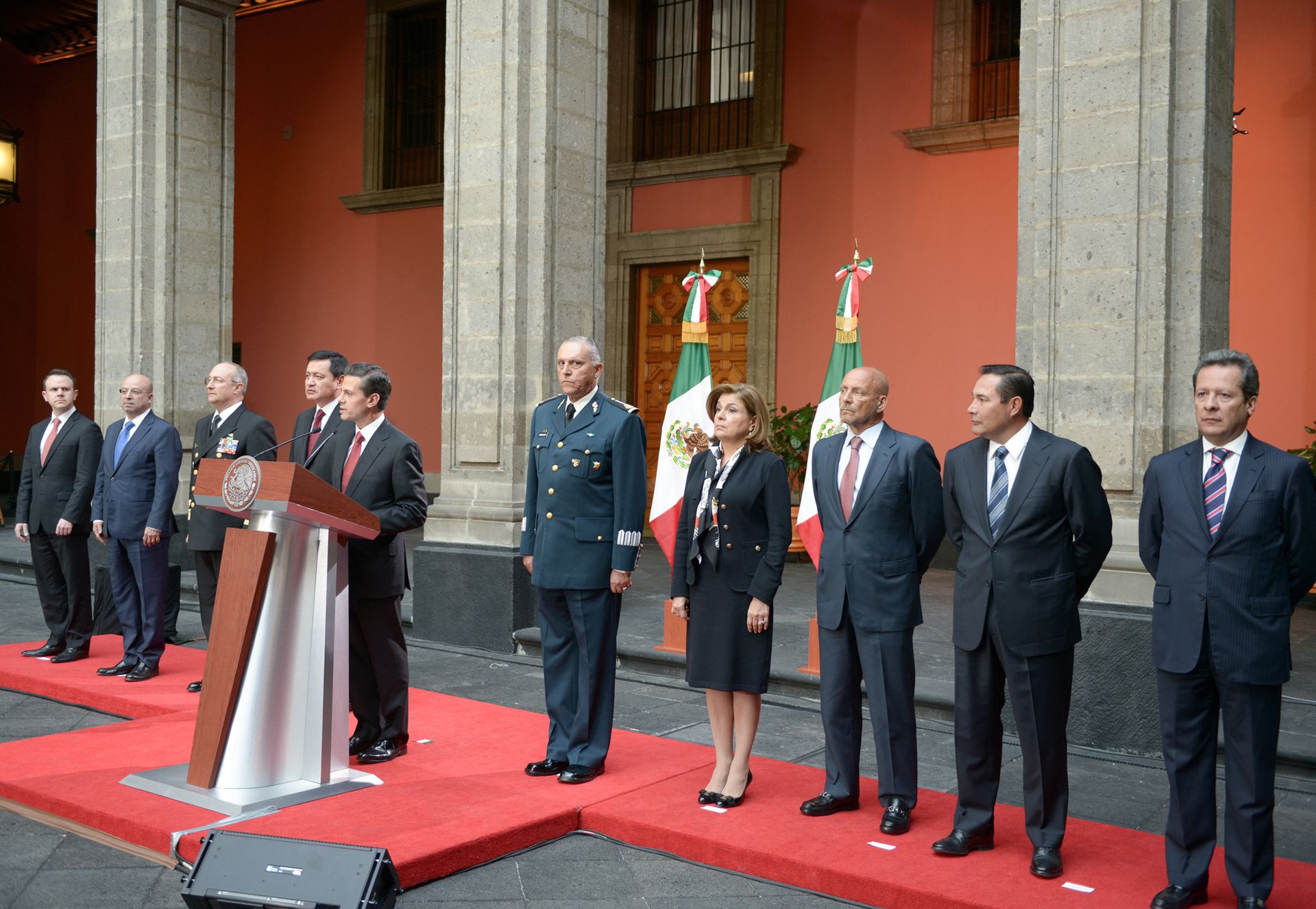 President Enrique Peña Nieto, accompanied by Cabinet members, holds a press conference in the Palacio Nacional announcing the capture of Joaquín Guzmán In 2012, newly elected president Enrique Peña Nieto, from the PRI party, emphasized that he did not support the involvement of armed American agents in Mexico and was only interested in training Mexican forces in counter-insurgency tactics.[70] Peña Nieto stated that he planned to deescalate the conflict, focusing in lowering criminal violence rates, as opposed to the previous policy of attacking drug-trafficking organizations by arresting or killing the most-wanted drug lords and intercepting their shipments.[71] In the first 14 months of his administration, between December 2012 and January 2014, 23,640 people died in the conflict.[72] In 2013 Mexico saw the rise of the controversial Grupos de Autodefensa Comunitaria (self-defence groups) in southern Mexico, para-military groups led by land-owners, ranchers and other rural inhabitants that took up arms against the criminal groups that wanted to impose dominance in their towns, entering a new phase in the Mexican war on drugs.[73] This strategy, allegedly proposed by General Óscar Naranjo, Peña Nieto's security advisor from Colombia,[74] crumbled when autodefensas started to have internal organization struggles and disagreements with the government, as well as infiltration by criminal elements, that deprived the government forces the ability to distinguish between armed-civilian convoys and drug-cartel convoys, forcing Peña Nieto's administration to distance from them.[75] Peña Nieto's handling of the 2014 Iguala mass kidnapping and the 2015 escape of drug lord Joaquín "El Chapo" Guzmán from the Altiplano maximum security prison sparked international criticism.[76][77] A great part of Peña Nieto's strategy consisted in making the Mexican Interior Ministry solely responsible for public security and the creation of a national military level police force called the National Gendarmerie. In December 2017, the Law of Internal Security was passed by legislation but was met with criticism, especially from the National Human Rights Commission, accusing it gave the President a blank check.[78][79][80][81] |
大統領 詳細は「制度的革命党」の項を参照 PRIは2000年まで約70年にわたってメキシコを支配した。この間、麻薬カルテルは勢力と政治的影響力を拡大し、麻薬対策は主に山岳地帯のマリファナ やアヘンの作物の破壊に重点が置かれていた。都市部における麻薬組織の中枢に対する大規模な軍事作戦は、2000年のメキシコ大統領選挙まで実施されな かった。この選挙で右派政党PANが大統領の座を獲得し、麻薬組織の縄張りに対する取り締まりを開始した。 ビセンテ・フォックス 詳細は「ビセンテ・フォックス大統領」を参照  2007年8月、ミチョアカン州での対峙の最中のメキシコ軍兵士  2010年8月、訓練中のメキシコ軍兵士 2000年、右派政党PANのビセンテ・フォックスが、メキシコ革命以来、PRI出身者以外で初めてメキシコ大統領となった。彼の任期は比較的平穏に経過 し、犯罪発生率はそれまでの政権とそれほど変わらなかった。メキシコ世論は 2000年から2007年にかけて殺人発生率が低下したことからも、メキシコ国民の世論は政権交代に概ね楽観的であった。[59] フォックス政権に対する最も強い批判のひとつは、サン・サルバドル・アテンコにおける農民の暴動に対する対応から生じた。 ヌエボ・ラレドを拠点とするシナロア・カルテルの武装部門であるロス・セタスは、2003年夏にはシナロア・カルテルに対する残虐な暴力と軍隊のような戦 術により、暴力を前例のないレベルにまでエスカレートさせた。[60] ロス・セタスはまた、ヌエボ・ラレドのジャーナリストや民間人にも恐怖を与えた。これは後にカルテルが模倣する新たな前例となった。[61] シナロア・カルテルの攻撃やタマウリパス州のガルフ・カルテルの主要地域への進出など、重要な紛争が起こっていたにもかかわらず、メキシコの犯罪組織によ るこれらの活動はメキシコのメディアでは広く報道されなかった。 2005年の最初の8か月間だけで、タマウリパス州ヌエボ・ラレドでは、ガルフ・カルテルとシナロア・カルテルの抗争により、約110人が死亡したと推定 されている。[62] 同年、ラ・ファミリア・ミチョアカン麻薬カルテルが、かつての同盟関係にあったガルフ・カルテルとロス・セタスから分裂した後、ミチョアカン州で再び暴力 が急増した。 フェリペ・カルデロン 詳細は「フェリペ・カルデロン」の項を参照  2010年に紛争のほとんどが起こった州は赤で示されている 2006年12月11日、新たに選出された PAN 党のフェリペ・カルデロン大統領は、麻薬絡みの暴力を終結させるため、6,500人のメキシコ陸軍兵士を自身の出身地であるミチョアカン州に派遣した。こ の行動は、麻薬カルテルに対する政府軍の初めての大規模展開と見なされており、一般的にメキシコ麻薬戦争の始まりと見なされている。[63] 時が経つにつれ、カルデロン大統領は麻薬撲滅キャンペーンをエスカレートさせていった。2008年までに、州警察および連邦警察と合わせて約45,000 人の軍が関与していた。[64] 当初、麻薬王の拘束には成功した。麻薬関連の暴力は、シウダー・フアレス、ティフアナ、マトモロスなど、米国との国境沿いの係争地域で著しく増加した。カ ルロス・パスカル駐メキシコ米国大使を含む一部のアナリストは、この暴力の増加はフェリペ・カルデロンの軍事措置の直接的な結果であると主張した。 [65] カルデロンが組織犯罪に対する軍事戦略を開始して以来、組織犯罪に関連する暴力的な死は驚くほど増加した。麻薬カルテルによる攻撃と見られる死者は、 2006年末に開始されて以来、麻薬カルテルによる攻撃と見られる事件で15,000人以上が死亡した。[65] 2008年にはメキシコで5,000人以上が殺害され[66]、2009年には9,600人が殺害された。2010年には、全国で15,000人以上が殺 害された。[67] カルデロン大統領の任期終了時までに、同政権の統計では、6年間の任期中に50,000件の麻薬関連殺人が発生したと主張している。[68] 外部の情報源では、同時期に軍事的な麻薬対策の結果、120,000件以上の殺人が発生したと主張している。[69] エンリケ・ペーニャ・ニエト 詳細は「エンリケ・ペーニャ・ニエト § 大統領職(2012年-2018年)」を参照  エンリケ・ペーニャ・ニエト大統領は閣僚を伴い、パシオ・ナシオナルでホアキン・グスマンの逮捕を発表する記者会見を行った 2012年、PRI党から新たに選出されたエンリケ・ペーニャ・ニエト大統領は、メキシコ国内における武装したアメリカ人エージェントの関与を支持しない ことを強調し、メキシコ軍の対反乱戦術の訓練にのみ関心があると述べた。[70] ペーニャ・ニエトは 麻薬密売組織の壊滅を目的とした、最重要指名手配犯である麻薬王の逮捕や殺害、麻薬密輸の阻止といったこれまでの政策とは対照的に、犯罪による暴力の減少 に焦点を当てて紛争の沈静化を図るつもりであると述べた。 2012年12月から2014年1月までの政権発足後14ヶ月間において、紛争による死者は23,640人に上った。 2013年には、メキシコ南部で物議を醸した自警団(自衛団)が台頭した。地主や牧場主、その他の農村住民が率いる準軍事組織で、自分たちの町を支配下に 置こうとする犯罪集団に対して武器を取った。これは、メキシコの麻薬戦争が新たな段階に入ったことを意味する。オスカル・ナランホ将軍が提案したとされる この戦略は、[74] 自警団が内部で組織闘争や政府との意見の相違が生じ、犯罪組織の浸透もあって瓦解し、政府軍は武装した民間人の護送と麻薬カルテルの護送を区別できなく なったため、ペーニャ・ニエト政権は自警団との距離を置くことを余儀なくされた。 2014年のイグアラでの集団誘拐事件と、2015年の麻薬王ホアキン・「エル・チャポ」・グスマンのアルティプラノ最大警備刑務所からの脱獄事件への ペーニャ・ニエトの対応は、国際的な批判を招いた。 ペーニャ・ニエト大統領の戦略の大部分は、メキシコ内務省に治安維持の責任を一任し、国民憲兵と呼ばれる国家軍レベルの警察組織を創設することにあった。 2017年12月、国内治安法が立法により可決されたが、特に国家人権委員会から批判が寄せられ、大統領に白紙小切手を渡したと非難された。[78] [79][80][81] |
| Andrés Manuel López Obrador Andrés Manuel López Obrador, the President from the Center-left National Regeneration Movement party, took office on December 1, 2018. One of his campaign promises was a controversial "strategy for peace", which would give amnesty to Mexicans involved in drug production and trafficking as a way to stop the drug trade and the resulting turf violence.[82] His aides explained that the plan was not to pardon real criminals, like violent drug cartel members, but to prevent other people from following that path, especially low-income people, farmers forced into drug cultivation by cartels, and young people that may end up in jail for drug possession.[83] Obrador pointed out that the past approaches failed because they were based on misunderstanding the core problem. According to him, the underlying issue was Mexico's great social disparities which previous governments' economic policies did not reduce. For law enforcement, he promised to hold a referendum for the creation of a temporary national guard, merging elite parts of the Federal police, Military police, Navy, Chief of Staff's Guard and other top Mexican Security agencies, intending to finally give a legal framework to the military grade forces that have been doing police work in the last years.[84] He promised not to use arms to suppress the people, and made an announcement to free political prisoners. His approach is to pay more attention to the victims of violent crime and he wants to revisit two previously taken strategies.[85] In 2019, the promised Mexican National Guard was created.[86] Despite the new government's planned strategy changes,[87] during the first two months of the new presidency the violence between drug trafficking organizations sustained the same levels as previous years.[88] On July 15, 2022 authorities captured Rafael Caro-Quintero, a former leader of the Guadalajara cartel, but lost fourteen soldiers in an aircraft crash in the remote mountains near Sinaloa's border with Chihuahua.[89] On January 30, 2019, Obrador declared the end of the Mexican war on drugs,[90] stating that he would now focus on reducing spending,[91] and direct its military and police efforts primarily on stopping the armed gasoline theft rings —locally called huachicoleros— that had been stealing more than 70 thousand barrels of oil, diesel and gasoline daily,[92][93][94] costing the Mexican state-owned company Pemex around 3 billion dollars every year.[95] On October 17, 2019, based on an extradition request sent to Mexico by a Washington, D.C. judge[96] a failed operation to capture alleged kingpin Ovidio Guzmán López was carried by the Mexican National Guard, in which fourteen people died (mostly from the armed forces and cartel enforcers and one civilian bystander).[97] Guzmán was released[98] after approximately 700 cartel enforcers,[99] armed with .50 caliber rifles, Rocket-propelled grenades (RPGs) and 40 mm grenades took multiple hostages, including the housing unit where military families live in Culiacan.[100] The cartels used burning vehicles to block roads, a tactic taken from militant protesters, with the event described as a mass insurrection.[101] Obrador defended the decision to release Ovidio Guzmán, arguing it prevented further loss of life,[102] and insisted that he wants to avoid more massacres.[103] He further stated that the capture of one drug smuggler cannot be more valuable than the lives of innocent civilians,[104] and that even though they underestimated the cartel's manpower and ability to respond[105] the criminal process against Ovidio is still ongoing,[106] During 2019, the federal forces deployed 8,000 troops and police reinforcements to restore peace in Culiacan.[99] This strategy of avoiding armed confrontations while drug organizations have continued violent altercations has been controversial.[107][88][108][109] One of the strongest critics of the new strategy and a firm proponent of continuing the armed struggle is former President Felipe Calderón, who originally started the military operations against traffickers in 2006.[110][111] Calderón's militaristic strategy to capture cartel heads has also been criticised by local and foreign experts, as well as by multiple media outlets.[112][113][114] President López Obrador, known for his strong criticism of the previous administrations' approach to public security through militarization, campaigned on the promise of removing the military from the streets and returning them to the barracks. However, under the López Obrador administration, deployments and military expenditures have reached unprecedented levels. The current number of soldiers deployed for security duties is 76% higher than during Felipe Calderón's presidency, whom López Obrador holds responsible for the militarization of the drug war. Consequently, defense spending has surged by 87% between 2012, Calderón's last year in office, and 2022.[115] Although the number of deployed soldiers is higher, available data indicates that they assume a more restrained role. They engage in fewer confrontations, seize fewer firearms, and prioritize non-confrontational strategies to deter criminals.[116] This has resulted in lower seizures of weapons and fewer arrests of alleged criminals.[117] Additionally, President López Obrador has broadened their duties, such as overseeing vaccine distribution and addressing irregular migration flows. |
アンドレス・マヌエル・ロペス・オブラドール 中道左派政党「国民再生運動」の党首であるアンドレス・マヌエル・ロペス・オブラドールは、2018年12月1日に大統領に就任した。選挙公約のひとつで あった「平和戦略」は物議を醸したが、これは麻薬取引とそれに伴う縄張り争いを阻止する方法として、麻薬の製造や密売に関与したメキシコ人に恩赦を与える というものだった。[82] 側近は、この計画は麻薬カルテルの暴力的なメンバーのような真の犯罪者を赦免するものではなく、 、他の人々がその道を歩むことを防ぐためであり、特に低所得者、麻薬カルテルに強制的に薬物の栽培をさせられている農民、薬物所持で刑務所行きになる可能 性のある若者たちであると説明した。[83] オブラドール氏は、過去の取り組みが失敗したのは、根本的な問題を誤解していたためだと指摘した。同氏によると、根底にある問題はメキシコの大きな社会格 差であり、それまでの政府の経済政策では縮小できなかったという。 法執行に関しては、連邦警察、軍警察、海軍、参謀本部警護部、その他のメキシコの主要治安機関の精鋭部隊を統合した臨時国家警備隊の創設に関する国民投票 を実施することを約束した。これにより、ここ数年警察業務を行ってきた軍事レベルの部隊に最終的に法的枠組みを与えることを意図している。[84] また、国民を武力で弾圧しないことを約束し、政治犯の釈放を発表した。彼の手法は、暴力犯罪の被害者により注意を払うというものであり、彼は以前に取られ た2つの戦略を再検討したいと考えている。[85] 2019年には、公約されていたメキシコ国民軍が創設された。[86] 新政権は戦略の変更を計画していたが[87]、新大統領就任後最初の2か月間、麻薬密売組織間の暴力は前年と同水準で推移した[88]。2022年7月 15日、当局はグアダラハラ・カルテルの元リーダー、ラファエル・カロ・キンテロを捕らえたが、シナロア州とチワワ州の州境近くの遠隔地の山で航空機が墜 落し、兵士14人が死亡した[89]。 2019年1月30日、オブラドールはメキシコの麻薬戦争の終結を宣言し、今後は支出削減に重点的に取り組むと述べた。また、軍と警察の取り組みを主に、 地元では「huachicoleros」と呼ばれる武装集団によるガソリンや軽油、ガソリンの盗難は、毎日7万バレル以上にも及び、メキシコ国営石油会社 ペメックス(Pemex)に毎年およそ30億ドルの損失を与えていた。 2019年10月17日、ワシントンD.C.の判事からメキシコに送られた身柄引き渡し要請に基づき[96]、麻薬カルテルのボスとされるオヴィディオ・ グスマン・ロペスを捕獲しようとした作戦が失敗し、メキシコ国家警備隊によって14人(ほとんどが軍とカルテルの実行犯、および1人の民間人の傍観者)が 死亡した。[9 7] グスマンは、カルテルの約700人の護衛者[99]が、.50口径ライフル、ロケット推進擲弾発射器(RPG)、40mm擲弾で武装し、クリアカンで軍人 の家族が住む住宅を含む複数の人質を取った後、釈放された[100]。カルテルは、道路を封鎖するために車両を燃やすという 。この戦術は過激派の抗議者から取り入れたもので、この事件は集団蜂起として描写された。[101] オブラドールは、オビディオ・グスマンの釈放の決定を擁護し、それによりさらなる犠牲者が出るのを防いだと主張し[102]、さらなる虐殺を避けたいと主 張した。[103] さらに、麻薬密売人の一人の逮捕が、罪のない市民の命よりも価値があるはずがないと述べた と述べ、麻薬カルテルの人員と対応能力を過小評価していたとしても[105]、オビディオに対する刑事訴訟は現在も継続中であると述べた[106]。 2019年、連邦軍はクリアカンに平和を回復するために8,000人の軍と警察を増派した。 麻薬組織が暴力沙汰を続けている間、武力衝突を回避するというこの戦略は、物議を醸している。[107][88][108][109] 新戦略の最も強力な批判者の一人であり、武力闘争の継続を強く主張しているのは、元大統領のフェリペ・カルデロンである。カルデロンは、 2006年に麻薬密売業者に対する軍事作戦を開始した人物である。カルデロン大統領の麻薬カルテルのボスを捕らえるための軍事的戦略は、国内外の専門家や 複数のメディアからも批判されている。 軍事化による治安対策を批判してきたロペス・オブラドール大統領は、軍を街から撤退させ兵舎に戻すことを公約に掲げていた。しかし、ロペス・オブラドール 政権下では、軍の展開と軍事支出は前例のないレベルに達している。麻薬戦争の軍事化の責任はフェリペ・カルデロン大統領にあるとロペス・オブラドール氏は 考えているが、治安維持任務に就く兵士の数は、カルデロン大統領時代よりも76%増加している。その結果、国防費はカルデロン大統領の最後の年である 2012年から2022年の間に87%増加した。[115] 配備された兵士の数は増えているが、入手可能なデータによると、彼らはより抑制された役割を担っている。彼らは対立を避け、銃器の押収も少なく、犯罪者を 抑止するための非対立的な戦略を優先している。[116] その結果、武器の押収数と犯罪容疑者の逮捕数が減少している。[117] さらに、ロペス・オブラドール大統領は、ワクチン配布の監督や不規則な移民の流れへの対応など、彼らの職務を拡大している。 |
| Drug sources and use Sources 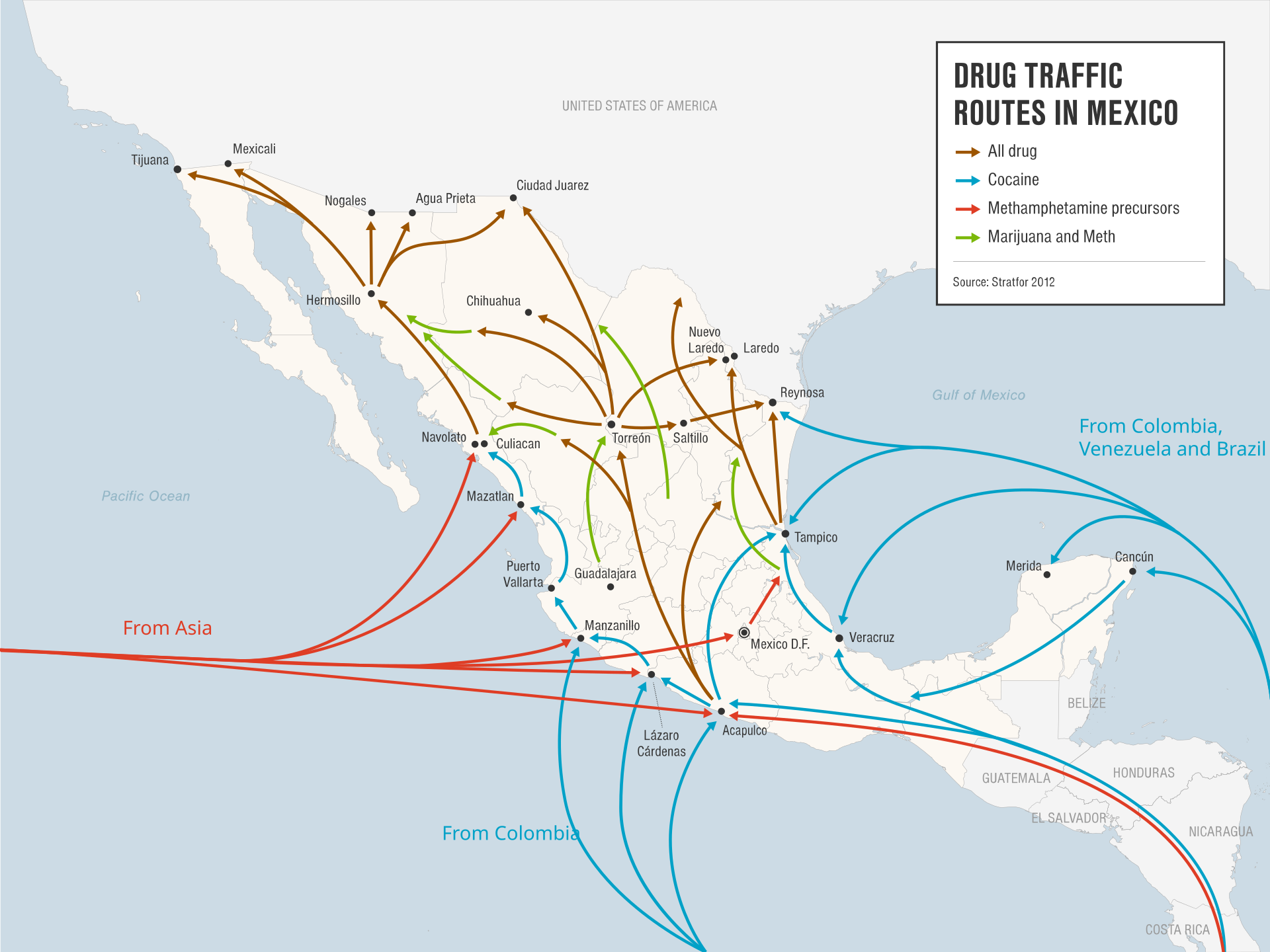 Map of Mexican cartels' drug traffic routes in Mexico based on a 2012 Stratfor report The U.S. State Department estimates that 90 percent of cocaine entering the United States is produced in Colombia[118] (followed by Bolivia and Peru)[119] and that the main transit route is through Mexico.[37] Drug cartels in Mexico control approximately 70% of the foreign narcotics flow into the United States.[120] Mexican cartels distribute Asian[121] methamphetamine to the United States.[37] It is believed that almost half the cartels' revenues come from cannabis.[122] Cocaine, heroin, and increasingly methamphetamine are also traded.[123] Although Mexico accounts for only a small share of worldwide heroin production, it supplies a large share of the heroin distributed in the United States.[124] Since 2003 Mexican cartels have used the dense, isolated portions of U.S. federal and state parks and forests to grow marijuana under the canopy of thick trees. Billions of dollars’ worth of marijuana has been produced annually on U.S. soil. "In 2006, federal and state authorities seized over 550,000 marijuana plants worth an estimated 1 billion dollars in Kentucky's remote Appalachian counties". Cartels profited from marijuana growing operations from Arkansas to Hawaii.[125] A 2018 study found that the reduction in drugs from Colombia contributed to Mexican drug violence. The study estimated, "between 2006 and 2009 the decline in cocaine supply from Colombia could account for 10%–14% of the increase in violence in Mexico."[126] Use Illicit drug use in Mexico is low compared to the United States, but is on the rise.[127] With Mexico's increased role in the trafficking and production of illicit drugs, the availability of drugs has slowly increased locally since the 1980s. In the decades before this period, consumption was not generalized – reportedly occurring mainly among persons of high socioeconomic status, intellectuals and artists.[128] As the United States of America is the world's largest consumer of cocaine,[129] as well as of other illegal drugs,[130] their demand is what motivates the drug business, and the main goal of Mexican cartels is to introduce narcotics into the U.S. The export rate of cocaine to the U.S. has decreased following stricter border control measures in response to the September 11 attacks.[128][131] This has led to a surplus of cocaine which has resulted in local Mexican dealers attempting to offload extra narcotics along trafficking routes, especially in border areas popular among North American tourists.[citation needed] Drug shipments are often delayed in Mexican border towns before delivery to the U.S., which has forced drug traffickers to increase prices to account for transportation costs of products across international borders, making it a more profitable business for the drug lords, and has likely contributed to the increased rates of local drug consumption.[128] With increased cocaine use, there has been a parallel rise in demand for drug user treatment in Mexico.[128] |
麻薬の供給源と使用 供給源  2012年のストラトフォー社の報告書に基づく、メキシコ国内のメキシコ麻薬カルテルの麻薬密売ルートの地図 米国務省は、米国に流入するコカインの90%はコロンビアで生産されていると推定している(次いでボリビア、ペルー)[119]。また、主な輸送ルートは メキシコを通過するものであると推定している[37]。メキシコの麻薬カルテルは、米国に流入する外国産麻薬の約70%を支配している[120]。 メキシコの麻薬カルテルはアジア製の[121] メタンフェタミンを米国に流通させている。[37] カルテルの収益のほぼ半分は大麻によるものと見られている。[122] コカイン、ヘロイン、そしてますますメタンフェタミンも取引されている。[123] メキシコは世界的なヘロイン生産量ではわずかな割合を占めるに過ぎないが、米国で流通するヘロインの大部分を供給している。[124] 2003年以降、メキシコの麻薬カルテルは、米国の連邦および州立公園や森林の密集した孤立した部分を利用して、木々の天蓋の下でマリファナを栽培してい る。数十億ドル相当のマリファナが毎年米国で生産されている。「2006年には、連邦および州当局がケンタッキー州の遠隔地にあるアパラチア郡で、推定 10億ドル相当の55万本以上のマリファナ植物を押収した」。アーカンソー州からハワイ州まで、麻薬カルテルが大麻栽培事業で利益を得ていた。[125] 2018年の研究では、コロンビアからの麻薬の減少がメキシコの麻薬暴力の要因となっていることが分かった。この研究では、「2006年から2009年の 間にコロンビアからのコカイン供給の減少が、メキシコの暴力増加の10%~14%を占めている可能性がある」と推定されている。[126] 使用 メキシコにおける違法薬物の使用は、米国と比較すると少ないが、増加傾向にある。[127] メキシコが違法薬物の密売と生産において果たす役割が大きくなるにつれ、1980年代以降、現地での薬物の入手可能性は徐々に高まっている。この数十年 間、消費は一般化されておらず、主に高い社会経済的地位を持つ人々、知識人、芸術家によって行われていると報告されている。[128] アメリカ合衆国はコカインの消費量が世界最大であり、[129] 他の違法薬物についても同様であるため、[130] その需要が麻薬ビジネスの原動力となっている。メキシコの麻薬カルテルの主な目的は、麻薬を米国に持ち込むことである。 米国へのコカインの輸出率は、9月11日の同時多発テロ事件を受けて国境管理が強化されたため減少した。[128][131] これによりコカインが余剰となり、地元のメキシコ人売人が麻薬密売ルートに沿って余剰麻薬を売却しようとするようになった。特に北米の観光客に人気の国境 地域でその傾向が顕著である。[要出典] 麻薬の密輸品は、米国への配送前にメキシコの国境沿いの町でしばしば遅延し、麻薬密売人は国際国境を越えた商品の輸送コストを考慮して価格を値上げせざる を得なくなり、麻薬王にとってより利益率の高いビジネスとなり、地元での麻薬消費量の増加に寄与している可能性が高い。 コカインの使用が増えるにつれ、メキシコでは麻薬常用者の治療に対する需要も平行して増加している。 |
| Poverty Main article: Poverty in Mexico One of the main factors driving the Mexican drug war is widespread poverty. From 2004 to 2008 the portion of the population who received less than half of the median income rose from 17% to 21% and the proportion of population living in extreme or moderate poverty rose from 35 to 46% (52 million persons) between 2006 and 2010.[132][133][134] Among the OECD countries, Mexico has the second highest degree of economic disparity between the extremely poor and extremely rich.[135] The bottom ten percent in the income hierarchy disposes of 1.36% of the country's resources, whereas the upper ten percent dispose of almost 36%. OECD also notes that Mexico's budgeted expenses for poverty alleviation and social development is only about a third of the OECD average.[133] In 2012 it was estimated that Mexican cartels employed over 450,000 people directly and a further 3.2 million people's livelihoods depended on various parts of the drug trade.[136] In cities such as Ciudad Juárez, up to 60% of the economy depended on illegal sources of income.[137] Education A problem that goes hand in hand with poverty in Mexico is the level of schooling.[138][139] In the 1960s, when Mexican narcotic smugglers started to smuggle drugs on a major scale,[38] only 5.6% of the Mexican population had more than six years of schooling.[140] More recently, researchers from the World Economic Forum have noted that despite the Mexican economy ranking 31st out of 134 economies for investment in education (5.3% of its GDP), as of 2009, the nation's primary education system is ranked only 116th, thereby suggesting "that the problem is not how much but rather how resources are invested".[141] The WEF further explained: "The powerful teachers union, the SNTE, the largest labor union in Latin America, has been in large part responsible for blocking reforms that would increase the quality of spending and help ensure equal access to education."[how?] The result of the high levels of poverty, lack of well paid jobs, government corruption, and the systemic failure of Mexico's schools has been the appearance of ninis, a youth underclass of school-dropouts who neither work nor study, who might have ended up as combatants on behalf of the cartels.[142][dubious – discuss] Teachers' unions have opposed reforms that propose their testing and grading on their students' performance[143] with standardized tests that do not take into account the socioeconomic differences between middle class urban schools and under-equipped poor rural schools, which has an important effect on the students performance.[144][145][146][147] Also, teachers unions have argued the legislation is ambiguous, focuses exclusively on teachers, without evaluating the Education Ministry, and will allow more abuses and political corruption.[148][149][150][151][152] |
貧困 詳細は「メキシコの貧困」を参照 メキシコ麻薬戦争の主な要因のひとつは広範囲にわたる貧困である。2004年から2008年の間に、中央値の半分以下の収入しか得ていない人口の割合は 17%から21%に増加し、極度の貧困または中程度の貧困に暮らす人口の割合は2006年から2010年の間に35%から46%(5200万人)に増加し た。[132][133][134] OECD諸国の中で、メキシコは極貧層と超富裕層との経済格差が2番目に大きい国である。[135] 収入階層の下位10%が国内資源の1.36%を占めているのに対し、上位10%はほぼ36%を占めている。OECDは、メキシコの貧困緩和と社会開発のた めの予算支出はOECD平均の3分の1程度であることも指摘している。[133] 2012年の推定では、メキシコの麻薬カルテルは45万人以上を直接雇用しており、さらに320万人の生活が麻薬取引の様々な部分に依存しているとされて いる。[136] シウダー・フアレスなどの都市では、経済の最大60%が違法な収入源に依存している。[137] 教育 メキシコにおける貧困と密接に関連する問題として、学校教育の水準が挙げられる。[138][139] メキシコの麻薬密売業者が麻薬の密輸を大規模に開始した1960年代には、メキシコ国民のわずか5.6%しか6年以上の学校教育を受けていなかった。 [140] さらに最近では、世界経済フォーラムの研究者が、2009年の時点で、メキシコの教育への投資(GDPの5.3%)は134か国中31位であるにもかかわ らず、同国の初等教育システムは116位にランクされていることを指摘し、「問題は投資額の多寡ではなく、その投資のされ方にある」と指摘している。 [141] WEFはさらに次のように説明している。「強力な教員組合であるSNTEはラテンアメリカ最大の労働組合であり、支出の質を高め、教育への平等なアクセス を確保する改革を妨げる大きな要因となっている」[どのように?] 高いレベルの貧困、高給の仕事不足、 政府の腐敗、メキシコの学校の組織的な失敗の結果、ニニス(ninis)と呼ばれる、学校を中退した若者階級が出現した。ニニスは働かず、学ばず、麻薬カ ルテルの戦闘員になる可能性もある。[142][疑わしい – 議論する] 教職員組合は、生徒の成績を基に教師を評価するという改革案に反対している。この改革案では、都市部の公立学校と設備の整っていない農村部の公立学校との 間の社会経済的な格差を考慮しない標準テストが用いられることになっているが、この格差は生徒の成績に重要な影響を及ぼしている。[144][ 145][146][147] また、教員組合は、この法案は曖昧であり、教育省を評価することなく教師だけに焦点を当てていると主張し、この法案により、さらに多くの虐待や政治腐敗が 許されることになると主張している。[148][149][150][151][152] |
| Mexican cartels Further information: List of Mexico's 37 most-wanted drug lords Origins Main article: Narcoculture in Mexico § Drug production in Mexico The birth of most Mexican drug cartels is traced to former Mexican Judicial Federal Police agent Miguel Ángel Félix Gallardo (Spanish: El Padrino, lit. 'The Godfather'), who founded the Guadalajara Cartel in 1980 and controlled most of the illegal drug trade in Mexico and the trafficking corridors across the Mexico–U.S. border along with Juan García Ábrego throughout the 1980s.[153] He started off by smuggling marijuana and opium into the U.S., and was the first Mexican drug chief to link up with Colombia's cocaine cartels in the 1980s. Through his connections, Félix Gallardo became the person at the forefront of the Medellín Cartel, which was run by Pablo Escobar.[154] This was accomplished because Félix Gallardo had already established a marijuana trafficking infrastructure that stood ready to serve the Colombia-based cocaine traffickers. There were no other cartels at that time in Mexico.[154]: 41 [154] He oversaw operations with his cronies and the politicians who sold him protection.[154] The Guadalajara Cartel suffered a major blow in 1985 when the group's co-founder Rafael Caro Quintero was captured, and later convicted, for the murder of DEA agent Enrique "Kiki" Camarena.[155][156] Félix Gallardo then kept a low profile and in 1987 he moved with his family to Guadalajara. According to Peter Dale Scott, the Guadalajara Cartel prospered largely because it enjoyed the protection of the Dirección Federal de Seguridad (DFS), under its chief Miguel Nazar Haro.[157] Félix Gallardo was arrested on April 8, 1989.[158] He then divested the trade he controlled as it would be more efficient and less likely to be brought down in one law enforcement swoop.[154]: 47 He sent his lawyer to convene the nation's top drug traffickers at a house in Acapulco where he designated plazas or territories.[154][159] The Tijuana route would go to his nephews the Arellano Felix brothers. The Ciudad Juárez route would go to the Carrillo Fuentes family. Miguel Caro Quintero would run the Sonora corridor. Meanwhile, Joaquín Guzmán Loera and Ismael Zambada García would take over Pacific coast operations, becoming the Sinaloa Cartel. Guzmán and Zambada brought veteran Héctor Luis Palma Salazar back into the fold. The control of the Matamoros, Tamaulipas corridor—then becoming the Gulf Cartel—would be left undisturbed to its founder Juan García Ábrego, who was not a party to the 1989 pact.[160] Félix Gallardo still planned to oversee national operations, as he maintained important connections, but he would no longer control all details of the business.[154] When he was transferred to a high-security prison in 1993, he lost any remaining control over the other drug lords.[161] |
メキシコの麻薬カルテル 詳細情報:メキシコの最重要指名手配麻薬王37人のリスト 起源 詳細は「メキシコの麻薬文化」の「メキシコの麻薬生産」を参照 メキシコの麻薬カルテルの多くは、元メキシコ司法連邦警察の捜査官ミゲル・アンヘル・フェリックス・ガルド(スペイン語名:エル・パドリーノ、直訳すると 「ゴッドファーザー」)に端を発する。彼は1980年にグアダラハラ・カルテルを設立し、1980年代を通じてフアン・ガルシア・アブレゴとともに、メキ シコ国内の違法麻薬取引のほとんどと、メキシコとアメリカ合衆国間の国境における麻薬密売ルートを支配していた 1980年代を通じて、フアン・ガルシア・アブレゴとともに、メキシコとアメリカ合衆国国境の麻薬密売ルートを支配した。[153] 彼はまずマリファナとアヘンをアメリカ合衆国に密輸し、1980年代にコロンビアのコカイン・カルテルとつながった最初のメキシコ人麻薬密売組織のボスと なった。そのコネクションを通じて、フェリックス・ガルドはパブロ・エスコバルが運営するメデジン・カルテルの最前線に立つ人物となった。これは、フェ リックス・ガルドがすでにコロンビアを拠点とするコカイン密売業者に協力するマリファナ密売のインフラを確立していたからこそ実現したことだった。 当時メキシコには他の麻薬カルテルは存在していなかった。[154]:41[154] 彼は取り巻きや、自身に保護を売り込む政治家たちとともに、業務を監督した。[154] 1985年、グアダラハラ・カルテルは、 共同創設者のラファエル・カロ・キンテロが逮捕され、後にDEA捜査官エンリケ・「キキ」・カマレナ殺害の罪で有罪判決を受けたことで、大きな打撃を受け た。[155][156] その後、フェリックス・ガラルドは表舞台から姿を消し、1987年には家族とともにグアダラハラに移住した。ピーター・デール・スコットによると、グアダ ラハラ・カルテルが繁栄したのは、ディレクション・フェデラル・デ・セグリダッド(DFS)の局長ミゲル・ナザール・ハロの庇護を受けていたからである。 フェリックス・ガルドは1989年4月8日に逮捕された。[158] その後、彼は、自分が管理していた麻薬取引から手を引き、そうすることで、一斉検挙で組織が壊滅する可能性を低くし、より効率的に事業を継続できるように した。[154]:47 彼は、アカプルコの自宅に、自分が指定した広場や地域ごとに、国民のトップ麻薬密売者を召集するために弁護士を派遣した。[154][159] ティフアナのルートは甥のアレジャーノ・フェリックス兄弟が担当することになった。シウダー・フアレスのルートはカリージョ・フエンテス一家が担当するこ とになった。ミゲル・カロ・キンテロはソノラ回廊を仕切ることになった。一方、ホアキン・グスマン・ロエラとイスマエル・サンバダ・ガルシアは太平洋沿岸 の業務を引き継ぎ、シナロア・カルテルとなった。グスマンとサンバーダはベテランのヘクター・ルイス・パルマ・サラザールを仲間に引き入れた。タマウリパ ス州マトマロス市の回廊の支配権は、当時ではガルフ・カルテルとなっていたが、創設者のフアン・ガルシア・アブレゴにそのまま委ねられた。彼は1989年 の協定の当事者ではなかった。 フェリックス・ガルドは、重要なコネクションを維持していたため、国民の活動を監督する立場にはあったが、もはやビジネスの詳細をすべて管理することはで きなかった。[154] 1993年に厳重警備の刑務所に移送されたことで、他の麻薬王に対する支配力を完全に失った。[161] |
| Major cartels in the war Main article: Drug cartel § Mexico Sinaloa Cartel Main article: Sinaloa Cartel Drug trafficking tunnel under the U.S.-Mexico border from Tijuana to Otay Mesa used by the Sinaloa Cartel The Sinaloa Cartel began to contest the Gulf Cartel's domination of the coveted southwest Texas corridor following the arrest of Gulf Cartel leader Osiel Cárdenas in March 2003. The "Federation" was the result of a 2006 accord between several groups located in the Pacific state of Sinaloa. The cartel was led by Joaquín "El Chapo" Guzmán, who was Mexico's most-wanted drug trafficker with an estimated net worth of U.S. $1 billion. This made him the 1140th richest man in the world and the 55th most powerful, according to his Forbes magazine profile.[162] He was arrested and escaped in July 2015,[163][164] and re-arrested in January 2016.[165] In February 2010, new alliances were formed against Los Zetas and Beltrán-Leyva Cartel.[166] Guzmán's lieutenant Alfredo Beltrán Leyva (arrested) The Sinaloa Cartel fought the Juárez Cartel in a long and bloody battle for control over drug trafficking routes in and around the northern city of Ciudad Juárez. The battle eventually resulted in defeat for the Juárez Cartel, resulting in the deaths of between 5,000 and 12,000 people.[167] During the war for the turf in Ciudad Juárez the Sinaloa Cartel used several gangs (e.g. Los Mexicles, the Artistas Asesinos and Gente Nueva) to attack the Juárez Cartel.[167] The Juárez Cartel similarly used gangs such as La Línea and the Barrio Azteca to fight the Sinaloa Cartel.[167] As of May 2010, numerous reports by Mexican and U.S. media stated that Sinaloa had infiltrated the Mexican federal government and military, and colluded with it to destroy the other cartels.[168][169] The Colima, Sonora and Milenio Cartels are now branches of the Sinaloa Cartel.[170] Joaquín "El Chapo" Guzmán was arrested on January 8, 2016, and extradited to the United States a year later. On February 4, 2019, in Brooklyn, NY, he was found guilty of ten counts of drug trafficking and sentenced to life imprisonment. Guzman unsuccessfully attempted to convince prosecutors that he has assumed charges on behalf of Ismael "El Mayo" Zambada[171] "El Chapo" alleged that he had paid former presidents Enrique Peña Nieto and Felipe Calderón bribes, which was quickly denied by both men.[172] In March 2019, El Chapo's successor, Ismael Zambada García, alias "El Mayo," was reported to be Mexico's "last Capo" and even more feared than his closest rival Nemesio Oseguera Cervantes, alias "El Mencho," who serves as leader of the Jalisco Cartel New Generation.[173] On January 5, 2023 the arrest of Ovidio Guzmán, son of jailed drug lord Joaquín 'El Chapo' Guzmán, sparked a wave of violence in the state of Sinaloa. The violence prompted the Mexican military to launch a series of armed raids using planes and helicopters to attack Sinaloa cartel members.[174] |
麻薬戦争における主要カルテル 詳細は「麻薬カルテル」の「メキシコ」を参照 シナロア・カルテル 詳細は「シナロア・カルテル」を参照 シナロア・カルテルが使用する、ティフアナからオタイ・メサまでのアメリカ・メキシコ国境下の麻薬密売トンネル シナロア・カルテルは、2003年3月にガルフ・カルテルのリーダー、オシエル・カルデナスが逮捕された後、ガルフ・カルテルが独占していたテキサス州南 西部の回廊の支配権を争うようになった。「連合」は、2006年に太平洋に面するシナロア州に位置する複数のグループ間で締結された協定の結果である。こ の麻薬カルテルは、メキシコで最も指名手配されている麻薬密売人で、純資産が10億米ドルと推定されるホアキン・「エル・チャポ」・グスマンが率いてい た。これにより、彼はフォーブス誌のプロフィールによると、世界で1140番目に裕福で、55番目に影響力のある人物となった。[162] 彼は2015年7月に逮捕され、脱走した。[163][ 2016年1月に再逮捕された。[165] 2010年2月には、ロス・セタスとベルトラン・レイバ・カルテルに対する新たな同盟が結成された。[166] グスマンの副官アルフレド・ベルトラン・レイバ(逮捕) シナロア・カルテルは、北部の都市シウダー・フアレスとその周辺における麻薬密売ルートの支配権を巡って、フアレス・カルテルと長期にわたる血みどろの抗 争を繰り広げた。この抗争は最終的にフアレス・カルテルの敗北に終わり、5,000人から12,000人の死者を出した。 例えば、ロス・メヒコレス、アティスタス・アセシノス、ヘンテ・ヌエバなど)を雇ってフアレス・カルテルを攻撃した。[167] フアレス・カルテルも同様に、ラ・リネアやバリオ・アステカなどのギャングを雇ってシナロア・カルテルと戦った。[167] 2010年5月現在、メキシコおよび米国のメディアによる多数の報道では、シナロア・カルテルはメキシコ連邦政府および軍に浸透し、他のカルテルを壊滅さ せるために共謀しているとされている。[168][169] コリマ・カルテル、ソノラ・カルテル、ミレニオ・カルテルは現在、シナロア・カルテルの支部である。[170] ホアキン・「エル・チャポ」・グスマンは2016年1月8日に逮捕され、1年後に米国に身柄が引き渡された。2019年2月4日、ニューヨーク州ブルック リンで、彼は麻薬密売10件の罪状を認め、終身刑を言い渡された。グスマンは、イスマエル・「エル・マヨ」・サムバダに代わって罪を被ったと検察官を説得 しようとしたが、失敗した。[171] 「エル・チャポ」は、エンリケ・ペーニャ・ニエトとフェリペ・カルデロンの両元大統領に賄賂を支払ったと主張したが、両者から即座に否定された。 [172] 2019年3月、 エル・チャポの後継者であるイスマエル・サムバダ・ガルシア(通称「エル・マヨ」)は、メキシコの「最後のカポ」であり、彼の最も近いライバルであるネメ シオ・オセグイラ・セルバンテス(通称「エル・メンチョ」)よりもさらに恐れられていると報告されている。エル・メンチョは、ハリスコ・カルテル・ ニュー・ジェネレーションのリーダーを務めている。 2023年1月5日、投獄されていた麻薬王ホアキン・「エル・チャポ」・グスマンの息子、オヴィディオ・グスマンの逮捕により、シナロア州で暴力の波が巻 き起こった。この暴力により、メキシコ軍はシナロア・カルテルのメンバーを攻撃するために、飛行機やヘリコプターを使用した一連の武装襲撃を開始した。 [174] |
| Beltrán-Leyva Cartel Main article: Beltrán-Leyva Cartel The Beltrán-Leyva Cartel was a Mexican drug cartel and organized crime syndicate founded by the four Beltrán Leyva brothers: Marcos Arturo, Carlos, Alfredo and Héctor.[175][176][177][178] In 2004 and 2005, Arturo Beltrán Leyva led powerful groups of assassins to fight for trade routes in northeastern Mexico for the Sinaloa Cartel. Through corruption or intimidation, the Beltrán-Leyva Cartel infiltrated Mexico's political,[179] judicial[180] and police institutions to feed classified information about anti-drug operations,[181][182] and even infiltrated the Interpol office in Mexico.[183] Following the December 2009 death of the cartel's leader Arturo Beltrán Leyva by Mexican Marines the cartel entered into an internal power struggle between Arturo's brother, Héctor Beltrán Leyva, and Arturo's top enforcer Edgar Valdez Villarreal.[6] Meanwhile, the cartel continued to dissolve with factions such as the South Pacific Cartel, La Mano Con Ojos, Independent Cartel of Acapulco, and La Barredora forming and the latter two cartels starting yet another intra-Beltrán Leyva Cartel conflict.[6] The Mexican Federal Police considers the cartel to have been disbanded,[184][185] and the last cartel leader, Héctor Beltrán Leyva, was captured in October 2014.[186] |
ベルトラン・レイバ・カルテル 詳細は「ベルトラン・レイバ・カルテル」を参照 ベルトラン・レイバ・カルテルは、マルコス・アルトゥーロ、カルロス、アルフレド、ヘクトルのベルトラン・レイバ4兄弟によって設立されたメキシコの麻薬 カルテルおよび組織犯罪シンジケートである。[175][176][177][178] 2004年と2005年には、アルトゥーロ・ベルトラン・レイバがシナロア・カルテルのためにメキシコ北東部の交易路を巡って暗殺者たちを率いて戦った。 ベルトラン・レイバ・カルテルは、汚職や脅迫により、メキシコの政治[179]、司法[180]、警察機関に浸透し、麻薬対策に関する機密情報を流し [181][182]、さらにはメキシコのインターポール事務所にまで浸透した[183]。 2009年12月にメキシコ海兵隊によって麻薬カルテルのリーダー、アルトゥーロ・ベルトラン・レイヴァが死亡した後、カルテルはアルトゥーロの弟である ヘクター・ベルトラン・レイヴァとアルトゥーロの右腕であったエドガー・ヴァルデス・ビジャレアルの間で内部抗争に突入した。[6] 一方、 、南太平洋カルテル、ラ・マノ・コン・オホス、アカプルコ独立カルテル、ラ・バレードラなどの派閥が形成され、後者の2つのカルテルがさらに別のベルトラ ン・レイヴァ・カルテル内紛争を開始するなど、カルテルは解体され続けた。 メキシコ連邦警察は、この麻薬カルテルは解散したと見ているが[184][185]、最後のカルテルのリーダーであるヘクター・ベルトラン・レイバは 2014年10月に逮捕された。[186] |
| Juárez Cartel Main article: Juárez Cartel The Juárez Cartel controls one of the primary transportation routes for billions of dollars' worth of illegal drug shipments annually entering the United States from Mexico.[187] Since 2007, the Juárez Cartel has been locked in a vicious battle with its former partner, the Sinaloa Cartel, for control of Ciudad Juárez. La Línea is a group of Mexican drug traffickers and corrupt Juárez and Chihuahua state police officers who work as the armed wing of the Juárez Cartel.[188] Vicente Carrillo Fuentes headed the Juárez Cartel until his arrest in 2014. Since 2011, the Juárez Cartel continues to weaken.[189][190] It is present in the three main points of entry into El Paso, Texas. The Juárez Cartel is only a shadow of the organization it was a decade ago, and its weakness and inability to effectively fight against Sinaloa's advances in Juarez contributed to the lower death toll in Juarez in 2011.[191] |
フアレス・カルテル 詳細は「フアレス・カルテル」を参照 フアレス・カルテルは、メキシコからアメリカ合衆国に毎年流入する数十億ドル相当の違法麻薬の主要な輸送ルートを支配している。[187] 2007年以降、フアレス・カルテルはシナロア・カルテルというかつてのパートナーと、シウダーフアレスの支配権を巡って熾烈な争いを繰り広げている。 ラ・ラインハは、メキシコの麻薬密売組織と、フアレスおよびチワワ州警察の汚職警官たちで構成され、フアレス・カルテルの武装部門として活動している。 [188] ビセンテ・カリージョ・フエンテスは、2014年に逮捕されるまでフアレス・カルテルを率いていた。 2011年以降、フアレス・カルテルは弱体化を続けている。[189][190] テキサス州エル・パソへの主要な3つの入口に存在している。フアレス・カルテルは10年前の組織の面影を残すのみであり、その弱体化とシナロアがフアレス に進出してきたことに対して効果的に戦う能力の欠如が、2011年のフアレスでの死者数の減少につながった。[191] |
| Tijuana Cartel Main article: Tijuana Cartel 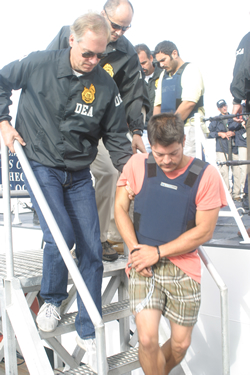 Francisco Javier Arellano Félix, the Tijuana Cartel drug lord was captured by the DEA The Tijuana Cartel, also known as the Arellano Félix Organization, was once among Mexico's most powerful.[192] It is based in Tijuana, one of the most strategically important border towns in Mexico,[193] and continues to export drugs even after weakening by an internal war in 2009. Due to infighting, arrests and the deaths of some of its top members, the Tijuana Cartel is a fraction of what it was in the 1990s and early 2000s, when it was considered one of the most potent and violent criminal organizations in Mexico by the police. After the arrest or assassination of various members of the Arellano Félix family, the cartel is currently allegedly headed by Edwin Huerta Nuño alias "El Flako". |
ティフアナ・カルテル 詳細は「ティフアナ・カルテル」を参照  ティフアナ・カルテルの麻薬王フランシスコ・ハビエル・アレジャーノ・フェリックスはDEAに逮捕された。 ティフアナ・カルテルは、アレジャーノ・フェリックス・オーガニゼーションとしても知られ、かつてはメキシコで最も強力な組織のひとつであった。 [192] メキシコで最も戦略的に重要な国境の町であるティフアナに拠点を置き、[193] 2009年の内紛により弱体化した後も麻薬の密輸を続けている。内部抗争や逮捕、幹部メンバーの一部の死亡により、ティフアナ・カルテルは1990年代か ら2000年代初頭の全盛期と比べると規模が縮小している。警察は、ティフアナ・カルテルをメキシコで最も強力かつ暴力的な犯罪組織のひとつとみなしてい た。アレジャーノ・フェリックス一家のさまざまなメンバーが逮捕または暗殺された後、現在、このカルテルはエドウィン・ウエルタ・ヌニョ(通称「エル・フ ラコ」)が率いているとされている。 |
| Gulf Cartel Main article: Gulf Cartel Mexican Army raids a Gulf Cartel's house in Matamoros, Tamaulipas, in 2012 The Gulf Cartel (CDG), based in Matamoros, Tamaulipas, has been one of Mexico's two dominant cartels in recent years. In the late 1990s, it hired a private mercenary army (an enforcer group now called Los Zetas), which in 2006 stepped up as a partner but, in February 2010, their partnership was dissolved, and both groups engaged in widespread violence across several border cities of Tamaulipas state,[166][194] turning several border towns into "ghost towns".[195] The CDG was strong at the beginning of 2011, holding off several Zetas incursions into its territory. As the year progressed, internal divisions led to intra-cartel battles in Matamoros and Reynosa, Tamaulipas state. The infighting resulted in several arrests and deaths in Mexico and in the United States. The CDG has since broken apart, and it appears that one faction, known as Los Metros, has overpowered its rival Los Rojos faction and is now asserting its control over CDG operations.[196] The infighting has weakened the CDG, but the group seems to have maintained control of its primary plazas, or smuggling corridors, into the United States.[196] The Mexican federal government has made notable successes in capturing the leadership of the Gulf Cartel. Osiel Cárdenas Guillén, his brothers Antonio Cárdenas Guillén, Mario Cárdenas Guillén, and Jorge Eduardo Costilla Sánchez have all been captured and incarcerated during Felipe Calderón's administration. |
ガルフ・カルテル 詳細は「ガルフ・カルテル」を参照 2012年、タマウリパス州マトモロスでメキシコ軍がガルフ・カルテルの家宅を急襲 タマウリパス州マトモロスを拠点とするガルフ・カルテル(CDG)は、近年メキシコで2大勢力を誇るカルテルのひとつである。1990年代後半には民間の 傭兵部隊(現在はロス・セタスと呼ばれる実行部隊)を雇い入れ、2006年にはパートナーとして提携を強化したが、2010年2月には提携関係を解消し、 両グループはタマウリパス州の複数の国境都市で広範囲にわたる暴力行為を展開し、いくつかの国境の町を「ゴーストタウン」と化した。 2011年初頭には、CDGは勢力を盛り返し、その縄張りへのゼータ・ギャングの侵入を何度か阻止した。年が進むにつれ、内部の分裂がタマウリパス州マト モロスとレイノサでのカルテル間の抗争へと発展した。この内紛により、メキシコおよび米国で複数の逮捕者と死者が出た。CDGはその後分裂し、ロス・メト ロスとして知られる一派がライバルのロス・ロハス派を圧倒し、現在ではCDGの活動の支配権を主張しているようだ。 内紛によりCDGは弱体化したが、このグループは米国への主要なプラザ(または密輸回廊)の支配を維持しているようである。[196] メキシコ連邦政府は、ガルフ・カルテルの指導者の逮捕に目覚ましい成功を収めている。オシエル・カルデナス・ギジェン、その兄弟のアントニオ・カルデナ ス・ギジェン、マリオ・カルデナス・ギジェン、ホルヘ・エドゥアルド・コスティージャ・サンチェスは、フェリペ・カルデロン政権下で全員逮捕され、投獄さ れた。 |
| Los Zetas Main article: Los Zetas 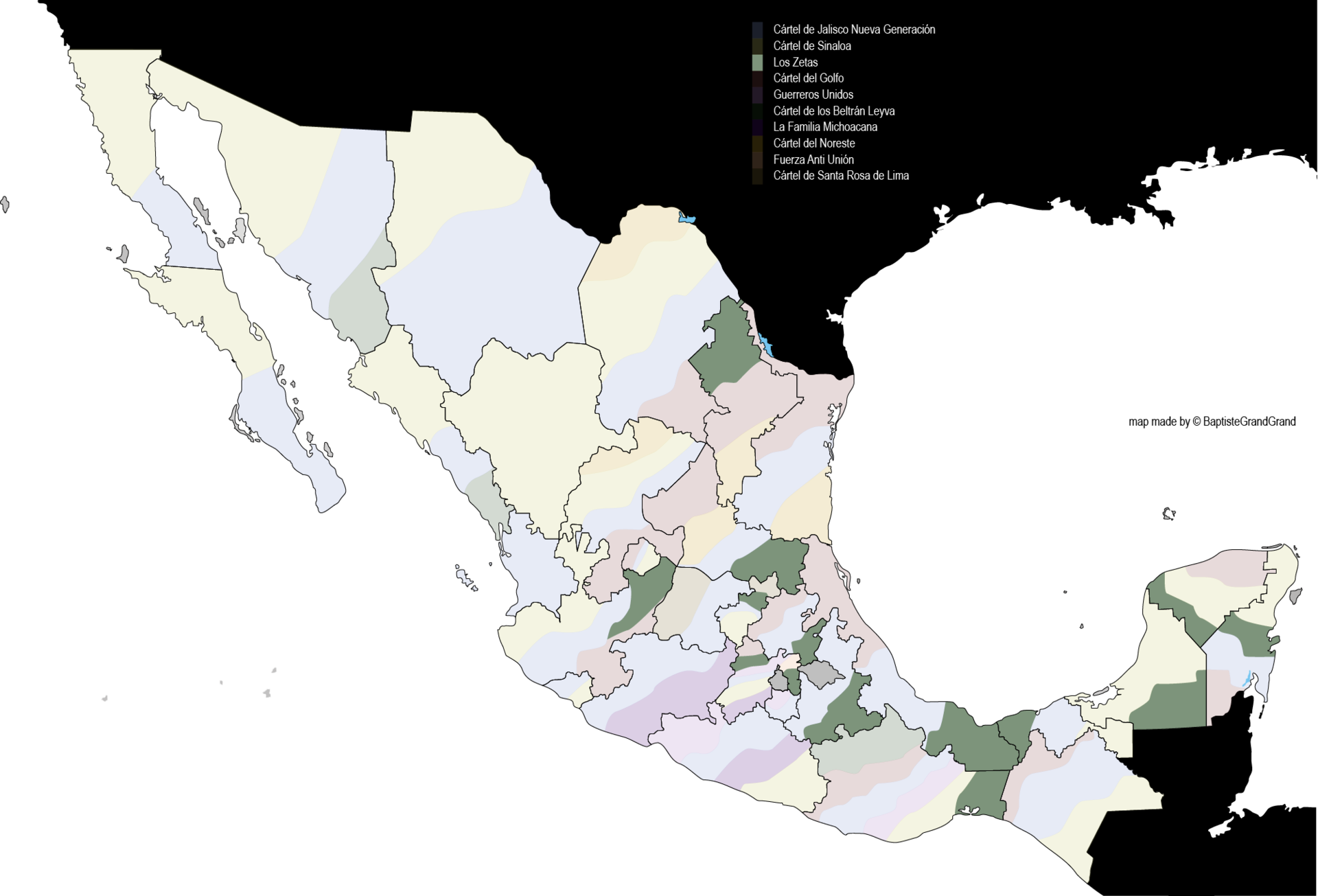 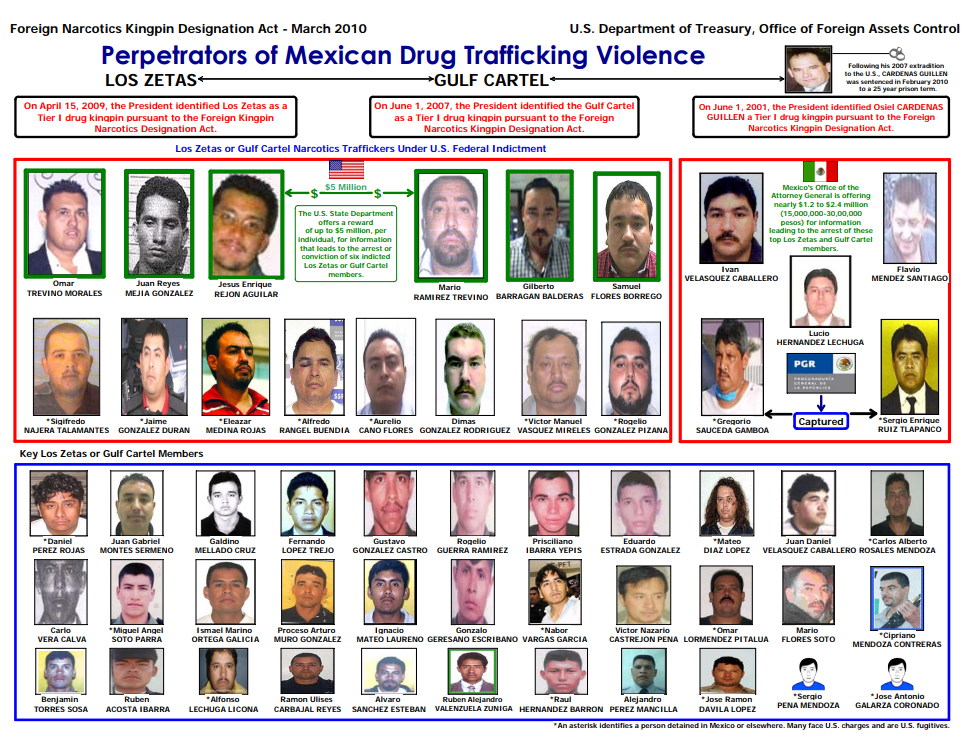 Leadership chart of the Gulf Cartel and Los Zetas issued by the U.S. Department of the Treasury, March 2010 In 1999, Gulf Cartel's leader, Osiel Cárdenas Guillén, hired a group of 37 corrupt former elite military soldiers to work for him. These former Airmobile Special Forces Group (GAFE), and Amphibian Group of Special Forces (GANFE) soldiers became known as Los Zetas and began operating as a private army for the Gulf Cartel. During the early 2000s the Zetas were instrumental in the Gulf Cartel's domination of the drug trade in much of Mexico. After the 2007 arrest and extradition of Osiel Cárdenas Guillén, the Zetas seized the opportunity to strike out on their own. Under the leadership of Heriberto Lazcano, the Zetas, numbering about 300, gradually set up their own independent drug, arms and human-trafficking networks.[197] In 2008, Los Zetas made a deal with ex-Sinaloa cartel commanders, the Beltrán-Leyva brothers and since then, became rivals of their former employer/partner, the Gulf Cartel.[166][198] In early 2010 the Zetas made public their split from the Gulf Cartel and began a bloody war with the Gulf Cartel over control of northeast Mexico's drug trade routes.[6] This war has resulted in the deaths of thousands of cartel members and suspected members. Furthermore, due to alliance structures, the Gulf Cartel-Los Zetas conflict drew in other cartels, namely the Sinaloa Cartel which fought the Zetas in 2010 and 2011.[6] The Zetas are notorious for targeting civilians, including the mass murder of 72 migrants in the San Fernando massacre.[6] The Zetas involved themselves in more than drug trafficking and have also been connected to human trafficking, pipeline trafficked oil theft, extortion, and trading unlicensed CDs.[6] Their criminal network is said to reach far from Mexico including into Central America, the U.S. and Europe.[6] On July 15, 2013, the Mexican Navy arrested the top Zeta boss Miguel Treviño Morales.[199] In recent times, Los Zetas have experienced severe fragmentation and seen its influence diminish.[200] As of December 2016, two subgroups calling themselves Los Zetas Grupo Bravo (Group Bravo) and Zetas Vieja Escuela (Old School Zetas) formed an alliance with the Gulf Cartel against a group known as El Cartel del Noreste (The Cartel of the Northeast).[201] |
ロス・セタス 詳細は「ロス・セタス」を参照   2010年3月、米国財務省が発表した湾岸カルテルとロス・セタスの指導者構成図 1999年、湾岸カルテルのリーダー、オシエル・カルデナス・ギジェンは、37人の堕落した元エリート軍人からなるグループを雇い入れた。これらの元空挺 特殊部隊(GAFE)および水陸両用特殊部隊(GANFE)の兵士たちはロス・セタスとして知られるようになり、湾岸カルテルの私設軍隊として活動を開始 した。2000年代初頭、ロス・セタスは湾岸カルテルによるメキシコの大部分における麻薬取引の独占に大きく貢献した。 2007年にオシエル・カルデナス・ギジェンが逮捕され、身柄が引き渡された後、ロス・セタスは単独で活動する好機を得た。ヘリベルト・ラスカノの指揮 下、約300人のメンバーを擁するゼータスは、徐々に独自の麻薬、武器、人身売買のネットワークを構築した。[197] 2008年、ロス・ゼータスは元シナロア・カルテルの司令官ベルトラン・レイバ兄弟と取引を行い、それ以来、かつての雇用主でありパートナーであったガル フ・カルテルのライバルとなった。[166][198] 2010年初頭、ロス・セタスはメキシコ湾カルテルとの決別を公表し、メキシコ北東部の麻薬取引ルートの支配を巡ってメキシコ湾カルテルとの血みどろの抗 争を開始した。[6] この抗争により、カルテルのメンバーおよび容疑者数千人が死亡した。さらに、同盟関係の構造により、ガルフ・カルテルとロス・セタスとの対立は、他のカル テル、すなわち2010年と2011年にセタスと戦ったシナロア・カルテルをも巻き込むこととなった。 セタスは、サン・フェルナンド虐殺事件における72人の移民の大量殺人を含む、民間人を標的にしたことで悪名高い。 ロス・セタスは麻薬密売以外にも、人身売買、パイプラインを流れる石油の窃盗、恐喝、無許可CDの売買などに関与している。彼らの犯罪ネットワークはメキ シコ国内にとどまらず、中米、米国、ヨーロッパにまで広がっていると言われている。 2013年7月15日、メキシコ海軍はロス・セタスのトップであるミゲル・トレビーニョ・モラレスを逮捕した。 最近では、ロス・セタスは深刻な分裂を経験し、その影響力は弱まっている。2016年12月現在、ロス・セタス・グルーポ・ブラボー(グループ・ブラ ボー)とゼタス・ビエハ・エスクエラ(オールドスクール・ゼタス)と名乗る2つのサブグループが、エル・カルテル・デル・ノルエステ(北東部カルテル)と して知られるグループに対して、メキシコ湾カルテルと手を組んでいる。[201] |
| La Familia Cartel Main article: La Familia Michoacana La Familia Michoacana was a major Mexican drug cartel based in Michoacán between at least 2006 and 2011. It was formerly allied to the Gulf Cartel and Los Zetas, but split off and became an independent organization.[202] 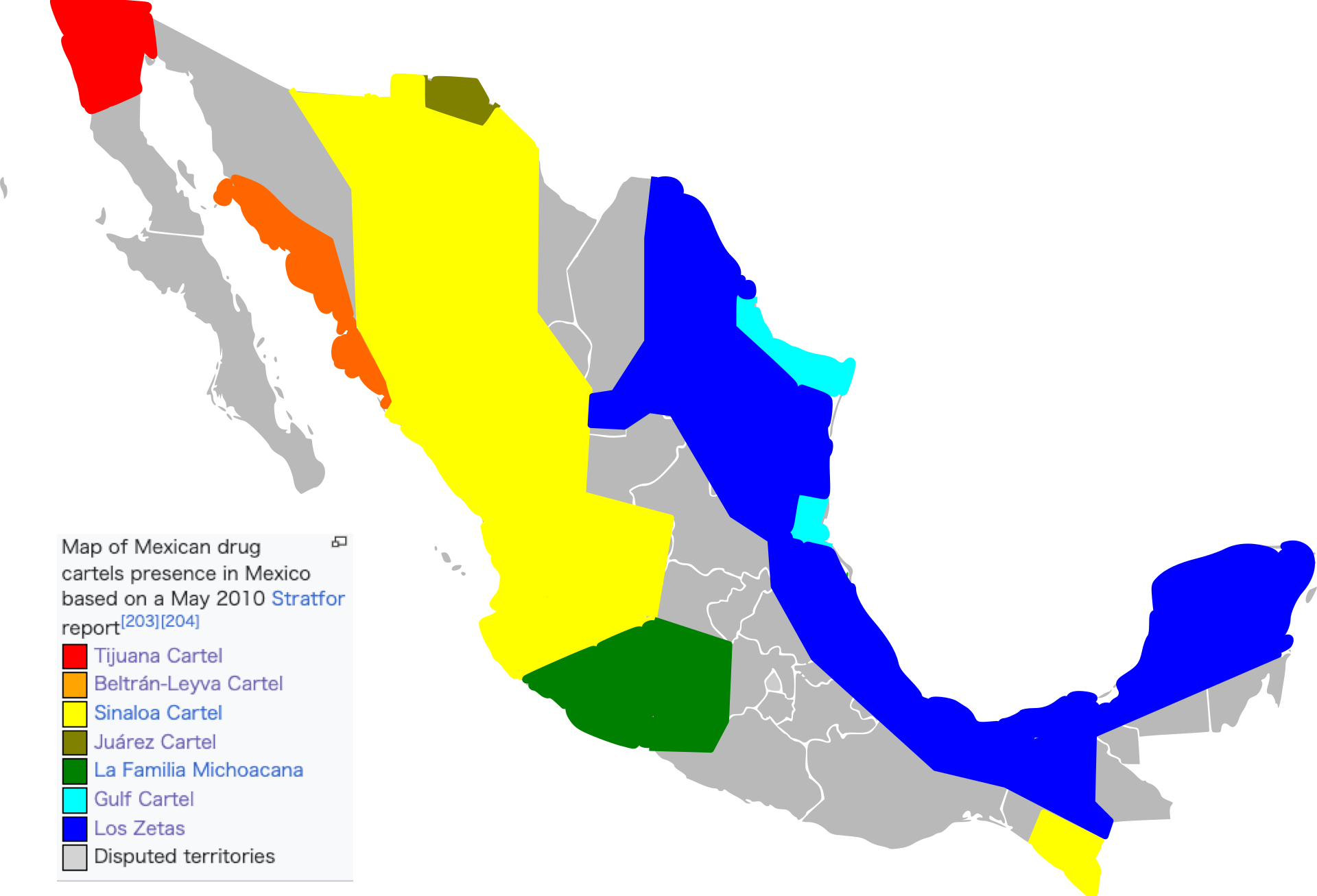 Map of Mexican drug cartels presence in Mexico based on a May 2010 Stratfor report[203][204] Tijuana Cartel Beltrán-Leyva Cartel Sinaloa Cartel Juárez Cartel La Familia Michoacana Gulf Cartel Los Zetas Disputed territories In 2009–10, a counter-narcotics offensive by Mexican and U.S. government agencies produced the arrest of at least 345 suspected La Familia members in the U.S., and the incorrectly presumed death[205] of one of the cartel's founders, Nazario Moreno González, on December 9, 2010.[6] The cartel then divided into the Knights Templar Cartel and a José de Jesús Méndez Vargas-led faction, which kept the name La Familia. Following the cartel's fragmentation in late 2010 and early 2011, the La Familia Cartel under Méndez Vargas fought the Knights Templar Cartel but on June 21, 2011, Méndez Vargas was arrested by Mexican authorities[6] and in mid-2011 the attorney general in Mexico (PGR) stated that La Familia Cartel had been "exterminated",[206] leaving only the splinter group, the Knights Templar Cartel.[207][208] In February 2010, La Familia forged an alliance with the Gulf Cartel against Los Zetas and Beltrán-Leyva Cartel.[166] |
ラ・ファミリア・カルテル 詳細は「ラ・ファミリア・ミチョアカン」を参照 ラ・ファミリア・ミチョアカンは、少なくとも2006年から2011年の間、ミチョアカン州を拠点としていたメキシコの主要麻薬カルテルである。かつては ガルフ・カルテルやロス・セタスと提携していたが、分裂して独立組織となった。  2010年5月のストラトフォー社の報告書に基づく、メキシコ国内における麻薬カルテルの勢力地図[203][204] ティフアナ・カルテル ベルトラン・レイバ・カルテル シナロア・カルテル フアレス・カルテル ラ・ファミリア・ミチョアカン ガルフ・カルテル ロス・セタス 係争地域 2009年から2010年にかけて、メキシコおよび米国の政府機関による麻薬対策の攻勢により、米国で少なくとも345人のラ・ファミリアの容疑者が逮捕 され、 2010年12月9日には、カルテルの創設者の1人であるナサリオ・モレノ・ゴンザレスが死亡したと推定されている。[6] その後、カルテルはテンプル騎士団カルテルとホセ・デ・ヘスス・メンデス・バルガス率いる派閥に分裂し、後者はラ・ファミリアの名称を維持した。2010 年末から2011年初頭にかけての麻薬カルテルの分裂後、メンデス・バルガス率いるラ・ファミリア・カルテルはテンプル騎士団カルテルと戦ったが、 2011年6月21日、メンデス・バルガスはメキシコ当局に逮捕された[ 6] 2011年半ばには、メキシコの検事総長(PGR)が、ラ・ファミリア・カルテルは「壊滅」し、[206] 残るは分派のテンプル騎士団カルテルのみであると述べた。[207][208] 2010年2月、ラ・ファミリアはロス・セタスとベルトラン・レイバ・カルテルに対抗して、湾岸カルテルと同盟を結んだ。[166] |
| Knights Templar Main article: Knights Templar Cartel The Knights Templar drug cartel (Spanish: Caballeros Templarios) was created in Michoacán in March 2011 after the death of the charismatic leader of La Familia Michoacana cartel, Nazario Moreno González.[209] The Cartel is headed by Enrique Plancarte Solís and Servando Gómez Martínez who formed the Knights Templar due to differences with José de Jesús Méndez Vargas, who had assumed leadership of La Familia Michoacana.[210] After the emergence of the Knights Templar, sizable battles flared up during the spring and summer months between the Knights Templar and La Familia.[6] The organization has grown from a splinter group to a dominant force over La Familia, and at the end of 2011, following the arrest of José de Jesús "El Chango" Méndez Vargas, leader of La Familia, the cartel appeared to have taken over the bulk of La Familia's operations in Mexico and the U.S.[6] In 2011 the Knights Templar appeared to have aligned with the Sinaloa Federation in an effort to root out the remnants of La Familia and to prevent Los Zetas from gaining a more substantial foothold in the Michoacán region of central Mexico.[211][212] Alliances or agreements between drug cartels have been shown to be fragile, tense and temporary. Mexican drug cartels have increased their co-operation with U.S. street and prison gangs to expand their distribution networks within the U.S.[44] On March 31, 2014, Enrique Plancarte Solís, a high-ranking leader in the cartel, was killed by the Mexican Navy. On September 6, 2016, a Mexican police helicopter was shot down by a gang, killing four people. The police were conducting an operation against criminal groups and drug cartels in Apatzingán, including the Knights Templar Cartel.[213] |
テンプル騎士団 詳細は「テンプル騎士団カルテル」を参照 テンプル騎士団麻薬カルテル(スペイン語: Caballeros Templarios) は、ラ・ファミリア・ミチョアカン・カルテルのカリスマ的指導者ナサリオ・モレノ・ゴンサレスの死後、2011年3月にミチョアカン州で結成された。 [209] このカルテルは、ラ・ファミリア・ミチョアカンを率いていたホセ・デ・ヘスス・メンデス・バルガスとの対立から、エンリケ・プランカルテ・ソリスとセル ヴァンド・ゴメス・マルティネスがテンプル騎士団を結成した。 テンプル騎士団の出現後、春から夏にかけて、テンプル騎士団とラ・ファミリアの間で大規模な戦闘が勃発した。[6] この組織は分裂派からラ・ファミリアを凌ぐ勢力へと成長し、2011年末にはラ・ファミリアのリーダー、ホセ・デ・ヘスス「エル・チャンゴ」メンデス・バ ルガスの逮捕により、 メキシコおよび米国におけるラ・ファミリアの活動の大半を掌握したようである。[6] 2011年には、テンプル騎士団はシナロア・フェデレーションと手を組み、ラ・ファミリアの残党を一掃し、ロス・セタスがメキシコ中央部のミチョアカン州 でより強固な足場を築くのを阻止しようとしているようである。[211][212] 麻薬カルテル間の同盟や合意は、もろく、緊張感があり、一時的なものであることが示されている。メキシコの麻薬カルテルは、米国における流通網を拡大する ために、米国のストリートギャングや刑務所内のギャングとの協力関係を強めている[44]。2014年3月31日、カルテルの幹部であるエンリケ・プラン カルテ・ソリスがメキシコ海軍によって殺害された。 2016年9月6日には、メキシコの警察ヘリコプターがギャングに撃墜され、4人が死亡した。警察はアパツィンガンの犯罪グループと麻薬カルテルに対する 作戦を実施しており、その中にはテンプル騎士団カルテルも含まれていた。[213] |
| CJNG Main article: Jalisco New Generation Cartel Area of influence map of the Jalisco New Generation Cartel in the United States as of 2017 The Jalisco New Generation Cartel (Spanish: Cártel de Jalisco Nueva Generación, CJNG, Los Mata Zetas and Los Torcidos)[214][215][216][217] is a Mexican criminal group based in Jalisco and headed by Nemesio Oseguera Cervantes ("El Mencho"), one of Mexico's most-wanted drug lords.[218] Jalisco New Generation Cartel started as one of the splits of Milenio Cartel, beside La Resistencia. La Resistencia accused CJNG of giving up Oscar Valencia (El Lobo) to the authorities and called them Los Torcidos (The Twisted Ones). Jalisco Cartel defeated La Resistencia and took control of Millenio Cartel's smuggling networks. Jalisco New Generation Cartel expanded its operation network from coast to coast in only six months, making it one of the criminal groups with the greatest operating capacity in Mexico as of 2012.[219] Through online videos, the Jalisco New Generation Cartel has tried to seek society's approval and tacit consent from the Mexican government to confront Los Zetas by posing as a "righteous" and "nationalistic" group.[220][221] Such claims have stoked fears that Mexico, just like Colombia a generation before, may be witnessing the rise of paramilitary drug gangs.[220] By 2018 the CJNG was hyped as the most powerful cartel in Mexico.[222][223][224] though Insight Crime has said the Sinaloa Cartel is still the most powerful cartel and called the CJNG its closest rival.[225][173] In 2019, the group was greatly weakened by infighting, arrests of senior operatives, and a war with the Sinaloa Cartel and its allies,[226] |
CJNG 詳細は「ハリスコ・ニュー・ジェネレーション・カルテル」を参照 2017年時点におけるハリスコ・ニュー・ジェネレーション・カルテルのアメリカ合衆国における影響力範囲の地図 ハリスコ・ニュー・ジェネレーション・カルテル(スペイン語: Cártel de Jalisco Nueva Generación、CJNG、Los Mata Zetas、Los Torcidos)は、[214][215][216][217] メキシコの犯罪組織で、ハリスコ州を拠点とし、メキシコで最も指名手配されている麻薬王の1人であるネメシオ・オセグーラ・セルバンテス(通称「エル・メ ンチョ」)が率いている。ハリスコ・ニュー・ジェネレーション・カルテルは、ラ・レジスタンスと並んで、ミレニオ・カルテルの分裂組織の1つとして始まっ た。ラ・レジスタンスはCJNGがオスカル・バレンシア(エル・ロボ)を当局に引き渡したと非難し、CJNGをロス・トルシードス(「歪んだ者たち」の 意)と呼んだ。ハリスコ・カルテルはラ・レジスタンスを打ち負かし、ミレニオ・カルテルの密輸ネットワークを掌握した。ハリスコ・ニュー・ジェネレーショ ン・カルテルは、わずか6ヶ月でその活動ネットワークをメキシコ全土に拡大し、2012年時点でメキシコ最大の活動能力を持つ犯罪グループのひとつとなっ た。[219] オンラインビデオを通じて、ハリスコ・ニュー・ジェネレーション・カルテルは「 正義の味方」や「愛国者」を装うことで、ロス・セタスに対抗するための社会の承認とメキシコ政府の暗黙の了解を得ようとしている。[220][221] このような主張は、メキシコが1世代前のコロンビアのように準軍事的な麻薬ギャングの台頭を目撃しているのではないかという懸念を煽っている。[220] 2018年までにCJNGはメキシコで最も強力なカルテルとして喧伝されたが、[222][223][ 224] しかし、インサイト・クライムは、シナロア・カルテルが依然として最も強力なカルテルであり、CJNGをその最も近いライバルと呼んでいる。[225] [173] 2019年には、内部抗争、幹部工作員の逮捕、シナロア・カルテルとその同盟勢力との戦争により、グループは大幅に弱体化した。[226] |
| Nueva Plaza Cartel Main article: Nueva Plaza Cartel CJNG co-founder Érick Valencia Salazar (alias "El 85") and former high-ranking CJNG leader Enrique Sánchez Martínez (alias "El Cholo") had also departed from the CJNG and formed a rival cartel known as the Nueva Plaza Cartel.[227][228][229] Since 2017, the cartel has been engaged in a war with the CJNG.[230] The Nueva Plaza Cartel has also become aligned with the Sinaloa Cartel to fight the CJNG.[227][228] |
ヌエバ・プラサ・カルテル 詳細は「ヌエバ・プラサ・カルテル」を参照 CJNGの共同創設者であるエリック・バレンシア・サラサール(通称「エル・85」)と、元CJNG幹部のエンリケ・サンチェス・マルティネス(通称「エ ル・チョロ」)もCJNGを離脱し、ヌエバ・プラサ・カルテルとして知られるライバル組織を結成した。 28][229] 2017年以降、このカルテルはCJNGと抗争を繰り広げている。[230] ヌエバ・プラサ・カルテルはシナロア・カルテルとも手を組み、CJNGと戦っている。[227][228] |
| Cartel propaganda and messaging Main article: Propaganda in the Mexican drug war Criminal organizations in Mexico are heavily involved in information warfare. These groups have a variety of tools they use to influence public opinion, such as food handouts, sponsoring of community development, social media posts, filmed press release-style video communications, physical narco messages, narco corridos, and private messaging such as WhatsApp chats. The goal of narco propaganda is to influence public opinion, threaten or accuse rivals, and generally communicate with those outside their organization.[231] Many cartels have controlled the information environment by threatening journalists, bloggers, and others who speak out against them. Their primary method of communication is the physical narco message, which can range from professionally-printed banners to hastily written messages on cardboard or paper. They are commonly displayed in public places, such as bridges, town centers, and highways. Many are often also left at crime scenes, such as after an assassination. Some cartels, such as the CJNG, have sophisticated propaganda arms capable of producing large numbers of professional styled narco messages to advance their interests. These messages use stock phrases or slogans, cartel logos, and have cohesive messaging.[232] In 2011, then President Felipe Calderón (2006–2012) met with Mexico's major media outlets to discuss their role in what he argued was sensationalizing the violence and providing free press coverage to cartels and their messages. They agreed to limit coverage of the drug war and the messaging of criminal groups.[233] |
カルテルの宣伝とメッセージ 詳細は「メキシコ麻薬戦争におけるプロパガンダ」を参照 メキシコの犯罪組織は、情報戦に深く関与している。これらのグループは、食料の配布、地域開発のスポンサー、ソーシャルメディアへの投稿、報道発表風のビ デオ通信、麻薬密売人からのメッセージ、ナルコ・コーリド、WhatsAppチャットなどのプライベートメッセージなど、世論に影響を与えるためにさまざ まな手段を用いている。麻薬カルテルのプロパガンダの目的は、世論に影響を与え、ライバルを脅迫したり非難したりし、一般的に組織外の人々とコミュニケー ションを取ることである。[231] 多くのカルテルは、自分たちに反対するジャーナリストやブロガー、その他の人々を脅迫することで、情報環境をコントロールしてきた。 麻薬カルテルの主なコミュニケーション手段は、麻薬密売のメッセージを物理的に伝えることである。メッセージは、専門業者に印刷を依頼した横断幕から、段 ボールや紙に急いで書かれたものまで、さまざまなものがある。メッセージは一般的に、橋や市街地、高速道路などの公共の場に掲示される。また、暗殺事件の 現場など、犯罪現場に残されることも多い。 CJNGなどの麻薬カルテルの中には、自分たちの利益を促進するために、プロ仕様の麻薬関連メッセージを大量に作成できる洗練された宣伝部門を持つものも ある。これらのメッセージは、決まり文句やスローガン、カルテルのロゴを使用し、一貫したメッセージ性を持っている。 2011年、当時の大統領フェリペ・カルデロン(2006~2012年)は、メキシコの主要メディアと会談し、暴力を扇情的に報道し、麻薬カルテルとその メッセージを無料で報道しているという主張について、その役割について話し合った。麻薬戦争の報道と犯罪グループのメッセージ発信を制限することで合意し た。[233] |
| Paramilitaries Paramilitary groups work alongside cartels to provide protection. This protection began with a focus on maintaining the drug trade, then moved to theft from other valuable industries such as oil and mining. It has been suggested that the rise in paramilitary groups coincides with a loss of security within the government. These paramilitary groups came about in a number of ways. First, waves of elite armed forces and government security experts have left the government to join the side of the cartels, responding to large bribes and an opportunity for wealth they may not have received in government positions. One such paramilitary group, Los Zetas, employed military personnel to create one of the largest groups in Mexico. Some of the elite armed forces members who join paramilitaries are trained in the Western Hemisphere Institute for Security Cooperation (WHINSEC, formerly known as the School of the Americas). One theory is that the paramilitaries have sprung out of deregulation of the Mexican army, which has been slowly replaced by private security firms.[234] Paramilitaries, including the Zetas, have now entered uncharted territories. Branching out of just protecting drug cartels, paramilitary groups have entered many other financially profitable industries, such as oil, gas, kidnapping, and counterfeiting electronics. There has been a complete and total loss of control by the government, and the only response has been to increase army presence, notably an army whose officials are often on the drug cartels payroll. The United States has stepped in to offer support in the "War on Drugs" through funding, training and military support, and transforming the Mexican judicial system to parallel the American system.[235] |
準軍事組織 準軍事組織は麻薬カルテルと協力して保護を提供している。この保護は当初、麻薬取引の維持に重点を置いていたが、その後、石油や鉱業などの他の価値ある産 業からの窃盗へと移行した。準軍事組織の増加は、政府内の治安維持力の低下と一致しているという指摘がある。これらの準軍事組織は、さまざまな経緯で誕生 した。まず、精鋭の軍人や政府の安全保障の専門家たちが、多額の賄賂や政府の役職では得られないような富を得る機会に惹かれて、政府を離れ、カルテルの側 に寝返った。そのような準軍事組織のひとつであるロス・セタスは、軍人を採用してメキシコ最大の組織のひとつを作り上げた。準軍事組織に参加するエリート 軍人の一部は、米州安全保障協力機構(WHINSEC、旧称米州学校)で訓練を受けている。一つの説によると、準軍事組織は、徐々に民間の警備会社に置き 換えられてきたメキシコ軍の規制緩和から発生したという。[234] ゼータスを含む準軍事組織は、今、未知の領域に足を踏み入れている。麻薬カルテルの保護から手を広げ、準軍事組織は、石油、ガス、誘拐、電子機器の偽造な ど、多くの他の金銭的に有益な産業に参入している。政府による統制は完全に失われ、唯一の対応策は軍の存在を増やすことだったが、その軍の役人の多くは麻 薬カルテルから給与を受け取っている。米国は「麻薬との戦い」に資金援助、訓練、軍事支援を行い、メキシコの司法制度を米国の制度に合わせる形で変革する ことで支援を行っている。[235] |
| Women Main article: Women in the Mexican drug war Women in the Mexican drug war have been participants and civilians. They have served for and/or been harmed by all belligerents. There have been female combatants in the military, police, cartels, and gangs.[236][237] Women officials, judges, prosecutors, lawyers, paralegals,[238] reporters, business owners, social media influencers, teachers, and non-governmental organizations directors and workers have also been involved in different capacities.[239] Women citizens and foreigners, including migrants,[240] have been raped,[241][242] tortured,[243][244] and murdered in the conflict.[245][246][247][248][249] Women's involvement in the cartel is noticeably less than males, but they do play an important role nonetheless. Often, because no one would suspect a woman to commit such a serious crime, it makes them the perfect smuggler. Women smugglers could drive up to a checkpoint with a car full of drugs, and more often than not, no one would suspect them of anything. [250] Women may find allure in a criminal lifestyle for the sense of freedom. Mexico already has a male-dominated culture, but by working in the drug trade, they can be empowered and even liberated. If women cannot obtain freedom through legal means, then it is possible they will use illegal avenues to achieve the same goal.[251] Cartels and gangs fighting in the conflict carry out sex trafficking in Mexico as an alternative source of profits.[252][253][254][255] Some members of the criminal organizations also abduct women and girls to use as their personal sex slaves[252] and carry out sexual assault of migrants from Latin America to the United States.[256] |
女性 詳細は「メキシコ麻薬戦争における女性」を参照 メキシコ麻薬戦争における女性は、戦闘員や民間人として参加している。彼女たちは、すべての交戦勢力のために奉仕し、また被害を受けている。軍、警察、麻 薬カルテル、ギャングには女性戦闘員がいる。[236][237] 女性公務員、裁判官、検察官、弁護士、パラリーガル、[238] 記者、企業経営者、ソーシャルメディアのインフルエンサー、教師、非政府組織の役員や職員も、 さまざまな形で関与している。女性市民や外国人(移民を含む)は、この紛争でレイプされ[241][242]、拷問され[243][244]、殺害されて いる[245][246][247][248][249]。 麻薬カルテルへの女性の関与は男性よりも顕著に少ないが、それでも重要な役割を果たしている。女性がそのような重大な犯罪を犯すとは誰も疑わないため、女 性は完璧な密輸業者となることが多い。女性密輸業者は、麻薬を満載した車で検問所まで運転してくるが、ほとんどの場合、誰も彼女たちを疑うことはない。 [250] 女性たちは、犯罪者としての生き方に自由という魅力を感じているのかもしれない。メキシコはすでに男性優位の文化であるが、麻薬取引に携わることで、女性 たちは力を得、解放感さえ味わうことができる。女性たちが合法的な手段で自由を得ることができないのであれば、同じ目標を達成するために非合法な手段に訴 える可能性もある。 紛争に関与しているカルテルやギャングは、利益の代替源としてメキシコで人身売買を行っている。[252][253][254][255] 犯罪組織のメンバーの中には、女性や少女を誘拐し、個人的な性奴隷として利用したり[252]、ラテンアメリカから米国への移民に対する性的暴行を行った りする者もいる。[256] |
| Firearms Smuggling of firearms Main article: Smuggling of firearms into Mexico See also: Gun politics in Mexico  AK-47 (locally called сuerno de chivo, Spanish for "goat horn", for its curved magazine)  M4 carbine with grenade launcher (locally called сhanate, Mexican Spanish for "great-tailed grackle") 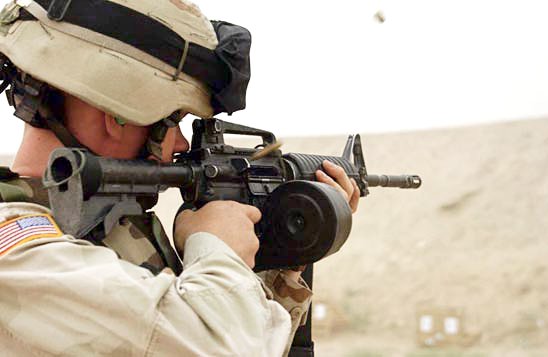 Beta C-Mag double drum magazine (locally called huevos de toro, Spanish for "bull testicles") on an M4 carbine 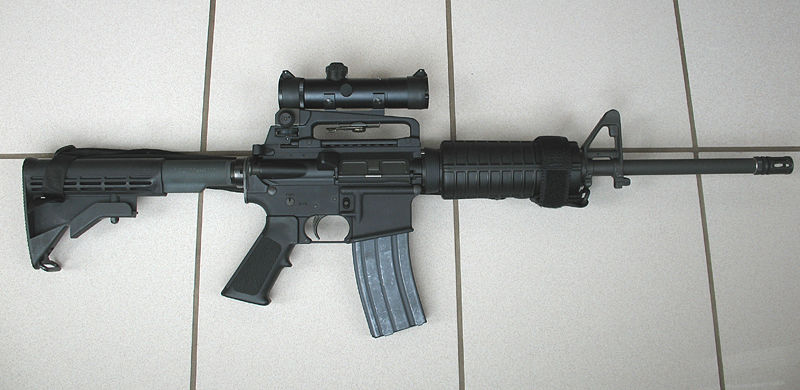 Colt AR-15 A3 tactical carbine Mexicans have a constitutional right to own firearms,[257] but legal purchase from the single Mexican gun shop in Mexico City is extremely difficult.[258] Firearms that make their way to Mexico come primarily from the American civilian market.[259][260] Most grenades and rocket-launchers are smuggled through Guatemalan borders, as leftovers from past conflicts in Nicaragua.[261] Some grenades are also smuggled from the U.S. to Mexico[262] or stolen from the Mexican military.[263] The most common weapons used by the cartels are the AR-15, M16, M4, AK-47, AKM and Type 56 assault rifles. Handguns are very diverse, but the FN Five-seven (dubbed Matapolicías or Cop-killer by criminals)[264] is a popular choice due to its armor-piercing capability.[265] Grenade launchers are known to have been used against Mexican security forces, while H&K G36s and M4 carbines with M203 grenade launchers have been confiscated. Gun origins See also: Project Gunrunner and ATF gunwalking scandal Some researchers have asserted that most weapons and arms trafficked into Mexico come from gun dealers in the United States. There is strong evidence for this conclusion, and there is a geographic coincidence between the supposed American origin of the firearms and the places where these weapons are seized, mainly in the northern Mexican states.[266] Most grenades and rocket-launchers are smuggled through Guatemalan borders from Central America.[261] Some grenades are also smuggled from the US to Mexico[262] or stolen from the Mexican military.[263] United States Department of Homeland Security (DHS) officials have stated that the statistic is misleading: out of approximately 30,000 weapons seized in drug cases in Mexico in 2004–2008, 7,200 appeared to be of U.S. origin, approximately 4,000 were found in ATF manufacturer and importer records, and 87 percent of those—3,480—originated in the United States.[267][268] In an effort to control smuggling of firearms, the U.S. government is assisting Mexico with technology, equipment and training.[269] Project Gunrunner was one such effort between the U.S. and Mexico to collaborate in tracing Mexican guns which were manufactured in or imported legally to the U.S.[270] In 2008, it was falsely reported that ninety percent of arms either captured in Mexico or interdicted were from the United States. The DHS and others have dismissed these claims, pointing that the Mexican sample submitted for ATF tracing is the fraction of weapons seized that appear to have been made in the U.S. or imported into the U.S.[267][268] In 2015, official reports of the U.S. government and the Bureau of Alcohol, Tobacco, Firearms and Explosives (ATF) revealed that over the last years, Mexican cartels improved their firearm power, and that 71% of their weapons come from the U.S. Many of those guns were manufactured in Romania and Bulgaria, and then imported into the U.S. The Mexican cartels acquire those firearms mainly in the southern states of Texas, Arizona and California. After the United States, the top five countries of origin of firearms seized from Mexico were Spain, China, Italy, Germany and Romania. These five countries represent 17% of firearms smuggled into Mexico.[271] Some cartels such as the Beltrán Leyva Cartel use counterfeit M16s made with aftermarket parts.[272] |
銃器 銃器の密輸 詳細は「メキシコへの銃器の密輸」を参照 関連項目:メキシコの銃規制  AK-47(マガジンが湾曲していることから、スペイン語で「ヤギの角」を意味する「Cuerno de chivo」と呼ばれる  M4カービンにグレネードランチャーを装着したもの(メキシコ・スペイン語で「オオクロムクドリモドキ」を意味する「chanate」と呼ばれる  M4カービンにベータC-Magダブルドラムマガジン(スペイン語で「雄牛の睾丸」を意味する「huevos de toro」と呼ばれる)を装着したもの  コルトAR-15 A3タクティカルカービン メキシコ国民には憲法で定められた銃器所有の権利があるが[257]、メキシコシティにあるメキシコ唯一の銃器販売店からの合法的な購入は極めて困難であ る[258]。メキシコに流入する銃器のほとんどは、主に米国の民間市場からである[259][260]。手榴弾やロケットランチャーの多くは、ニカラグ アでの過去の紛争の残滓として、グアテマラ国境から密輸されている。[261] また、一部の手榴弾は米国からメキシコに密輸されたもの[262]や、メキシコ軍から盗まれたものもある。[263] 麻薬カルテルが使用する武器で最も一般的なのは、AR-15、M16、M4、AK-47、AKM、56式アサルトライフルである。拳銃は多種多様である が、FN Five-seven(犯罪者からは「警官殺し」または「警官殺し」という異名を持つ)は、その徹甲能力により人気がある。[264][265] グレネードランチャーはメキシコ治安部隊に対して使用されたことが知られている。一方、H&K G36とM4カービンにM203グレネードランチャーを搭載したものは没収されている。 銃の起源 関連項目:プロジェクト・ガンランナーとATFの銃密売疑惑 一部の研究者は、メキシコに密輸された武器や兵器のほとんどは、米国の銃販売業者から出所していると主張している。この結論には有力な証拠があり、銃器の 出所とされる地域と、主にメキシコ北部の州で押収された武器の押収場所との間には、地理的な一致がある。[266] ほとんどの手榴弾とロケットランチャーは、中米からグアテマラ国境を通って密輸されている。[261] 一部の手榴弾は 米国からメキシコに密輸されたものもある[262]ほか、メキシコ軍から盗まれたものもある[263]。米国国土安全保障省(DHS)当局者は、この統計 は誤解を招く可能性があると述べている。2004年から2008年の間にメキシコで麻薬事件に関連して押収された武器約3万丁のうち、 7,200丁は米国製であるように見え、約4,000丁はアルコール・タバコ・火器管理局(ATF)の製造業者および輸入業者の記録から発見され、そのう ちの87パーセントにあたる3,480丁は米国製であった。[267][268] 銃器の密輸を抑制するために、米国政府はメキシコに技術、設備、訓練の支援を行っている。[269] プロジェクト・ガンランナーは、米国で合法的に製造または輸入されたメキシコ製銃器の追跡において、米国とメキシコが協力する取り組みの1つであった。 [270] 2008年には、メキシコで押収された武器または差し止められた武器の90%が米国製であると誤って報道された。DHSおよびその他の機関は、ATFによ る追跡のために提出されたメキシコのサンプルは、米国で製造されたか米国に輸入されたと思われる武器の押収品の一部であると指摘し、これらの主張を退けて いる[267][268] 2015年、米国政府およびアルコール・タバコ・火器及び爆発物局(ATF)の公式報告書は、ここ数年間にメキシコの麻薬カルテルが銃器の力を向上させ、 その武器の71%が米国から流入していることが明らかになった。それらの銃の多くはルーマニアやブルガリアで製造され、米国に輸入されている。メキシコの 麻薬カルテルは主にテキサス州、アリゾナ州、カリフォルニア州といった南部の州でそれらの銃器を入手している。米国に次いでメキシコから押収された銃器の 主な供給国は、スペイン、中国、イタリア、ドイツ、ルーマニアの5カ国である。これら5カ国からメキシコに密輸された銃器は、メキシコに押収された銃器の 17%を占めている。[271] ベルトラン・レイバ・カルテルなどの一部のカルテルは、アフターマーケットパーツを使用して製造された偽造M16を使用している。[272] |
| Project Gunrunner Main articles: Project Gunrunner and ATF gunwalking scandal ATF Project Gunrunner has stated that the official objective is to stop the sale and export of guns from the United States into Mexico in order to deny Mexican drug cartels the firearms considered "tools of the trade".[273] In February 2011, it brought about a scandal when the project was accused of accomplishing the opposite by ATF permitting and facilitating "straw purchase" firearm sales to traffickers, and allowing the guns to "walk" and be transported to Mexico. Allegedly, the ATF allowed to complete the transactions to expose the supply chain and gather intelligence.[274][275] It has been established that this operation violated long-established ATF policies and practices and that it is not a recognized investigative technique.[276] Several of the guns sold under the Project Gunrunner were recovered from crime scenes in Arizona,[277] and at crime scenes throughout Mexico,[278] resulting in considerable controversy.[279][280][281] One notable incident was the "Black Swan operation" where Joaquín Guzmán Loera was finally captured. The ATF confirmed that one of the weapons the Mexican Navy seized from Guzmán's gunmen was one of the many weapons that were "lost" during the Project Gunrunner.[282] Many weapons from Project Gunrunner were found in a secret compartment in the "safe house" of José Antonio Marrufo "El Jaguar", one of Guzmán's most sanguinary lieutenants. He is accused of many killings in Ciudad Juárez, including the notorious massacre of 18 patients at a "El Aliviane" rehabilitation center. It is believed that Marrufo armed his gunmen with weapons purchased in the United States.[283] |
プロジェクト・ガンランナー 詳細は「プロジェクト・ガンランナー」および「ATFの銃密輸スキャンダル」を参照 ATFのプロジェクト・ガンランナーは、公式の目的はアメリカ合衆国からメキシコへの銃の販売と輸出を阻止し、メキシコの麻薬カルテルが「商売道具」とす る銃器を入手できないようにすることであると述べている[273]。2011年2月、ATFが密売人への「藁購入」による銃器販売を許可し、促進し、銃器 が「持ち歩き」されてメキシコに輸送されることを認めたことで、プロジェクトが逆効果であると非難され、スキャンダルとなった。ATFは、サプライチェー ンを明らかにし、情報を収集するために取引を完了させたようである。[274][275] この作戦は、長年続いてきたATFの政策や慣行に違反しており、また、認められた捜査手法でもないことが明らかになっている。 276] プロジェクト・ガンランナーで販売された銃の一部がアリゾナ州の犯罪現場から回収され、[277] またメキシコ全土の犯罪現場からも回収され、[278] かなりの論争を巻き起こした。[279][280][281] 注目すべき事件のひとつは、ホアキン・グスマン・ロエラが最終的に逮捕された「ブラックスワン作戦」である。ATFは、メキシコ海軍がグスマンの武装集団 から押収した武器のひとつが、プロジェクト・ガンランナー中に「紛失した」数多くの武器のひとつであることを確認した。 プロジェクト・ガンランナーで使用された武器の多くは、ホアキン・グスマンの最も残忍な副官の一人であるホセ・アントニオ・マルルーホ「エル・ジャガー」 の「隠れ家」の秘密の収納スペースから発見された。彼はシウダー・フアレスで多くの殺人を犯した容疑で告発されており、その中には「エル・アリバイネ」リ ハビリテーションセンターで患者18人を殺害した悪名高い事件も含まれている。マルルーホは、米国で購入した武器を自分の殺し屋たちに与えていたと見られ ている。[283] |
| Operations Main article: Operation Michoacán Operation Michoacán 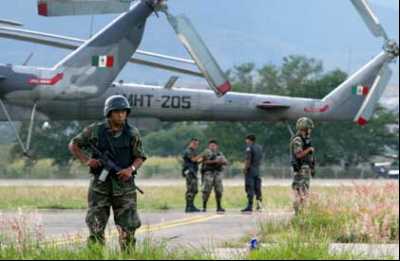 Cooperation of the Mexican Navy in the Mexican Army transfer as well as the recognition of cultivation areas Although violence between drug cartels had been occurring long before the war began, the government held a generally passive stance regarding cartel violence in the 1990s and early 2000s. That changed on December 11, 2006, when newly elected President Felipe Calderón sent 6,500 Federal troops to the state of Michoacán to end drug violence there. This action is regarded as the first major operation against organized crime, and became the starting point of the war between the government and the drug cartels.[284] Calderón escalated his anti-drug campaign, in which there are now about 45,000 troops involved in addition to state and federal police forces. In 2010, Calderón said that the cartels seek "to replace the government" and "are trying to impose a monopoly by force of arms, and are even trying to impose their own laws".[285] As of 2011, Mexico's military captured 11,544 people who were believed to have been involved with the cartels and organized crime.[286] In the year prior, 28,000 individuals were arrested on drug-related charges. The decrease in eradication and drug seizures, as shown in statistics calculated by federal authorities, poorly reflects Calderón's security agenda. Since the war began, over forty thousand people have been killed as a result of cartel violence. During Calderón's presidential term, the murder rate of Mexico increased dramatically.[287] Duration: 51 seconds.0:51 Operation Michoacán Although Calderón set out to end the violent warfare between rival cartel leaders, critics argue that he inadvertently made the problem worse. The methods that Calderón adopted involved confronting the cartels directly. These aggressive methods have resulted in public killings and torture from both the cartels and the country's own government forces, which aids in perpetuating the fear and apprehension that the citizens of Mexico have regarding the war on drugs and its negative stigma. As cartel leaders are removed from their positions, by arrest or death, power struggles for leadership in the cartels have become more intense, resulting in enhanced violence within the cartels themselves.[288] 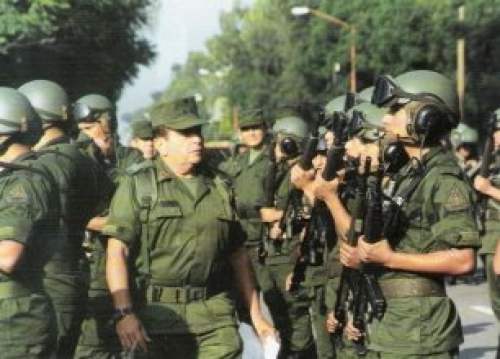 Military of the Mexican Army upon arrival in the state of Michoacan Mexico Calderón's forces concentrate on taking down cartel members that have a high ranking in the cartel in an attempt to take down the whole organization. The resulting struggle to fill the recently vacated position is one that threatens the existence of many lives in the cartel. Typically, many junior-level cartel members then fight amongst one another, creating more and more chaos. The drug cartels are more aggressive and forceful now than they were in the past and at this point, the cartels hold much of the power in Mexico. Calderón relies heavily on the military to defend and fight against cartel activity. Calderón's military forces have yet to yield significant results in dealing with the violent cartels due in part to the fact that many police working for the Mexican government are suspected of corruption. There is suspicion that cartels have corrupted and infiltrated the military at a high level, influencing many generals and officers. Mexico's National Human Rights Commission has received nearly 5,800 complaints regarding military abuse since the beginning of the drug war in 2006. Additionally, the National Human Rights Commission has completed nearly 90 in-depth reports since 2007, addressing the many human rights violations of civilians that have occurred while the military officers were actively participating in law enforcement activities.[289] Violence in May 2012 in which nearly 50 bodies were found on a local highway between the Mexico–United States border and Monterrey has led to the arrests of 4 high-ranking Mexican military officials.[290] These officials were suspected of being on the cartel payrolls and alerting them before military action against them. Such actions demonstrate that Calderón's significant military offensive will continue to reveal mixed results until the military itself is rid of the corrupting influences of the cartels whom they supposedly aim to persecute.[neutrality is disputed] |
作戦 詳細は「ミチョアカン州作戦」を参照 ミチョアカン州作戦  メキシコ陸軍へのメキシコ海軍の協力、および栽培地域の特定 麻薬カルテル間の暴力は戦争が始まる前から続いていたが、1990年代から2000年代初頭にかけて、政府はカルテルの暴力に対して概ね受動的な姿勢を 取っていた。しかし、2006年12月11日に、新たに選出されたフェリペ・カルデロン大統領が麻薬による暴力を根絶するために6,500人の連邦軍兵士 をミチョアカン州に派遣したことで、状況は一変した。この行動は、組織犯罪に対する初の主要作戦とみなされ、政府と麻薬カルテル間の戦争の始まりとなっ た。[284] カルデロン大統領は麻薬撲滅キャンペーンを強化し、現在では州警察や連邦警察に加えて約45,000人の軍人が参加している。2010年、カルデロン大統 領は、麻薬カルテルは「政府を転覆させようとしている」とし、「武力による独占を強要しようとし、独自の法律を強要しようとしている」と述べた。 [285] 2011年現在、メキシコ軍は麻薬カルテルや組織犯罪に関与していると見られる11,544人を拘束した。[286] 前年には麻薬関連容疑で28,000人が逮捕されている。連邦当局が算出した統計に示されているように、根絶や麻薬押収の減少は、カルデロンの治安政策の 失敗を反映している。麻薬カルテル間の抗争による死者は、戦争が始まって以来、4万人を超えている。カルデロン大統領の任期中、メキシコの殺人率は劇的に 増加した。 長さ: 51秒.0:51 ミチョアカン州での作戦 カルデロン大統領は、麻薬カルテルの幹部同士の激しい抗争を終わらせることを目指したが、批判派は、大統領が意図せずして問題を悪化させた、と主張してい る。カルデロン大統領が採用した手法は、麻薬カルテルと直接対決するというものだった。こうした攻撃的な手法により、麻薬カルテルと政府軍の両方による一 般市民の殺害や拷問が引き起こされ、メキシコ市民が麻薬戦争とその負の汚名に対して抱いている恐怖や不安がさらに増幅される結果となった。 カルテルのリーダーが逮捕や死亡によってその地位から排除されると、カルテル内の指導権を巡る権力闘争が激化し、カルテル内部の暴力がさらに増大した。  メキシコ軍がミチョアカン州に到着した際、 カルデロン軍は組織全体を壊滅させるため、麻薬カルテル内で高位にあるメンバーの逮捕に重点的に取り組んだ。その結果、最近空席となった地位をめぐる争い が起こり、カルテル内の多くの人命が脅かされることとなった。通常、多くの下級メンバーが互いに争い、ますます混乱を招くことになる。麻薬カルテルは以前 よりも攻撃的で強引になっており、現在ではメキシコの権力の多くをカルテルが握っている。カルデロン大統領は麻薬カルテルの活動を防御し、これと戦うため に軍に大きく依存している。カルデロン大統領の軍部は、メキシコ政府に勤務する警察官の多くが汚職の疑いがあるという事実もあり、凶暴な麻薬カルテルに対 処する上で、まだ目立った成果を挙げていない。麻薬カルテルが軍部の上層部に入り込み、多くの将校に影響を与えているのではないかという疑いもある。メキ シコの国家人権委員会は、麻薬戦争が始まった2006年以来、軍による虐待に関する5,800件近い苦情を受け取っている。さらに、国家人権委員会は、軍 関係者が法執行活動に積極的に参加していた間に発生した民間人に対する数多くの人権侵害を取り上げた詳細な報告書を2007年以来90件近く完成させてい る。[289] 2012年5月にメキシコと米国の国境とモンテレーの間にある高速道路で50体近くの死体が発見された事件では、4人のメキシコ軍高官が逮捕された。 [290] これらの高官は麻薬カルテルから給与を受け取り、軍が麻薬カルテルに対して行動を起こす前に麻薬カルテルに情報を流していた疑いがある。このような行動 は、カルデロン大統領の軍事攻勢が、カルテルの腐敗的な影響から軍自体が解放されるまで、混合した結果を明らかにし続けることを示している。[中立性は議 論の余地がある] |
| Escalation (2008–12) A Mexican Army technical equipped with a Mk 19 grenade launcher at a random checkpoint In April 2008, General Sergio Aponte, the man in charge of the anti-drug campaign in the state of Baja California, made a number of allegations of corruption against the police forces in the region. Among his allegations, Aponte stated that he believed Baja California's anti-kidnapping squad was actually a kidnapping team working in conjunction with organized crime, and that bribed police units were used as bodyguards for drug traffickers.[291] These accusations sent shock waves through state government. Many of the more than 50 accused officials quit or fled. The progress against drug cartels in Mexico has been hindered by bribery, intimidation, and corruption; four months later the General was relieved of his command.[292] On April 26, 2008, a major battle took place between members of the Tijuana and Sinaloa cartels in the city of Tijuana, Baja California, that left 17 people dead.[293] In March 2009, President Calderón called in an additional 5,000 Mexican Army troops to Ciudad Juárez. The DHS also said that it was considering using state National Guard troops to help the U.S. Border Patrol counter the threat of drug violence in Mexico from spilling over the border into the U.S. The governors of Arizona and Texas have encouraged the federal government to use additional National Guard troops from their states to help those already there supporting state law enforcement efforts against drug trafficking.[294] According to the National Drug Intelligence Center, Mexican cartels are the predominant smugglers and wholesale distributors of South American cocaine and Mexico-produced cannabis, methamphetamine and heroin. Mexico's cartels have existed for some time, but have become increasingly powerful in recent years with the demise of the Medellín and Cali cartels in Colombia. The Mexican cartels are expanding their control over the distribution of these drugs in areas controlled by Colombian and Dominican criminal groups, and it is now believed they control most of the illegal drugs coming into the U.S.[295] No longer mere intermediaries for Colombian producers, Mexican cartels are now powerful organized-crime syndicates that dominate the drug trade in the Americas. Mexican cartels control large swaths of Mexican territory and dozens of municipalities, and they exercise increasing influence in Mexican electoral politics.[296] Cartels have waged violent turf battles over control of key smuggling corridors from Matamoros to San Diego. Mexican cartels employ hitmen and groups of enforcers, known as sicarios. The U.S. Drug Enforcement Administration reports that the Mexican drug cartels operating today along the border are far more sophisticated and dangerous than any other organized criminal group in U.S. law enforcement history.[295] The cartels use grenade launchers, automatic weapons, body armor, Kevlar helmets, and sometimes unmanned aerial vehicles.[297][298][299][300] Some groups have also been known to use improvised explosive devices (IEDs).[301] Casualty numbers have escalated significantly over time. According to a Stratfor report, the number of drug-related deaths in 2006 and 2007 (2,119 and 2,275) more than doubled to 5,207 in 2008. The number further increased substantially over the next two years, from 6,598 in 2009 to over 11,000 in 2010. According to data of the Mexican government, the death numbers are even higher: 9,616 in 2009, 15,273 in 2010, coming to a total of 47,515 killings since their military operations against drug cartels began in 2006, as stated in the government's report of January 2012.[301][302][303] On October 7, 2012, the Mexican Navy responded to a civilian complaint reporting the presence of armed gunmen in Sabinas, Coahuila. Upon the navy's arrival, the gunmen threw grenades at the patrol from a moving vehicle, triggering a shootout that left Lazcano and another gunman dead and one marine slightly wounded.[304] The vehicle was found to contain a grenade launcher, 12 grenades, possibly a rocket-propelled grenade launcher and two rifles, according to the navy.[305] The Navy confirmed his death through fingerprint verification and photographs of his corpse before handing the body to the local authorities.[306] Lazcano is the most powerful cartel leader to be killed since the start of Mexico's drug war in 2006, according to Reuters.[307] This death came just hours after the navy arrested a high-ranking Zeta member in Nuevo Laredo, Tamaulipas, Salvador Alfonso Martínez Escobedo. The death of Lazcano benefited three parties; the Mexican Navy, who scored a significant blow to organized crime with the death of Lazcano, Miguel Treviño Morales, who rose as the "uncontested" leader of Los Zetas, and Joaquín "El Chapo" Guzmán, the leader of the Sinaloa Cartel and the main rival of Los Zetas. El Chapo was perhaps the biggest winner of the three, since his primary goal was to take over the smuggling routes in Nuevo Laredo, Tamaulipas, the headquarters of Treviño Morales.[308] If the body had not been stolen, it would also have been a symbolic victory for Felipe Calderón, who could have said that his administration took down one of the founders and top leaders of Los Zetas and consequently boost the morale of the Mexican military.[309] |
エスカレーション(2008年~2012年) Mk 19グレネードランチャーを装備したメキシコ陸軍技術部隊が、任意の検問所で 2008年4月、バハ・カリフォルニア州の麻薬撲滅キャンペーンの責任者であるセルジオ・アポンテ将軍は、同州の警察部隊の汚職について数々の疑惑を指摘 した。アポンテは、バハ・カリフォルニア州の誘拐対策部隊は実際には組織犯罪と連携した誘拐チームであり、買収された警察部隊が麻薬密売人のボディガード として使われていると主張した。 これらの告発は州政府に衝撃を与えた。50人以上の告発された役人の多くは辞職または逃亡した。メキシコにおける麻薬カルテルに対する進展は、賄賂、脅 迫、汚職によって妨害されてきた。4ヶ月後、この将軍は指揮権を解かれた。 2008年4月26日、バハ・カリフォルニア州ティフアナ市で、ティフアナ・カルテルとシナロア・カルテルのメンバーの間で大規模な戦闘が起こり、17人 が死亡した。 2009年3月、カルデロン大統領はシウダー・フアレスにメキシコ軍の兵士5,000人を追加派遣した。また、国土安全保障省は、メキシコ国内での麻薬暴 力が米国に波及するのを防ぐため、米国国境警備隊を支援する州兵の活用を検討していると発表した。アリゾナ州とテキサス州の知事は、麻薬密売に対する州法 の執行を支援する部隊をすでに派遣しているが、連邦政府に対して、両州からさらに州兵を派遣するよう促している。 国家麻薬情報センターによると、南米産のコカインやメキシコで生産された大麻、メタンフェタミン、ヘロインの密輸および卸売の大部分はメキシコの麻薬カル テルによるものである。メキシコの麻薬カルテルは以前から存在していたが、近年はコロンビアのメデジン・カルテルとカリ・カルテルの崩壊により、ますます 勢力を強めている。メキシコの麻薬カルテルは、コロンビアやドミニカ共和国の犯罪組織が支配する地域でも、これらの麻薬の流通を支配下に置く勢力を拡大し ており、現在では米国に流入する違法麻薬の大半を支配していると考えられている。 もはやコロンビアの生産者の中間業者に過ぎないメキシコの麻薬カルテルは、現在では南北アメリカ大陸の麻薬取引を支配する強力な組織犯罪シンジケートと なっている。 メキシコのカルテルは、メキシコの広大な地域と数十の自治体を支配しており、メキシコの選挙政治にも影響力を強めている。[296] カルテルは、マトモロスからサンディエゴに至る主要な密輸ルートの支配を巡って、激しい縄張り争いを繰り広げている。メキシコの麻薬カルテルは殺し屋やシ カリオと呼ばれる実行部隊を雇っている。米国麻薬取締局は、現在国境沿いで活動しているメキシコの麻薬カルテルは、米国の法執行史上、いかなる組織犯罪集 団よりもはるかに洗練されており、危険であると報告している。[295] カルテルは、グレネードランチャー、自動小銃 、防弾チョッキ、ケブラー製ヘルメット、そして時には無人航空機を使用している。[297][298][299][300] また、即席爆発装置(IED)を使用しているグループもあることが知られている。[301] 死傷者数は、時が経つにつれて大幅に増加している。ストラトフォー社の報告書によると、2006年と2007年の麻薬関連の死者数はそれぞれ2,119人 と2,275人であったが、2008年には5,207人と2倍以上に増加した。その後2年間でさらに大幅に増加し、2009年には6,598人、2010 年には11,000人を超えた。メキシコ政府のデータによると、死亡者数はさらに多く、2009年には9,616人、2010年には15,273人、 2006年に麻薬カルテルに対する軍事作戦が開始されて以来の殺害総数は47,515人に上る。これは2012年1月の政府報告書に記載されている。 [301][302][303] 2012年10月7日、メキシコ海軍は、コアウイラ州サビナスに武装した銃撃犯がいるという民間からの苦情に対応した。海軍が到着すると、武装した男たち は移動中の車からパトロール隊に手榴弾を投げつけ、銃撃戦が起こった。この銃撃戦でラスカノと別の武装した男が死亡し、海兵隊員1人が軽傷を負った。 [304] 海軍によると、車内からはグレネードランチャー、手榴弾12個、ロケット推進式グレネードランチャー、およびライフル銃2丁が発見された。海軍によると、 車両からはグレネードランチャー、手榴弾12個、ロケット推進式グレネードランチャー、およびライフル銃2丁が発見された。[305] 海軍は指紋照合と遺体の写真によりラスカノの死亡を確認し、その後遺体を地元当局に引き渡した。[306] ロイター通信によると、ラスカノは2006年にメキシコ麻薬戦争が始まって以来、最も有力な麻薬カルテルのリーダーとして暗殺された。[307] この死は、海軍がタマウリパス州ヌエボ・ラレドで、ロス・セタスの幹部サルバドール・アルフォンソ・マルティネス・エスコベドを逮捕したわずか数時間後に 起こった。 ラスカノの死は3つの勢力に利益をもたらした。すなわち、ラスカノの死によって組織犯罪に大きな打撃を与えたメキシコ海軍、ロス・セタスの「文句なしの」 リーダーとして台頭したミゲル・トレヴィーニョ・モラレス、そしてロス・セタスの最大のライバルであるシナロア・カルテルのリーダー、ホアキン・「エル・ チャポ」・グスマンである。エル・チャポは、おそらくこの3人の中で最大の勝者であった。なぜなら、彼の主な目的は、トレヴィーニョ・モラレスの本拠地で あるタマウリパス州ヌエボ・ラレドの密輸ルートを乗っ取ることだったからだ。[308] もし死体が盗まれなかった場合、フェリペ・カルデロン大統領にとっても象徴的な勝利となっただろう。なぜなら、ロス・セタスの創設者の1人であり、トップ リーダーであった人物を逮捕したと主張することができ、その結果、メキシコ軍の士気を高めることができたからだ。[309] |
| Effects in Mexico See also: Narcoculture in Mexico Casualties Organized crime homicides in Mexico[310] Year Killed 2007 2,774 2008 5,679 2009 8,281 2010 12,658 2011 12,284 2012 12,412 2013 10,094 2014 7,993 2015 8,423 2016 10,967 2017 12,500 2018 22,500 It is often not clear what deaths are part of the Mexican drug war versus general criminal homicides, and different sources give different estimates.[311] Casualties are often measured indirectly by estimated total deaths from organized crime in Mexico.[311] This amounts to about 115,000 people in the years 2007–2018.[310] From 2018 to 2020, it was estimated that there were 11,400 reports of gang violence, and over 80% of the attacks targeted civilians, resulting in 13,000 related-deaths during the period.[312] Violence 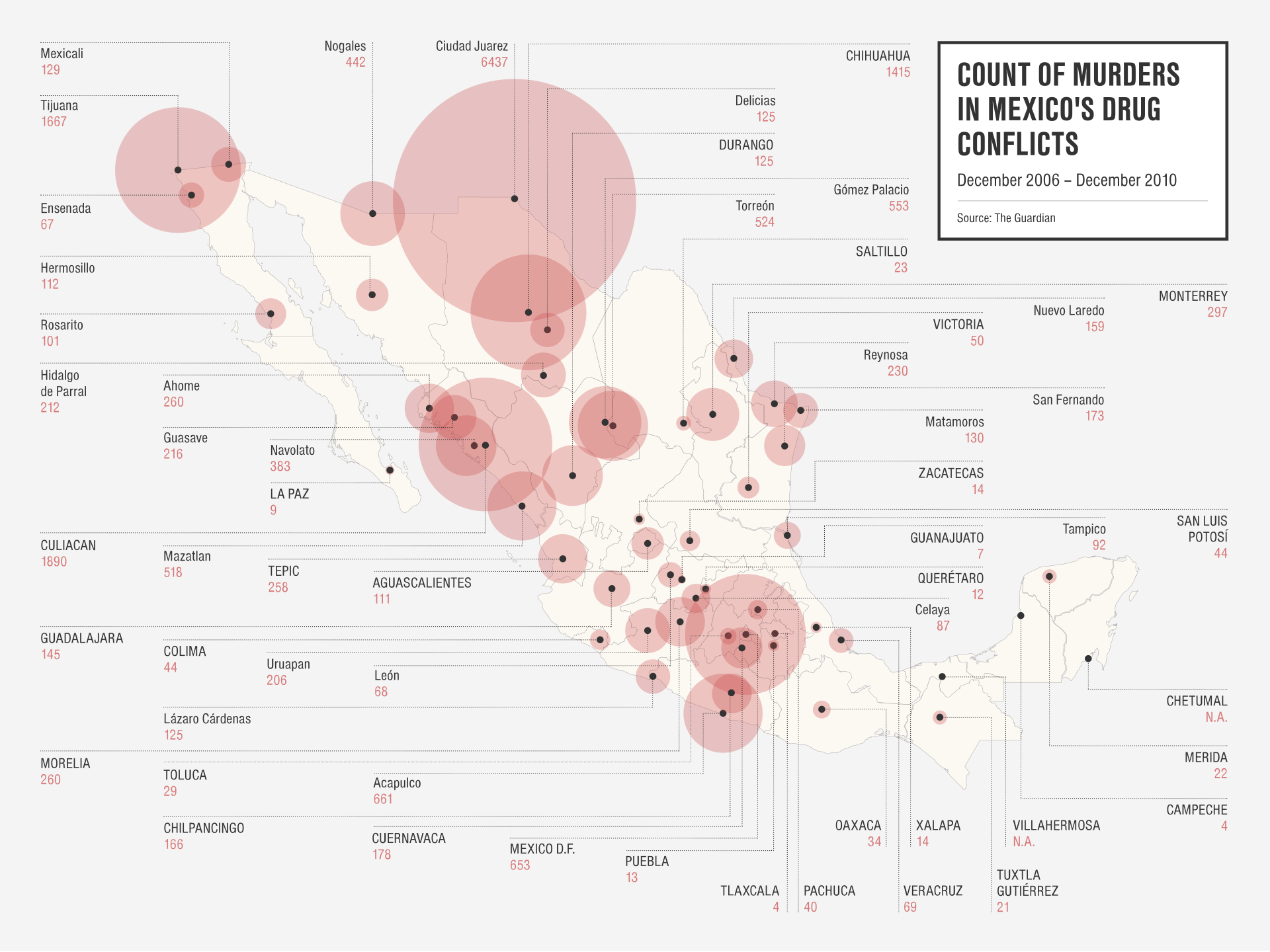 Count of murders in Mexico's drug conflicts (December 2006 to December 2010) The Mexican attorney general's office has claimed that 9 of 10 victims of the Mexican drug war are members of organized-crime groups,[313] although this figure has been questioned by other sources.[314] Deaths among military and police personnel are an estimated 7% of the total.[315] The states that suffer from the conflict most are Baja California, Guerrero, Chihuahua, Michoacán, Tamaulipas, Nuevo León and Sinaloa. By January 2007, these various operations had extended to the states of Guerrero as well as the so-called "Golden Triangle States" of Chihuahua, Durango, and Sinaloa. In the following February the states of Nuevo León and Tamaulipas were included as well. Seizures and arrests have jumped since Calderón took office in December 2006, and Mexico has extradited more than 100 people wanted in the U.S.[citation needed] On July 10, 2008, the Mexican government announced plans to nearly double the size of its Federal Police force to reduce the role of the military in combating drug trafficking.[316] The plan, known as the Comprehensive Strategy Against Drug Trafficking, also involves purging local police forces of corrupt officers. Elements of the plan have already been set in motion, including a massive police recruiting and training effort intended to reduce the country's dependence in the drug war on the military.[citation needed] On July 16, 2008, the Mexican Navy intercepted a 10-meter long narco-submarine travelling about 200 kilometers off the southwest of Oaxaca; in a raid, Special Forces rappelled from a helicopter onto the deck of the submarine and arrested four smugglers before they could scuttle their vessel. The vessel was found to be loaded with 5.8 tons of cocaine and was towed to Huatulco, Oaxaca, by a Mexican Navy patrol boat.[317][318][319][320][321] 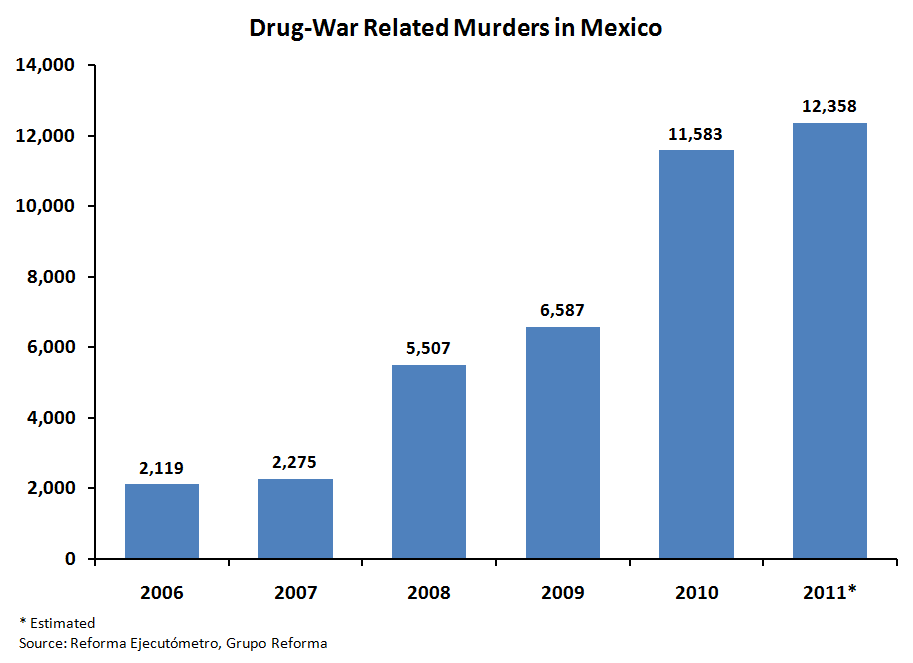 Murders in Mexico since 2006 related to drug trafficking activities. One escalation in this conflict is the traffickers' use of new means to claim their territory and spread fear. Cartel members have broadcast executions on YouTube[322] and on other video sharing platforms or shock sites. Cartels have also hung banners on streets stating demands and warnings.[323] The 2008 Morelia grenade attacks took place on September 15, 2008, when two hand grenades were thrown onto a crowded plaza, killing ten people and injuring more than 100.[324] Some see these efforts as intended to sap the morale of government agents assigned to crack down on the cartels; others see them as an effort to let citizens know who is winning the war. At least one dozen Mexican norteño musicians have been murdered. Most of the victims performed what are known as narcocorridos, popular folk songs that tell the stories of the Mexican drug trade—and celebrate its leaders as folk heroes.[325] Increasing violence has jeopardized foreign investment in Mexico. Finance Minister, Agustín Carstens, said that the deteriorating security alone is reducing gross domestic product annually by 1% in Mexico, Latin America's second-largest economy.[326] Teachers in the Acapulco region were "extorted, kidnapped and intimidated" by cartels, including death threats demanding money. They went on strike in 2011.[327] Ongoing armed conflicts Major wars, 10,000 or more deaths in current or past year Government corruption Mexican cartels advance their operations, in part, by corrupting or intimidating law enforcement officials.[291][124] Mexican municipal, state, and federal government officials, along with the police forces, often work together with the cartels in an organized network of corruption.[38] A Pax Mafioso, is a specific example of corruption which guarantees a politician votes and a following in exchange for not impeding a particular cartel.[38] The International Narcotics Control Board (INCB) reports that although the central government of Mexico has made concerted efforts to reduce corruption in recent years, it remains a serious problem.[328][329] Some agents of the Federal Investigations Agency (AFI) are believed to work as enforcers for various cartels, and the Attorney General (PGR) reported in December 2005 that nearly 1,500 of AFI's 7,000 agents were under investigation for suspected criminal activity and 457 were facing charges.[124] 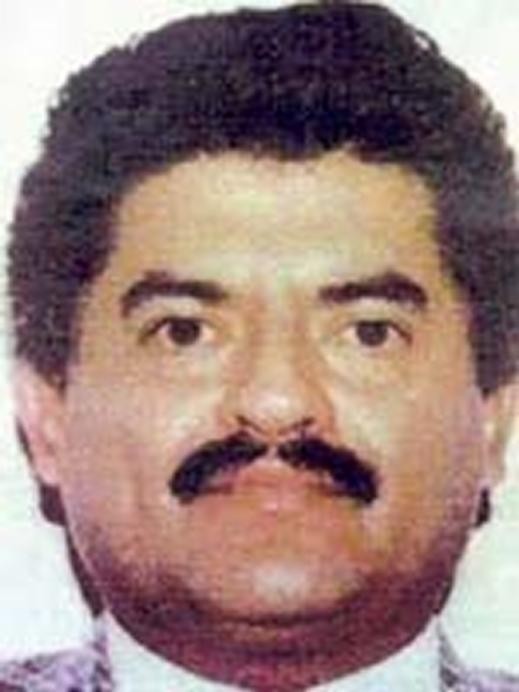 El Azul was a Sinaloa Cartel drug lord. He was a former Dirección Federal de Seguridad (DFS) agent. In recent years, the federal government conducted purges and prosecution of police forces in Nuevo Laredo, Michoacán, Baja California and Mexico City.[124] The anti-cartel operations begun by President Calderón in December 2006 includes ballistic checks of police weapons in places where there is concern that police are also working for the cartels. In June 2007, President Calderón purged 284 federal police commanders from all 31 states and the Federal District.[124] Under the 'Cleanup Operation' performed in 2008, several agents and high-ranking officials have been arrested and charged with selling information or protection to drug cartels;[330][331] some high-profile arrests were: Victor Gerardo Garay Cadena,[332] (chief of the Federal Police), Noé Ramírez Mandujano (ex-chief of the Organized Crime Division (SEIDO)), José Luis Santiago Vasconcelos (ex-chief of the Organized Crime Division (SEIDO)), and Ricardo Gutiérrez Vargas who is the ex-director of Mexico's Interpol office. In January 2009, Rodolfo de la Guardia García, ex-director of Mexico's Interpol office, was arrested.[333] Julio César Godoy Toscano, who was just elected July 6, 2009, to the lower house of Congress, is charged with being a top-ranking member of La Familia Michoacana drug cartel and of protecting this cartel.[334] He is now a fugitive. In May 2010, an NPR report collected allegations from dozens of sources, including U.S. and Mexican media, Mexican police officials, politicians, academics, and others, that Sinaloa Cartel had infiltrated and corrupted the Mexican federal government and the Mexican military by bribery and other means. According to a report by the U.S. Army Intelligence section in Leavenworth, over a six-year period, of the 250,000 soldiers in the Mexican Army, 150,000 deserted and went into the drug industry.[335] The 2010 NPR report also stated that the Sinaloa Cartel was colluding with the government to destroy other cartels and protect itself and its leader, 'Chapo'. Mexican officials denied any corruption in the government's treatment of drug cartels.[168][169] Cartels had previously been reported as difficult to prosecute "because members of the cartels have infiltrated and corrupted the law enforcement organizations that are supposed to prosecute them, such as the Office of the Attorney General."[336] |
メキシコにおける影響 関連項目:メキシコの麻薬文化 犠牲者 メキシコにおける組織犯罪による殺人事件[310] 年 殺害された人数 2007年 2,774人 2008年 5,679人 2009年 8,281人 2010年 12,658人 2011年 12,284人 2012年 12,412 2013年 10,094 2014年 7,993 2015年 8,423 2016年 10,967 2017年 12,500 2018年 22,500 メキシコ麻薬戦争による死者と一般犯罪による殺人事件による死者を区別することはしばしば困難であり、異なる情報源は異なる推定値を提示している。 [311] 犠牲者の数は、メキシコにおける組織犯罪による総死亡者数の推定値から間接的に測定されることが多い。[311] この数は2007年から2018年の間に約11万5000人に上る。 。2018年から2020年にかけては、ギャングによる暴力事件の報告件数は11,400件と推定され、その80%以上が民間人を標的としたもので、この 期間に13,000人の関連死者が発生した。 暴力  メキシコの麻薬抗争による殺人事件の件数(2006年12月~2010年12月) メキシコ司法長官事務所は、メキシコ麻薬戦争の犠牲者の10人中9人が組織犯罪グループのメンバーであると主張しているが[313]、この数字は他の情報 源から疑問視されている[314]。軍および警察関係者の死亡者は、総数の7%と推定されている[315]。この紛争で最も被害を受けている州は、バハ・ カリフォルニア州、ゲレーロ州、チワワ州、ミチョアカン州、タマウリパス州、ヌエボ・レオン州、シナロア州である。 2007年1月までに、これらのさまざまな作戦はゲレロ州、およびチワワ州、ドゥランゴ州、シナロア州のいわゆる「黄金の三角州」にも拡大した。翌2月に はヌエボ・レオン州とタマウリパス州も加わった。 2006年12月にカルデロンが就任して以来、押収と逮捕は急増し、メキシコは米国が指名手配している100人以上を身柄引き渡しした。 2008年7月10日、メキシコ政府は麻薬密売対策における軍の役割を縮小するため、連邦警察の規模をほぼ倍増させる計画を発表した。[316] この計画は「麻薬密売に対する包括的戦略」として知られ、地元警察から汚職警官を一掃することも含まれている。この計画の一部はすでに実行に移されてお り、軍への麻薬戦争依存度を減らすことを目的とした大規模な警察官の採用と訓練もその一環である。 2008年7月16日、メキシコ海軍はオアハカ州南西部沖約200キロメートルを航行していた全長10メートルの麻薬密輸用潜水艦を拿捕した。特殊部隊が ヘリコプターから潜水艦の甲板に降り立ち、密輸業者4名が船を沈没させる前に逮捕した。その船には5.8トンのコカインが積まれており、メキシコ海軍の哨 戒艇によってオアハカ州のフアトゥルコまで曳航された。[317][318][319][320][321]  2006年以降のメキシコにおける麻薬密売に関連した殺人事件。 この紛争におけるエスカレートのひとつは、密売人たちが縄張りを主張し恐怖を広めるために新しい手段を用いていることである。カルテルのメンバーは、 YouTube[322]や他の動画共有サイトやショッキングサイトで処刑の様子を流している。カルテルはまた、要求や警告を書いた垂れ幕を街に掲げてい る。 2008年のモレリア手榴弾テロは2008年9月15日に発生し、混雑した広場に2個の手榴弾が投げ込まれ、10人が死亡、100人以上が負傷した。 [324] こうした行為を、麻薬カルテルの取り締まりを担当する政府捜査官の士気を低下させることを目的としたものと見る者もいれば、麻薬戦争の勝者が誰であるかを 市民に知らせるための行為と見る者もいる。少なくとも1ダースのメキシコのノルテーニョ音楽のミュージシャンが殺害されている。犠牲者のほとんどは、メキ シコの麻薬取引の物語を語る、人気の民謡であるナルココーリド(narcocorridos)を演奏しており、その指導者を民衆のヒーローとして称えてい た。 暴力の増加は、メキシコへの外国からの投資を危険にさらしている。アグスティン・カルステンス財務大臣は、治安の悪化だけでラテンアメリカ第2位の経済規 模を誇るメキシコの国内総生産が毎年1%ずつ減少していると述べた。 アカプルコ地域の教師たちは、カルテルから「恐喝、誘拐、脅迫」を受け、金銭を要求する殺害予告も受けた。彼らは2011年にストライキを行った。 現在進行中の武力紛争 過去1年間に1万人以上の死者を出した大規模な戦争 政府の腐敗 メキシコの麻薬カルテルは、一部、法執行官を買収したり脅迫したりすることで、その活動を拡大している。[291][124] メキシコの地方自治体、州、連邦政府の役人たちは、警察とともに、腐敗した組織的なネットワークの中で麻薬カルテルと協力することが多い。[38] マフィアの支配は、特定のカルテルの活動を妨害しないことと引き換えに、政治家が票と支持を保証する腐敗の具体例である。[38] 国際麻薬統制委員会(INCB)の報告によると、メキシコ中央政府は近年、腐敗の削減に一丸となって取り組んできたが、依然として深刻な問題であるとされ ている。[328][329] 連邦捜査局(AFI)の捜査官の一部は、 2005年12月、司法長官(PGR)は、AFIの7,000人の捜査官のうち、1,500人近くが犯罪行為の疑いで捜査対象となっており、457人が起 訴されていると報告した。  エル・アスールはシナロア・カルテルの麻薬王であった。彼は元連邦警察局(Dirección Federal de Seguridad、DFS)の捜査官であった。 近年、連邦政府はヌエボ・ラレド、ミチョアカン、バハ・カリフォルニア、メキシコシティの警察の粛清と起訴を行った。[124] カルデロン大統領が2006年12月に開始した麻薬カルテル対策には、警察が麻薬カルテルの仕事もしていると疑われる場所での警察の武器の弾道検査も含ま れている。2007年6月、カルデロン大統領は31州と連邦区の全警察官284名を更迭した。 2008年に実施された「浄化作戦」では、麻薬カルテルに情報や保護を売った容疑で複数の捜査官や高官が逮捕・起訴された。ビクター・ガライ・カデナ(連 邦警察のトップ)、ノエ・ラミレス・マンデュハノ(元組織犯罪対策課(SEIDO)のトップ)、ホセ・ルイス・サンティアゴ・バスコンセロス(元組織犯罪 対策課(SEIDO)のトップ)、そしてメキシコのインターポール事務所の元所長であるリカルド・グティエレス・ヴァルガスである。2009年1月には、 メキシコのインターポール事務所の元所長であるロドルフォ・デ・ラ・ガーディア・ガルシアが逮捕された。[333] 2009年7月6日に連邦議会下院議員に当選したばかりのフリオ・セサル・ゴドイ・トスカノは、ラ・ファミリア・ミチョアカン麻薬カルテルの幹部であり、 このカルテルを保護していたとして起訴されている。[334] 彼は現在逃亡中である。 2010年5月、NPRの報道は、米国およびメキシコのメディア、メキシコ警察当局者、政治家、学者など数十のソースから、シナロア・カルテルが賄賂やそ の他の手段でメキシコ連邦政府およびメキシコ軍に浸透し、腐敗させていたという主張を集めた。米国ワシントン州レベンワースの米陸軍情報部の報告による と、6年間にわたって、メキシコ軍の25万人の兵士のうち15万人が脱走し、麻薬業界に転身したという。 2010年のNPRの報告書は、シナロア・カルテルが政府と結託して他のカルテルを壊滅させ、自分たちとリーダーの「チャポ」を守っているとも述べてい る。メキシコ当局は、麻薬カルテルに対する政府の対応に汚職は一切ないと否定した。[168][169] カルテルは、以前から起訴が難しいと報告されていた。「カルテルのメンバーが、起訴すべき法執行機関、例えば司法長官事務所などに浸透し、腐敗させている ためだ」[336] |
Effects on human rights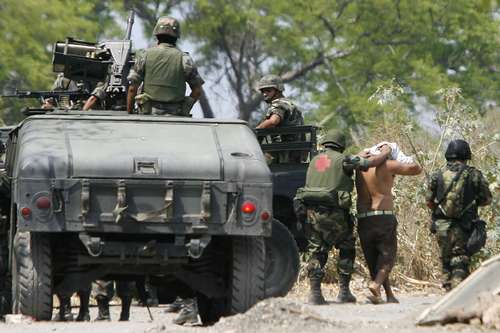 Mexican soldiers detain cartel suspects in Michoacán, 2007 The drug control policies Mexico has adopted to prevent drug trafficking and to eliminate the power of the drug cartels have adversely affected the human rights situation in the country. These policies have given the responsibilities for civilian drug control to the military, which has the power to not only carry out anti-drug and public security operations but also enact policy. According to the U.S. State Department, the police and the military in Mexico were accused of committing serious human rights violations as they carried out government efforts to combat drug cartels.[337] Some groups are especially vulnerable to human rights abuses collateral to drug law enforcement. Specifically in northern border states that have seen elevated levels of drug-related violence, human rights violations of injection drug users (IDUs) and sex workers by law enforcement personnel include physical and sexual violence, extortion, and targeting for accessing or possession of injection equipment or practicing sex work, although these activities are legal.[338][339][340] Such targeting is especially deleterious because members of these marginalized communities often lack the resources and social or political capital to enforce their rights.[338][339][340] Immense power in the executive branch and corruption in the legislative and judiciary branches also contribute to the worsening of Mexico's human rights situation, leading to such problems as police forces violating basic human rights through torture and threats, the autonomy of the military and its consequences and the ineffectiveness of the judiciary in upholding and preserving basic human rights. Some of the forms of human rights violations in recent years presented by human rights organizations include illegal arrests, secret and prolonged detention, torture, rape, extrajudicial execution, and fabrication of evidence.[341][342][343] Drug policy fails to target high-level traffickers. In the 1970s, as part of the international Operation Condor, the Mexican government deployed 10,000 soldiers and police to a poverty-stricken region in northern Mexico plagued by drug production and leftist insurgency. Hundreds of peasants were arrested, tortured, and jailed, but no major drug traffickers were captured.[344] The emergence of internal federal agencies that are often unregulated and unaccountable also contributes to the occurrence of human rights violations.[according to whom?] The AFI of Mexico had been involved with numerous human rights violation cases involving torture and corruption. In one case, detainee Guillermo Velez Mendoza died while in the custody of AFI agents. The AFI agent implicated in his death was arrested and escaped on bail.[345] 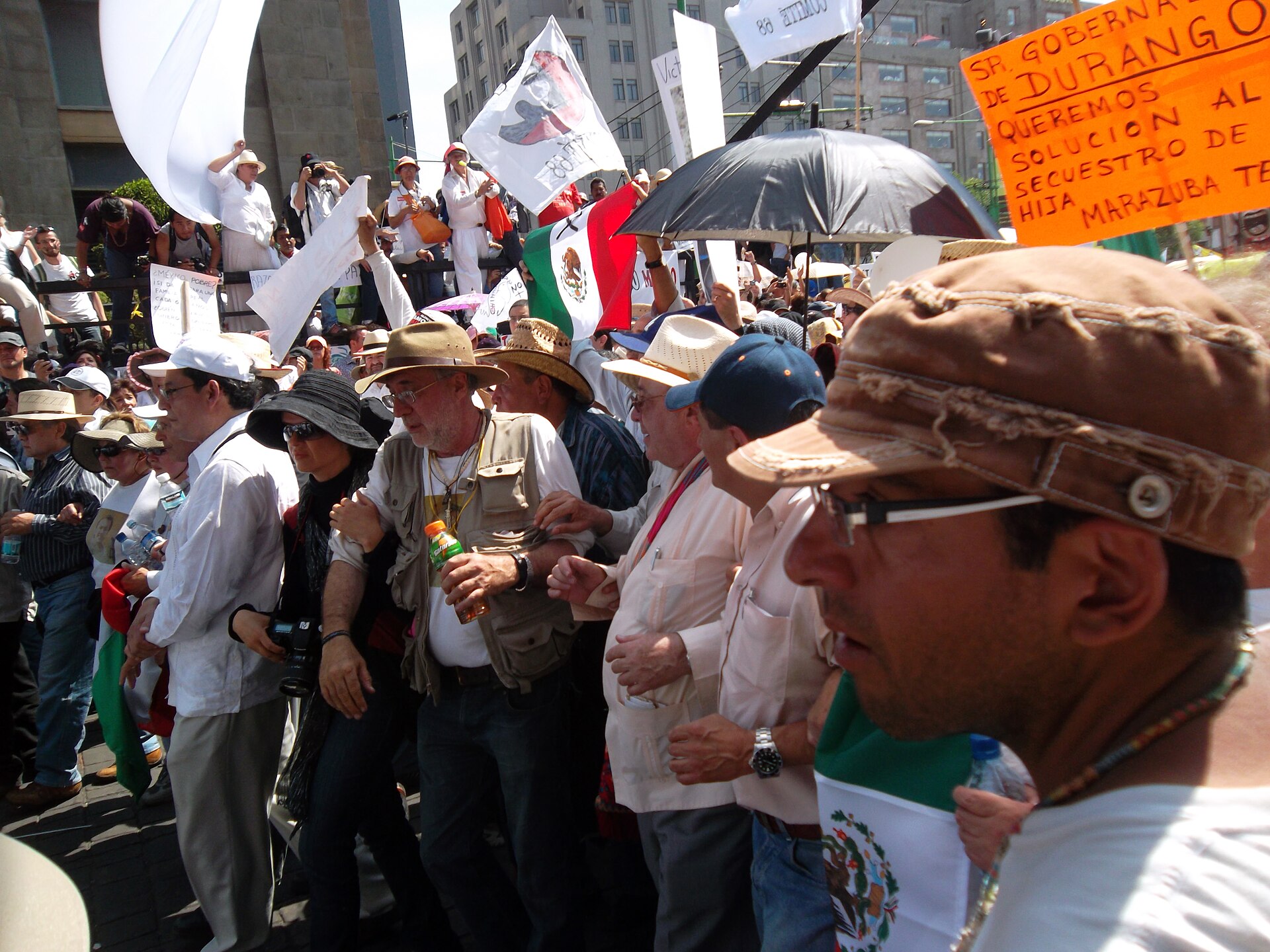 2011 Mexican protests against cartel violence and government disregard Similarly, nearly all AFI agents evaded punishment and arrest due to the corrupt executive and judiciary system and the supremacy of these agencies.[citation needed] The Attorney General's Office reported in December 2005 that one-fifth of its officers were under investigation for criminal activity, and that nearly 1,500 of AFI's 7,000 agents were under investigation for suspected criminal activity and 457 were facing charges.[124][346] The AFI was finally declared a failure and was disbanded in 2009.[347] Ethnic prejudices have also emerged in the drug war, and poor and helpless indigenous communities have been targeted by the police, military, drug traffickers and the justice system. According to the National Human Rights Commission (Mexico) (Comisión Nacional de los Derechos Humanos-CNDH), nearly one-third of the indigenous prisoners in Mexico in 2001 were in prison for federal crimes, which are mostly drug-related.[348] Another major concern is the lack of implementation of the Leahy Law in U.S. and the consequences of that in worsening the human rights situation in Mexico. Under this U.S. law, no member or unit of a foreign security force that is credibly alleged to have committed a human rights violation may receive U.S. security training. It is alleged[by whom?] that the U.S., by training the military and police force in Mexico, is in violation of the Leahy Law. In this case, the U.S. embassy officials in Mexico in charge of human rights and drug control programs are blamed with aiding and abetting these violations. In December 1997, a group of heavily armed Mexican special forces soldiers kidnapped twenty young men in Ocotlan, Jalisco, brutally torturing them and killing one. Six of the implicated officers had received U.S. training as part of the Grupo Aeromóvil de Fuerzas Especiales (GAFE) training program.[349] |
人権への影響 2007年、ミチョアカン州で麻薬カルテルの容疑者を拘束するメキシコ軍兵士 麻薬密売を防止し、麻薬カルテルの力を排除するためにメキシコが採用した麻薬対策政策は、同国の状況の人権に悪影響を与えている。これらの政策により、民 間による麻薬対策の責任は軍に委ねられた。軍は麻薬対策や治安維持活動を実施するだけでなく、政策を立案する権限も有している。米国務省によると、メキシ コの警察および軍は、麻薬カルテル対策として政府が実施した取り組みにおいて、深刻な人権侵害を犯したとして非難された。[337] 麻薬取締に付随する人権侵害に対して特に脆弱なグループもある。特に麻薬関連の暴力のレベルが高い北部の国境地帯では、麻薬注射使用者(IDU)や性労働 者に対する法執行関係者による人権侵害には、身体的・性的暴力、恐喝、注射器具の使用や所持、あるいは性労働の実践を理由とした標的化が含まれるが、 これらの活動は合法であるが。[338][339][340] こうした標的化は特に有害である。なぜなら、こうした社会的に疎外されたコミュニティのメンバーは、しばしば自らの権利を主張するための資源や社会的・政 治的資本を欠いているからである。[338][339][340] また、行政権の巨大な権力や立法府および司法府の腐敗もメキシコの人権状況の悪化に拍車をかけ、拷問や脅迫による警察による基本的人権の侵害、軍の自治と その結果、および基本的人権の擁護と保護における司法の非効率性といった問題を引き起こしている。人権団体が近年指摘している人権侵害の例としては、違法 逮捕、秘密裏かつ長期にわたる拘束、拷問、レイプ、超法規的処刑、証拠のねつ造などがある。[341][342][343] 麻薬政策は、高級麻薬密売人の標的を絞り損ねている。1970年代、国際的な「コンドル作戦」の一環として、メキシコ政府は麻薬生産と左翼の反乱に悩まさ れていたメキシコ北部の貧困地域に1万人の兵士と警察官を配備した。何百人もの農民が逮捕され、拷問を受け、投獄されたが、主要な麻薬密売人は捕まえられ なかった。 しばしば規制や説明責任のない国内の連邦機関の出現も、人権侵害の発生の一因となっている。[誰による?] メキシコ連邦警察は、拷問や汚職を伴う数多くの人権侵害事件に関与していた。ある事件では、連邦警察の拘留中に被拘留者ギジェルモ・ベレス・メンドーサが 死亡した。彼の死に関与したとされる連邦警察官は逮捕されたが、保釈中に逃亡した。[345]  2011年のメキシコにおける麻薬カルテルの暴力と政府の無関心に対する抗議 同様に、汚職の蔓延した行政および司法制度と、これらの機関の優位性により、ほとんどすべてのAFI捜査官が処罰や逮捕を免れている。[要出典] 2005年12月、司法長官事務所は、職員の5分の1が犯罪行為の容疑で捜査中であり、 7,000人の捜査官のうち1,500人近くが犯罪行為の疑いで捜査対象となり、457人が起訴されていた。[124][346] AFIは最終的に失敗と宣言され、2009年に解散された。[347] 麻薬戦争では民族的な偏見も浮上し、貧しく無力な先住民コミュニティが警察、軍、麻薬密売者、司法制度の標的となっている。メキシコ国家人権委員会 (Comisión Nacional de los Derechos Humanos-CNDH)によると、2001年のメキシコにおける先住民の受刑者のほぼ3分の1が麻薬関連の連邦犯罪で刑務所に収監されていた。 もう一つの大きな懸念は、米国におけるリーヒー法の実施不足と、それがメキシコの人権状況の悪化につながっていることである。この米国の法律では、人権侵 害を行ったと信憑性をもって疑われる外国の治安部隊の構成員または部隊は、米国の治安維持訓練を受けることができない。米国がメキシコの軍や警察に訓練を 提供していることで、リーヒー法に違反しているという主張もある。この場合、人権や麻薬対策プログラムを担当する在メキシコ米国大使館の職員は、これらの 違反行為を幇助していると非難されている。1997年12月、重武装したメキシコの特殊部隊兵士の一団が、ハリスコ州オコトランで20人の若い男性を誘拐 し、彼らを残忍に拷問し、1人を殺害した。関与した6人の将校は、メキシコの特殊部隊訓練プログラム(GAFE)の一環として米国で訓練を受けていた。 [349] |
| Effects on public health "The social fabric is so destroyed that it cannot be healed in one generation or two because wounds become deeply embedded...Mexico has a humanitarian tragedy and we have not grasped how big it is."—Elena Azaola, Centre for Social Anthropology High Studies and Research[350] As a result of "spillover" along the U.S.-bound drug trafficking routes and more stringent border enforcement, Mexico's northern border states have seen increased levels of drug consumption and abuse, including elevated rates of drug injection 10 to 15 times the national average.[338][351][352] These rates are accompanied by mounting rates of HIV and STIs among injection drug users (IDUs) and sex workers, reaching a 5.5% prevalence in cities such as Tijuana and Ciudad Juárez, which also report STI rates of 64% and 83%, respectively.[338] Violence and extortion of IDUs and sex workers directly and indirectly elevate the levels of risk behavior and poor health outcomes among members of these groups.[338][353] Marginalization of these vulnerable groups by way of physical and sexual violence and extortion by police threatens the cross-over of infection from high-prevalence groups to the general population.[338][354][355] In particular, decreased access to public health services such as syringe exchange programs and confiscation of syringes can precipitate a cascade of health harms.[356][357][358] Geographic diffusion of epidemics from the northern border states elsewhere is also possible with the rotation of police and military personnel stationed in drug conflict areas with high infection prevalence.[338][354][355] |
公衆衛生への影響 「社会構造は破壊され、その傷は深く刻み込まれるため、1世代や2世代で癒えるものではない。メキシコは人道上の悲劇に直面しており、その規模を把握でき ていない」—エレナ・アゾラ、社会人類学高等研究センター[350] 米国向け麻薬密売ルートに沿った「波及効果」と国境取締りの強化の結果、メキシコ北部の国境沿いの州では、麻薬の消費と乱用が増加し、麻薬注射の割合が国 民平均の10倍から15倍に増加した。[338][351][352] これらの割合は、 薬物注射使用者(IDU)や性労働者におけるHIVおよび性感染症(STI)の感染率も上昇しており、ティフアナやシウダー・フアレスなどの都市では、そ れぞれ5.5%、64%、83%に達している。[338] 薬物注射使用者や性労働者に対する暴力や恐喝は、直接的にも間接的にも、これらのグループのメンバーにおける危険な行動や これらのグループのメンバーの間で、危険な行動や健康状態の悪化のレベルを直接・間接的に高めている。[338][353] 警察による身体的・性的暴力や恐喝によって、こうした脆弱なグループが疎外されることは、感染率の高いグループから一般人口への感染の拡大を招く恐れがあ る。[338][354][355] 特に、 注射器交換プログラムや注射器の没収など、公衆衛生サービスへのアクセスが減少すると、健康被害が次々と発生する可能性がある。[356][357] [358] 感染率の高い麻薬紛争地域に駐留する警察官や軍人の異動により、北部の国境州から他の地域に流行病が地理的に拡大する可能性もある。[338][354] [355] |
| Journalists and the media Main article: List of journalists killed in Mexico  Demonstration against the murder of Mexican journalist Javier Valdez Cárdenas in May 2017 The increase in violence related with organized crime has significantly deteriorated the conditions in which local journalism is practiced.[359] In the first years of the 21st century, Mexico was considered the most dangerous country in the world to practice journalism, according to groups like the National Human Rights Commission, Reporters Without Borders, and the Committee to Protect Journalists. Between 2000 and 2012, several dozen journalists, including Miguel Ángel López Velasco, Luis Carlos Santiago, and Valentín Valdés Espinosa, were murdered there for covering narco-related news.[360][361] The offices of Televisa and local newspapers have been bombed.[362] The cartels have also threatened to kill news reporters in the U.S. who have done coverage on the drug violence.[363] Some media networks simply stopped reporting on drug crimes, while others have been infiltrated and corrupted by drug cartels.[364][365] In 2011, Notiver journalist Miguel Angel Lopez Velasco, his wife, and his son were murdered in their home.[366] About 74 percent of the journalists killed since 1992 in Mexico have been reporters for print newspapers, followed in number by Internet media and radio at about 11 percent each. Television journalism only includes 4 percent of the deaths.[367] These numbers are not proportional to the audience size of the different mediums; most Mexican households have a television, a large majority have a radio, but only a small number have the internet, and the circulation numbers for Mexican newspapers are relatively low.[368][369] Since harassment neutralized many traditional media outlets, anonymous, sensationalized blogs like Blog del Narco took on the role of reporting on events related to the drug war.[370] The drug cartels responded by murdering bloggers and social media users. Twitter users have been tortured and killed for posting and denouncing information of the drug cartels' activities.[371] In September 2011, user NenaDLaredo of the website Nuevo Laredo Envivo was allegedly murdered by Los Zetas.[372] In May 2012, several journalist murders occurred in Veracruz. Regina Martinez of Proceso was murdered in Xalapa. A few days later, three Veracruz photojournalists were tortured and killed and their dismembered bodies were dumped in a canal. They had worked for various news outlets, including Notiver, Diario AZ, and TV Azteca. Human rights groups condemned the murders and demanded the authorities investigate the crimes.[361][373][374] |
ジャーナリストとメディア 詳細は「メキシコで殺害されたジャーナリストの一覧」を参照  2017年5月に殺害されたメキシコ人ジャーナリスト、ハビエル・バルデス・カルデロス氏に対するデモ 組織犯罪に関連する暴力の増加は、現地のジャーナリズムの状況を著しく悪化させている。[359] 21世紀の最初の数年間、メキシコは、全国人権委員会、国境なき記者団、ジャーナリスト保護委員会などの団体によると、ジャーナリズムを実践する上で世界 で最も危険な国と考えられていた。2000年から2012年の間に、ミゲル・アンヘル・ロペス・ベラスコ、ルイス・カルロス・サンティアゴ、バレンティ ン・バルデス・エスピノサを含む数十人のジャーナリストが麻薬関連のニュースを報道したために殺害された。[360][361] テレヴィサや地元紙のオフィスが爆破された。[362] 麻薬カルテルは、麻薬暴力に関する報道を行った米国の報道記者たちを殺害すると脅迫した。[363] いくつかのメディアネットワークは麻薬犯罪に関する報道を単純に止めてしまった 。また、麻薬カルテルに潜入され、腐敗させられたメディアもある。[364][365] 2011年には、Notiverのジャーナリスト、ミゲル・アンヘル・ロペス・ベラスコと彼の妻、息子が自宅で殺害された。 1992年以降にメキシコで殺害されたジャーナリストの約74パーセントは、紙媒体の新聞記者であり、インターネットメディアとラジオがそれぞれ約11 パーセントでそれに続いている。テレビジャーナリズムは、死亡者のわずか4%を占めるに過ぎない。[367] これらの数字は、異なるメディアの視聴者規模に比例するものではない。ほとんどのメキシコの家庭にはテレビがあり、大多数の家庭にはラジオがあるが、イン ターネットを利用している家庭は少なく、メキシコの新聞の発行部数は比較的少ない。[368][369] 嫌がらせにより多くの伝統的なメディアが機能しなくなったため、麻薬戦争に関する出来事を報道する役割を、匿名で扇情的なブログである「麻薬ブログ」が担 うようになった。麻薬カルテルは、ブロガーやソーシャルメディアユーザーを殺害することでこれに対抗した。麻薬カルテルの活動に関する情報を投稿したり告 発したりしたために、Twitterユーザーが拷問を受けたり殺害されたりしている。[371] 2011年9月には、Nuevo Laredo EnvivoのユーザーであるNenaDLaredoがロス・セタスによって殺害されたとされる事件があった。[372] 2012年5月には、ベラクルス州で複数のジャーナリストが殺害された。ハラパでは、プロセソ紙のレジーナ・マルティネスが殺害された。数日後には、ベラ クルス州のフォトジャーナリスト3人が拷問の末に殺害され、バラバラに切断された遺体が水路に捨てられた。被害者らは、Notiver、Diario AZ、TV Aztecaなど、さまざまな報道機関で働いていた。人権団体は殺害を非難し、当局に犯罪の捜査を要求した。[361][373][374] |
| Murders of politicians Main article: List of politicians killed in the Mexican drug war Since the start of the Mexican drug war in 2006, the drug trafficking organizations have slaughtered their rivals, killed policemen, and have increasingly targeted politicians – especially local leaders.[375] Most of the places where these politicians have been killed are areas plagued by drug-related violence.[375] Part of the strategy used by criminal groups behind the killings of local figures is the weakening of the local governments.[375] For example, María Santos Gorrostieta Salazar, former mayor of Tiquicheo, Michoacán, who had survived three earlier assassination attempts and the murder of her husband, was abducted and beaten to death in November 2012.[376] Extreme violence puts politicians at the mercy of the cartels, allowing them to increase their control of government structures and expand their influence.[375] In addition, because mayors usually appoint local police chiefs, they are seen by the cartels as key assets in their criminal activities to control the police forces in their areas of influence.[377] The cartels also seek to control the local governments to win government contracts and concessions; these "public works" help them ingrain themselves in the community and gain the loyalty and respect of the communities in which they operate.[377] Politicians are usually targeted for three reasons: (1) Political figures who are honest pose a direct threat to organized crime, and are consequently killed by the cartels; (2) Politicians make arrangements to protect a certain cartel and are killed by a rival cartel; and (3) A cartel kills politicians to heat up the turf of the rival cartel that operates in the area.[378] |
政治家殺害 詳細は「メキシコ麻薬戦争で殺害された政治家一覧」を参照 2006年のメキシコ麻薬戦争開始以来、麻薬密売組織はライバルを殺害し、警官を殺害し、政治家、特に地元の指導者を標的にするようになってきている。 [375] これらの政治家が殺害された場所のほとんどは、麻薬関連の暴力に悩まされている地域である。[375] 地元の有力者の殺害を裏で操る犯罪グループの戦略の一部は、地方自治体の弱体化である 。例えば、ミチョアカン州ティキチェオの元市長マリア・サントス・ゴロスティエタ・サラザールは、過去に3度暗殺未遂を逃れ、夫も殺害されたが、2012 年11月に誘拐され、暴行を受けて死亡した。[376] 極度の暴力により、政治家は麻薬カルテルの言いなりとなり、政府機構に対する支配力を強め、影響力を拡大することが可能となる。 さらに、通常、市長が地元の警察署長を任命することから、麻薬カルテルは、影響下にある地域の警察を支配する上で、市長を犯罪活動における重要な戦力とみ なしている。[377] また、麻薬カルテルは、政府との契約や利権を獲得するために地方自治体を支配しようとしている。こうした「公共事業」は、麻薬カルテルが地域社会に根を下 ろし、活動地域のコミュニティから忠誠心と尊敬を集めるのに役立っている。[377] 政治家が標的とされる理由は通常、以下の3つである。(1) 正直な政治家は組織犯罪にとって直接的な脅威となるため、カルテルによって殺害される。(2) 政治家が特定のカルテルを保護する取り決めを行い、ライバルのカルテルによって殺害される。(3) カルテルが、その地域で活動するライバルのカルテルの縄張りを荒立てるために政治家を殺害する。[378] |
| Massacres and exploitation of
migrants See also: 2010 San Fernando massacre; 2011 San Fernando massacre; and Allende, Coahuila Cartels have engaged in kidnapping, ransom, murder, robbery, and extortion of migrants traveling from Central America through Mexico on their way to the United States and Canada. Cartels have also forced migrants to join their organization and work for them, a situation that has been described as slavery.[379][380] Mass graves have been also discovered in Mexico containing bodies of migrants.[381] In 2011, 177 bodies were discovered in a mass grave in San Fernando, Tamaulipas, the same area where the bodies of 72 migrants were discovered in 2010,[382] where most victims "died of blunt force trauma to the head."[383] Cartels have also infiltrated the Mexican government's immigration agencies, and attacked and threatened immigration officers.[384] The National Human Rights Commission of Mexico (Comisión Nacional de los Derechos Humanos, CNDH) said that 11,000 migrants had been kidnapped in 6 months in 2010 by drug cartels.[385] |
移民に対する虐殺と搾取 関連項目:2010年のサンフェルナンド虐殺、2011年のサンフェルナンド虐殺、アランデ、コアウイラ カルテルは、中米からメキシコを経由して米国やカナダに向かう移民を誘拐し、身代金、殺人、強盗、恐喝を行っている。 また、移民を強制的に組織に参加させ、労働に従事させており、これは奴隷制であると表現されている。[379][380] メキシコでは、移民の遺体が埋められた集団墓地も発見されている。[381] 2011年には、 タマウリパス州サンフェルナンドの集団墓地で71人の遺体が発見された。この地域では2010年に72人の移民の遺体が発見されており、[382] ほとんどの犠牲者は「頭部への鈍器による外傷で死亡していた」[383] 麻薬カルテルはメキシコ政府の移民局にも浸透しており、移民局職員を攻撃したり脅迫したりしている。[384] メキシコ国家人権委員会(Comisión Nacional de los Derechos Humanos、CNDH)は、麻薬カルテルによって2010年の6か月間に11,000人の移民が誘拐されたと発表した。[385] |
| Human trafficking See also: Human trafficking in Mexico There are documented links between the drug cartels and human trafficking for forced labor, forced prostitution, and rape. The wife of a drug lord described a system in which young girls became prostitutes and then were forced to work in drug factories.[386] In the early 2010s, Los Zetas reportedly began to move into the prostitution business (including the prostitution of children) after previously only supplying women to already existing networks.[387] The U.S. State Department says that the practice of forced labor in Mexico is larger in extent than forced prostitution.[388] Mexican journalists like Lydia Cacho have been threatened and forced into exile for reporting on these events.[389] |
人身売買 関連情報:メキシコにおける人身売買 麻薬カルテルと強制労働、売春、レイプを目的とした人身売買との関連は、文書によって証明されている。麻薬王の妻は、若い少女たちが売春婦となり、その後 麻薬工場で働かされるシステムについて説明している。[386] 2010年代初頭、ロス・セタスはそれまで既存のネットワークに女性を供給するだけだったが、売春ビジネス(児童売春を含む)に参入し始めたと伝えられて いる。[387] 米国務省は、メキシコにおける強制労働の規模は、強制売春よりも大きいと述べている。[388] リディア・カチョのようなメキシコ人ジャーナリストは、これらの事件を報道したために脅迫を受け、国外追放を余儀なくされている。[389] |
| Effects internationally Europe Improved cooperation between Mexico and the U.S. has led to the arrests of hundreds of Sinaloa Cartel suspects in U.S. cities and towns, but the U.S. market is being eclipsed by booming demand for cocaine in Europe, where users now pay twice the going U.S. rate.[39] In 2008, U.S. Attorney General Michael Mukasey announced that an international drug interdiction operation, Project Reckoning, involving law enforcement in the United States, Italy, Canada, Mexico and Guatemala had netted more than 500 organized crime members involved in the cocaine trade. The announcement highlighted the Italian-Mexican cocaine connection.[54] Concerns about European security and the trafficking of drugs through the European continent have grown in recent years, and, in December 2022, Europol (the law enforcement agency of the EU) and the DEA released a joint report on the situation involving Mexican drug trafficking through the EU.[390] In December 2011, the government of Spain remarked that Mexican cartels had multiplied their operations in that country, becoming the main entry point of cocaine into Europe.[391] In 2012, it was reported that Mexican drug cartels had joined forces with the Sicilian Mafia, when Italian officials unearthed information that Palermo's black market, along with other Italian ports, was used by Mexico's drug cartels as a conduit to bring drugs to the European market, in which they had been trafficking drugs, particularly cocaine, throughout the Atlantic Ocean for over 10 years to Europe.[392] In 2016, investigation into transatlantic drug trafficking revealed that the Kinahan Clan, Ireland's largest drug trafficker, among other prominent drug traffickers in Mexico, South America, West Africa, and Europe had created an informal "Super Cartel" in an attempt to improve business and increase buyers. However, the extent of the prevalence of the Super Cartel is largely unknown, since many trafficking relationships may exist without any real central plan.[393] The 2017 guest list to the wedding of Daniel Kinahan led to the discovery of most of the key players in the Super Cartel Alliance. Those that have been most investigated include top underworld figures such as: Ridouan Taghi, Ricardo Riquelme Vega, aka El Rico, caged assassin Noufal Fassih and Italian Camorra boss Raffaele Imperiale.[394] In 2022/2023 - In January 2023, two alleged drug lords said to be kingpins in the mostly European Super Cartel were released just two months after being arrested in Dubai. Edin Gacanin, (Tito) a Dutch-Bosnian national described by the US Drug Enforcement Administration (DEA) as one of the top 50 drug traffickers in the world, and Zuhair Belkhair, a Dutch-Moroccan accused of trafficking huge amounts of cocaine through the port of Rotterdam, were among 49 suspects arrested in a massive, highly-publicised, international police operation. Most of the others arrested are awaiting trial or have pled guilty. |
国際的な影響 ヨーロッパ メキシコと米国間の協力関係の改善により、米国の都市や町でシナロア・カルテルの容疑者数百人が逮捕されたが、米国市場はコカインの需要が急増している ヨーロッパに市場を奪われつつあり、現在ではユーザーが米国の市場価格の2倍の価格を支払っている。 39] 2008年、マイケル・ムカシー米国司法長官は、米国、イタリア、カナダ、メキシコ、グアテマラの法執行機関が関与する国際的な麻薬取締作戦「プロジェク ト・レコニング」により、コカイン取引に関与する500人以上の組織犯罪メンバーが摘発されたと発表した。この発表は、イタリアとメキシコのコカインのつ ながりを浮き彫りにした。[54] 近年、ヨーロッパの治安とヨーロッパ大陸を通じた麻薬の密売に対する懸念が高まっている。2022年12月には、欧州警察機構(ユーロポール)と麻薬取締 局(DEA)が、EUを通じたメキシコ麻薬密売の状況に関する共同報告書を発表した。 2011年12月、スペイン政府は、メキシコの麻薬カルテルがスペイン国内での活動を活発化させ、ヨーロッパへのコカインの主要な流入経路となっていると 指摘した。 2012年には、イタリア当局が、パレルモの闇市場が他のイタリアの港とともにメキシコの麻薬カルテルが麻薬をヨーロッパ市場に持ち込むための経路として 利用されているという情報を入手し、メキシコの麻薬カルテルがシチリア・マフィアと手を組んでいることが明らかになった。メキシコの麻薬カルテルは、10 年以上にわたって大西洋を越えてヨーロッパにコカインを中心とした麻薬を密売していた。 2016年、大西洋をまたいだ麻薬密売に関する捜査により、アイルランド最大の麻薬密売組織であるキナハン一家が、メキシコ、南米、西アフリカ、ヨーロッ パの他の著名な麻薬密売組織とともに、ビジネスを改善し、購入者を増やすために非公式な「スーパー・カルテル」を結成していたことが明らかになった。しか し、多くの密売関係が実質的な中心計画なしに存在している可能性があるため、スーパー・カルテルの広がりの程度はほとんど知られていない。 2017年のダニエル・キナハンの結婚式の招待客リストにより、スーパー・カルテル・アライアンスの主要人物のほとんどが発見された。最も捜査された人物 には、次のような裏社会のトップが含まれる:リドゥアン・タギ、リカルド・リケルメ・ベガ(通称エル・リコ)、監禁殺人犯ヌーファル・ファシ、イタリアの カモッラのボス、ラファエレ・インペリアーレ。 2022年/2023年 - 2023年1月、主にヨーロッパを拠点とするスーパー・カルテルの中心人物とされる2人の麻薬王容疑者が、ドバイで逮捕されてからわずか2か月で釈放され た。エディン・ガチャニン(通称ティトー)は、米国麻薬取締局(DEA)が世界トップ50の麻薬密売人の1人として挙げたオランダ系ボスニア国民であり、 ズヘイル・ベルケイルはロッテルダム港を通じて大量のコカインを密輸した容疑で逮捕されたオランダ系モロッコ人である。この2人は、大々的に報道された国 際的な警察の捜査で逮捕された49人の容疑者のうちの2人であった。逮捕された他のほとんどの容疑者は、裁判を待っているか、または有罪を認めています。 |
| Guatemala The Mexican Army crackdown has driven some cartels to seek a safer location for their operations across the border in Guatemala, attracted by corruption, weak policing and its position on the overland smuggling route.[395][396] The smugglers pick up drugs from small planes that land at private airstrips hidden in the Guatemalan jungle. The cargo is then moved up through Mexico to the U.S. border. Guatemala has also arrested dozens of drug suspects and torched huge cannabis and poppy fields. The U.S. government sent speedboats and night-vision goggles under a regional drug aid package.[397] In February 2009, Los Zetas threatened to kill the president of Guatemala, Álvaro Colom.[398] On March 1, 2010, Guatemala's chief of national police and the country's top anti-drugs official were arrested over alleged links to drug trafficking.[396] A report from the Brookings Institution[399] warns that, without proactive, timely efforts, the violence will spread throughout the Central American region.[400] According to the United States government, Los Zetas control 75% of Guatemala through violence, political corruption and infiltration in the country's institutions.[401] Sources mentioned that Los Zetas gained ground in Guatemala after they killed several high-profile members and the supreme leader of Los Leones, an organized crime group from Guatemala.[402] |
グアテマラ メキシコ軍による取り締まりにより、一部の麻薬カルテルは、汚職や警察力の弱さ、陸路の密輸ルートという条件に惹かれて、より安全な活動場所を求めて国境 を越え、グアテマラで活動するようになった。[395][396] 密輸業者は、グアテマラのジャングルに隠された私有の滑走路に着陸する小型飛行機から麻薬を積み込む。 積荷はその後、メキシコを通って米国との国境まで運ばれる。グアテマラはまた、麻薬容疑者数十人を逮捕し、大規模な大麻やケシ畑を焼き払った。米国政府 は、地域麻薬対策の一環として、高速ボートと暗視ゴーグルを派遣した。 2009年2月、ロス・セタスはグアテマラ大統領アルバロ・コロムの暗殺を予告した。2010年3月1日、グアテマラの国家警察長官と麻薬対策の最高責任 者が 麻薬密売との関連が疑われ、2010年3月1日にグアテマラ国家警察のトップと麻薬取締局のトップが逮捕された。[396] ブルッキングス研究所の報告書[399]は、積極的かつタイムリーな取り組みを行わない限り、暴力が中米地域全体に広がると警告している。[400] 米国政府によると、ロス・セタスは暴力、政治腐敗、同国の諸機関への浸透によりグアテマラの75%を支配しているという。[401] 情報筋によると、ロス・レオネスというグアテマラの犯罪組織の著名なメンバー数人と最高指導者を殺害した後、ロス・セタスはグアテマラで勢力を拡大したと いう。[402] |
| West Africa At least nine Mexican and Colombian drug cartels have established bases in 11 West African nations.[403] They have reportedly worked closely with local criminal gangs to carve out a staging area for access to the lucrative European market. The Colombian and Mexican cartels have discovered that it is easier to smuggle large loads into West Africa and then break that up into smaller shipments to Europe – mostly Spain, the United Kingdom and France.[403] Higher demand for cocaine in Western Europe in addition to North American interdiction campaigns has led to dramatically increased trafficking in the region: nearly 50% of all non-U.S. bound cocaine, or about 13% of all global flows, is now smuggled through West Africa.[404] |
西アフリカ 少なくとも9つのメキシコとコロンビアの麻薬カルテルが西アフリカの11の国民に拠点を確立している。[403] 彼らは、利益率の高いヨーロッパ市場へのアクセスを確保するために、現地の犯罪組織と緊密に協力し、中継地点を確保していると報告されている。コロンビア とメキシコの麻薬カルテルは、大量の麻薬を西アフリカに密輸し、そこからヨーロッパ(主にスペイン、英国、フランス)に小分けにして輸送する方が容易であ ることに気づいた。北米の取り締まりキャンペーンに加えて、西ヨーロッパでのコカインの需要の高まりが、この地域での密売を劇的に増加させた。現在、米国 以外の国々に向かうコカインのほぼ50%、つまり全世界の流通量の約13%が西アフリカ経由で密輸されている。[404] |
| Canada The Mexican Army severely curtailed the ability of the Mexican drug cartels to move cocaine inside the U.S. and Canada, prompting an upsurge in gang violence in Vancouver in 2009, where the cocaine price has increased from $23,300 to almost $39,000 per kilo as the Canadian drug markets experienced prolonged shortages.[39] As evidence of this pressure, the U.S. government stated the amount of cocaine seized on U.S. soil dropped by 41 percent between early 2007 and mid-2008.[39] Since 2009, Vancouver has become the Mexican drug cartels' main center of operations in Canada.[405] |
カナダ メキシコ軍は、メキシコ麻薬カルテルが米国およびカナダ国内でコカインを流通させる能力を大幅に制限したため、2009年にはバンクーバーでギャング間の 暴力が急増した。カナダの麻薬市場では長期間にわたって品不足が続いたため、コカインの価格は1キロあたり2万3300ドルから3万9000ドル近くにま で上昇した。 39] この圧力の証拠として、米国政府は、2007年初頭から2008年半ばにかけて、米国国内で押収されたコカインの量が41パーセント減少したと発表した。 [39] 2009年以降、バンクーバーはメキシコ麻薬カルテルのカナダにおける主要な活動拠点となっている。[405] |
| South America Patricio Pazmiño, the Interior Minister of Ecuador, stated that the February 2021 riots at three prisons that took 79 lives were related to Mexican and Colombian drug gangs. The government intercepted a record 126 tons of cocaine in 2020.[406] On September 8, 2021 National Prosecutor Jorge Abbott declared that Mexican cartels were attempting to establish themselves in Chile.[407] It is known that Sinaloa Cartel has attempted to use Chile as a transit route for the shipment of cocaine to Rotterdam in the Netherlands.[407] The activity of Jalisco New Generation Cartel includes an attempt at establishing a drug laboratory in Iquique as well as the import of marihuana through the port of San Antonio.[407] |
南アメリカ エクアドルのパトリシオ・パズミーニョ内務大臣は、2021年2月に3つの刑務所で発生し79人の命が奪われた暴動は、メキシコとコロンビアの麻薬ギャン グが関与していると述べた。政府は2020年に126トンのコカインを押収した。[406] 2021年9月8日、国民検察官のホルヘ・アボットは、メキシコの麻薬カルテルがチリに根を下ろそうとしていると宣言した。[407] シナロア・カルテルが、 オランダのロッテルダムへのコカインの輸送ルートとしてチリを利用しようとしたことが知られている。[407] ハリスコ・ニュー・ジェネレーション・カルテルの活動には、イキケに麻薬製造施設を設立しようとしたことや、サン・アントニオ港を通じてマリファナを輸入 しようとしたことが含まれる。[407] |
| United States See also: Mérida Initiative, ATF gunwalking scandal, and Opioid epidemic in the United States 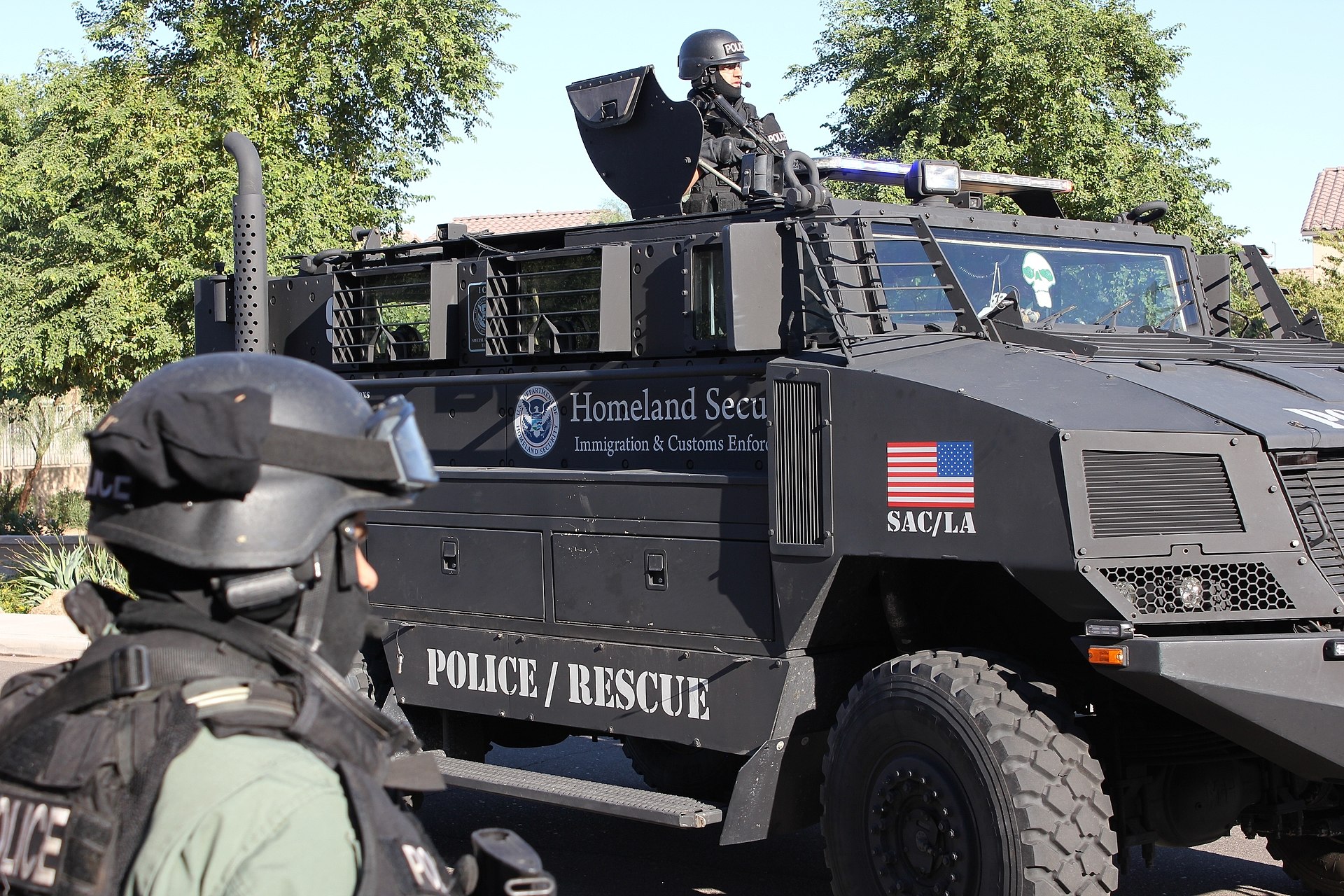 Special reaction team (SRT) during operation against the Sinaloa Cartel in the Arizona's western desert, October 2011 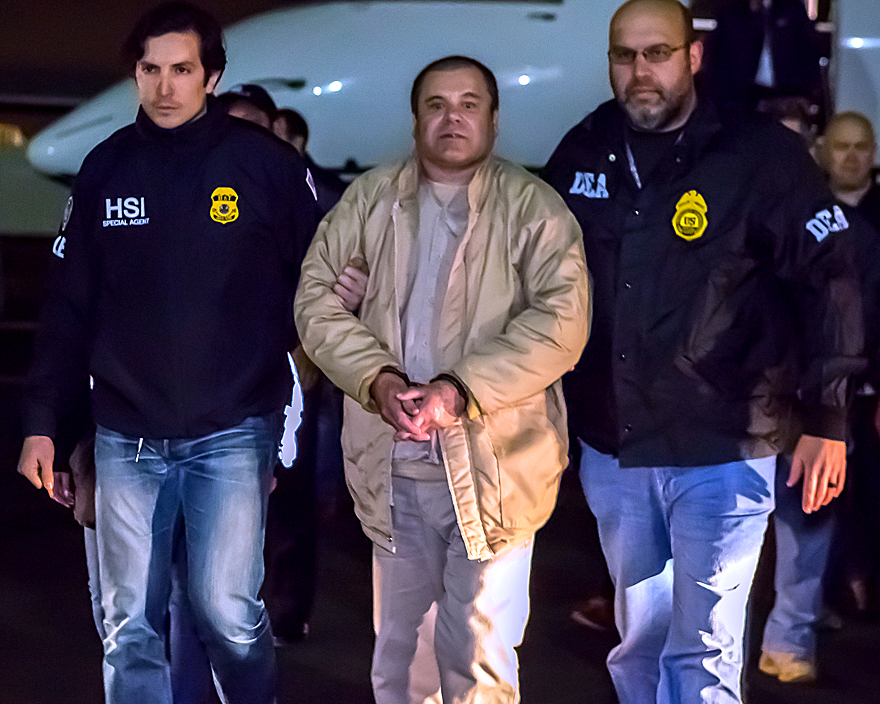 Joaquin Guzmán in U.S. custody when extradited on January 19, 2017 The U.S. Justice Department considers the Mexican drug cartels to be the "greatest organized crime threat to the United States."[408] During the first 18 months of Calderón's presidency, the Mexican government spent about US$7 billion in the war against drugs.[citation needed] In seeking partnership from the United States, Mexican officials point out that the illicit drug trade is a shared problem in need of a shared solution, and remark that most of the financing for the Mexican traffickers comes from American drug consumers.[409] On March 25, 2009, U.S. Secretary of State Hillary Clinton stated that "[America's] insatiable demand for illegal drugs fuels the drug trade", and that "the United States bears shared responsibility for the drug-fueled violence sweeping Mexico."[410] U.S. State Department officials knew that Mexican ex-president Felipe Calderón's willingness to work with the United States was unprecedented on issues of security, crime and drugs, so the U.S. Congress passed legislation in late June 2008 to provide Mexico and Central American countries with US$1.6 billion for the Mérida Initiative, a three-year international assistance plan. The Mérida Initiative provides Mexico and Central American countries with law enforcement training and equipment, as well as technical advice to strengthen the national justice systems. The Mérida Initiative does not include cash or weapons. Currently, the Mexican drug cartels already have a presence in most major U.S. cities.[411] In 2009, the Justice Department reported that Mexican drug cartels distribute drugs in nearly 200 cities across the United States,[412] including Los Angeles, Chicago and Atlanta.[413] Gang-related activity and violence has increased along the U.S. Southwest border region, as U.S.-based gangs act as enforcers for Mexican drug cartels.[414] U.S. death toll and national security 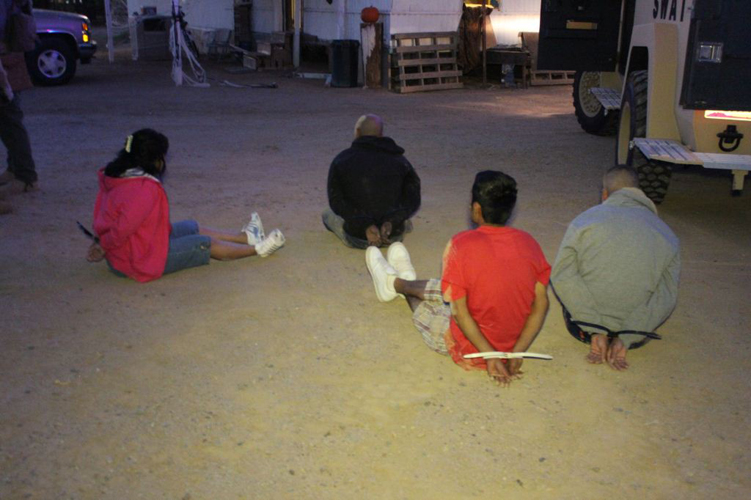 This ICE photo shows people under arrest. Officials announced the discovery of a large drug trafficking operation from Mexico into Arizona. This section needs to be updated. Please help update this article to reflect recent events or newly available information. (November 2020) U.S. authorities reported a spike in killings, kidnappings and home invasions connected to Mexican cartels, and at least 19 Americans were killed in 2008.[415][416] Another 92 Americans were killed between June 2009 and June 2010.[417] The U.S. Joint Forces Command noted in a December 2008 report that in terms of worst-case scenarios, Mexico bears some consideration for sudden collapse in the next two decades as the government, its politicians, police, and judicial infrastructure are all under sustained assault and pressure by criminal gangs and drug cartels.[418] The Joint Forces Command stated concern that the conflict will have a major impact on the stability of the Mexican state over the next several years, and therefore would demand an American response based on the implications for homeland security alone.[418] After the JFC broached this issue in its 2008 report, several journalists and academics have discussed the possibility that Mexico could become a failed state.[419][420][421][422] The Mexican government responded negatively to the U.S. government raising the prospect of Mexico becoming a failed state.[423] In a February 2009 interview with the Associated Press, President Calderón said it was "absolutely false" to label his country a failed state.[424] To smooth over relations with Mexico over this issue, Secretary of State Hillary Clinton personally visited Mexico City in March 2009, followed by a visit by President Barack Obama a month later.[423] 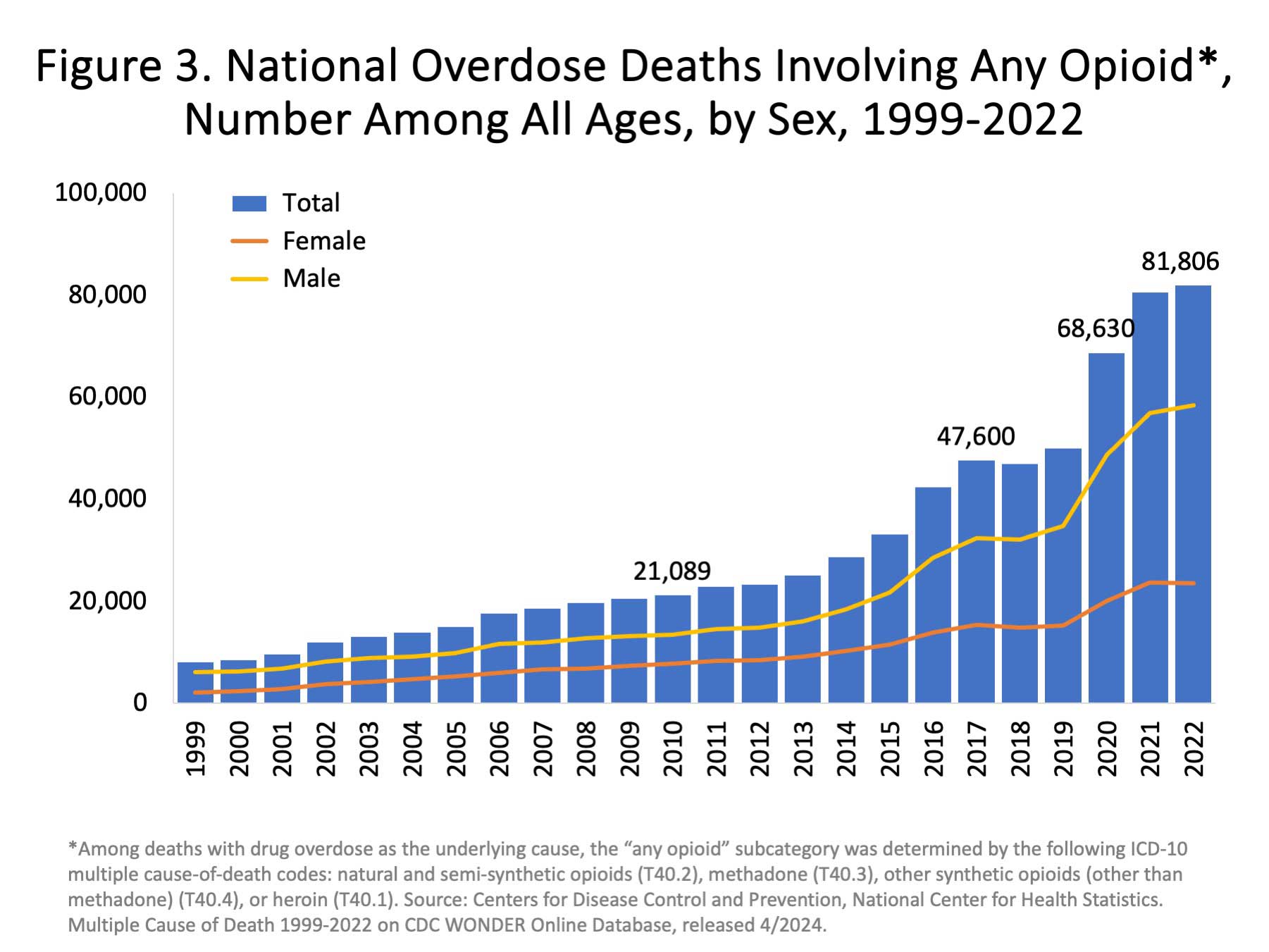 Number of yearly U.S. opioid overdose deaths from all opioid drugs.[425] In March 2009, the U.S. DHS said that it was considering using the National Guard to counter the threat of drug violence in Mexico from spreading to the U.S. The governors of Arizona and Texas have asked the federal government to send additional National Guard troops to help those already there supporting local law enforcement efforts against drug trafficking.[294] Calls for National Guard deployment on the border greatly increased after the 2010 murder of Arizona rancher Robert Krentz, possibly at the hands of Mexican drug smugglers.[426][427] In March 2009, the Obama administration outlined plans to redeploy more than 500 federal agents to border posts and redirect $200 million to combat smuggling of illegal drugs, money and weapons.[428] On May 25, 2010, President Obama authorized deployment of 1,200 National Guard troops to the U.S. border with Mexico to assist with border protection and enforcement activities, as well as help train additional Customs and Border Protection agents.[429] The Washington Office on Latin America said the U.S. southwest border region remained calm, with a homicide rate lower than the national average.[430][431] In 2021, around 80,411 people died from opioid overdoses in the United States.[432] Many of the deaths are from an extremely potent opioid, fentanyl, which is trafficked from Mexico.[433] The drug's precursor chemicals, which have a variety of legitimate uses, are manufactured in China, then shipped to Mexico, where it is processed and packaged, which is then smuggled into the US by drug cartels.[434] In 2023, the Biden administration announced a crackdown on members of the Sinaloa Cartel smuggling fentanyl into the United States.[435] |
アメリカ 関連項目:メリダ・イニシアティブ、ATF銃密売スキャンダル、アメリカ合衆国のオピオイド危機  2011年10月、アリゾナ州西部の砂漠におけるシナロア・カルテルに対する作戦中の特殊対応チーム(SRT)  2017年1月19日に身柄引き渡しが行われた際の、アメリカ国内で拘束されているホアキン・グスマン 米国司法省はメキシコの麻薬カルテルを「米国に対する最大の組織犯罪の脅威」とみなしている[408]。カルデロン大統領就任後最初の18か月間、メキシ コ政府は麻薬撲滅戦争に約70億米ドルを費やした[要出典]。米国に協力を求める中で、メキシコ政府当局者は、違法麻薬取引は共有された問題であり、共有 された解決策が必要だと指摘し、 また、メキシコの麻薬密売組織の資金源のほとんどはアメリカの麻薬消費者が担っていると指摘している。[409] 2009年3月25日、ヒラリー・クリントン米国務長官は、「(アメリカの)違法薬物に対する飽くなき需要が麻薬取引を煽っている」と述べ、「メキシコを 席巻する麻薬がらみの暴力に対しては、アメリカにも責任の一端がある」と発言した。[410] 米国務省高官は、メキシコのカルデロン前大統領が米国と協力する意思を示したのは、安全保障、犯罪、麻薬の問題に関して前例のないことであることを知って いたため、米国議会は2008年6月下旬、3年間の国際支援計画であるメリダ・イニシアティブのためにメキシコと中米諸国に16億ドルを供与する法案を可 決した。メリダ・イニシアティブは、メキシコおよび中米諸国に法執行に関する訓練や装備、および国民の司法制度を強化するための技術的助言を提供してい る。メリダ・イニシアティブには、現金や武器は含まれていない。 現在、メキシコの麻薬カルテルはすでに米国のほとんどの主要都市に進出している。[411] 2009年、司法省は、メキシコの麻薬カルテルが米国のほぼ200都市で麻薬を流通させていると報告した。[412] 2] ロサンゼルス、シカゴ、アトランタを含む。[413] ギャング関連の活動や暴力は、米国南西部の国境地域で増加しており、米国を拠点とするギャングがメキシコの麻薬カルテルの取り締まり役を担っている。 [414] 米国の死者数と国家安全保障  このICEの写真は、逮捕された人々を示している。当局は、メキシコからアリゾナへの大規模な麻薬密売組織の発見を発表した。 このセクションは更新する必要がある。この記事を更新して、最近の出来事や新たに利用可能となった情報を反映させてください。 (2020年11月) 米国当局は、メキシコの麻薬カルテルに関連した殺人、誘拐、家宅侵入の急増を報告しており、2008年には少なくとも19人のアメリカ人が殺害された。 [415][416] さらに2009年6月から2010年6月の間に92人のアメリカ人が殺害された。[417] 米統合軍司令部は2008年12月の報告書で、最悪のシナリオとして、政府、政治家、警察、司法インフラがすべて犯罪組織や麻薬カルテルによる継続的な攻 撃や圧力を受けているため、今後20年以内にメキシコが突然崩壊する可能性を考慮すべきであると指摘した。[418] 統合軍司令部は、この紛争が 今後数年にわたってメキシコ国家の安定に大きな影響を及ぼすことになり、したがって国土安全保障への影響という観点からだけでも、米国の対応が必要になる だろうと懸念を表明した。[418] 2008年の報告書で統合参謀本部がこの問題を取り上げて以来、複数のジャーナリストや学者が、メキシコが破綻国家になる可能性について論じている。 [419][420][421][422] メキシコ政府は、メキシコが破綻国家になる可能性を提起した米国政府に否定的な反応を示した。[423] 2009年2月のAP通信とのインタビューで、カルデロン大統領は、自国を破綻国家と見なすことは「まったくの誤り」であると述べた 。この問題をめぐりメキシコとの関係を円滑にするため、国務長官ヒラリー・クリントンは2009年3月にメキシコシティを自ら訪問し、その1か月後にはバ ラク・オバマ大統領も訪問した。  オピオイド系鎮痛薬による米国の年間死亡者数[425] 2009年3月、米国国土安全保障省は、メキシコにおける麻薬暴力の脅威が米国に拡大することを防ぐため、州兵の投入を検討していると発表した。アリゾナ 州とテキサス州の知事は、麻薬密売に対抗する地元警察の取り組みを支援している州兵に、さらに多くの兵士を派遣するよう連邦政府に要請している 麻薬密売に対する地元の法執行活動を支援している部隊に追加の州兵を派遣するよう連邦政府に要請している。[294] 2010年にアリゾナの牧場主ロバート・クレンツが殺害された事件(おそらくメキシコの麻薬密輸業者の犯行と見られている)[426][427] 以降、国境への州兵派遣を求める声は大幅に高まった。 2009年3月、オバマ政権は、国境の検問所に500人以上の連邦捜査官を再配置し、違法薬物、資金、武器の密輸対策に2億ドルを再配分する計画の概要を 明らかにした。[428] 2010年5月25日、オバマ大統領は、 国境警備と取締活動の支援、および税関国境警備局の捜査官の追加訓練を目的として、メキシコとの国境に州兵1,200人の派遣を承認した。[429] ワシントン・ラテンアメリカ事務所は、米国南西部の国境地域は平穏であり、殺人率は全国平均よりも低いと述べた。[430][431] 2021年、アメリカでは約80,411人がオピオイドの過剰摂取により死亡した。[432] 死亡者の多くは、メキシコから密輸される極めて強力なオピオイドであるフェンタニルによるものである。[433] この薬物の前駆化学物質は、さまざまな合法的な用途があるが、 中国で製造され、メキシコに輸送され、そこで加工および包装された後、麻薬カルテルによって米国に密輸されている。[434] 2023年、バイデン政権は、フェンタニルを米国に密輸しているシナロア・カルテルのメンバーに対する取り締まりを発表した。[435] |
| Controversies See also: Allegations of CIA drug trafficking § Mexico 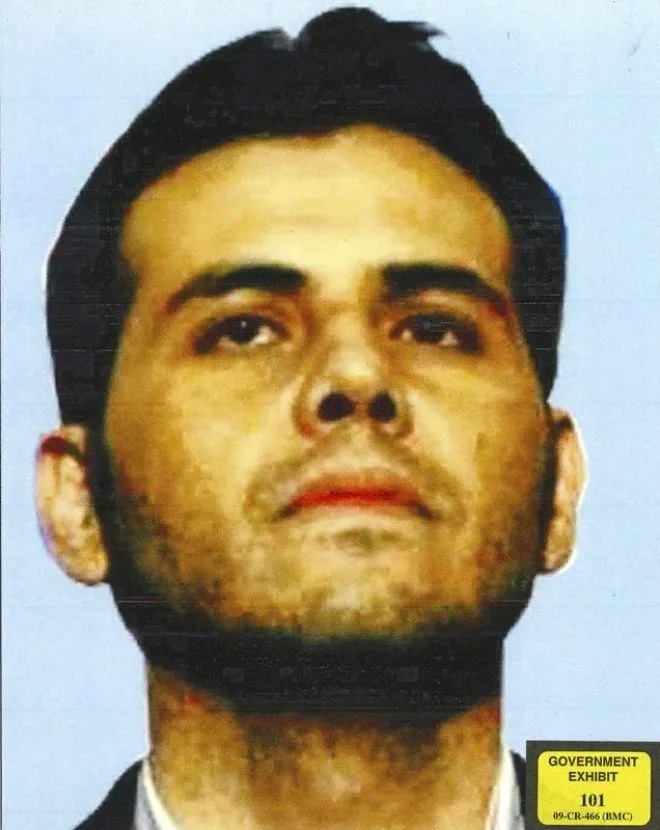 Jesús Vicente Zambada Niebla is the son of Ismael Zambada García (alias, "El Mayo"), one of the top leaders of the Sinaloa drug-trafficking organization Vicente Zambada Niebla, a member of the Sinaloa Cartel and son of Ismael Zambada García, one of the top drug lords in Mexico, claimed after his arrest to his attorneys that he and other top Sinaloa cartel members had received immunity by U.S. agents and a virtual licence to smuggle cocaine over the United States border, in exchange for intelligence about rival cartels engaged in the Mexican drug war.[436][437] In October 2013, two former federal agents and an ex-CIA contractor told an American television network that CIA operatives including Félix Rodríguez were involved in the kidnapping and murder of DEA covert agent Enrique Camarena, because he was a threat to the agency's drug operations in Mexico. According to the three men, the CIA was collaborating with drug traffickers moving cocaine and marijuana to the United States, and using its share of the profits to finance Nicaraguan Contra rebels attempting to overthrow Nicaragua's Sandinista government. A CIA spokesman responded, calling it "ridiculous" to suggest that the Agency had anything to do with the murder of a U.S. federal agent or the escape of his alleged killer.[438] According to former Presidents Fernando Henrique Cardoso of Brazil, Ernesto Zedillo of Mexico and César Gaviria of Colombia, the United States-led drug war is pushing Latin America into a downward spiral; Mr. Cardoso said in a conference that "the available evidence indicates that the war on drugs is a failed war".[439] The panel of the Latin American Commission on Drugs and Democracy commission, headed by Cardoso, stated that the countries involved in this war should remove the "taboos" and re-examine the anti-drug programs. Latin American governments have followed the advice of the U.S. to combat the drug war, but the policies had little effect. The commission made some recommendations to United States President Barack Obama to consider new policies, such as decriminalization of marijuana and to treat drug use as a public health problem and not as a security problem.[440] The Council on Hemispheric Affairs states it is time to seriously consider drug decriminalization and legalization,[441] a policy initiative that would be in direct opposition to the interests of criminal gangs. Money laundering Despite the fact that Mexican drug cartels and their Colombian suppliers generate, launder and remove $18 billion to $39 billion from the United States each year,[442] the U.S. and Mexican governments have been criticized for their unwillingness or slow response to confront the various cartels' financial operations, including money laundering.[442][443][444] The U.S. DEA has identified the need to increase financial investigations relating to the movement of illegal drug funds to Mexico.[445] The DEA states that attacking the financial infrastructure of drug cartels has to play a key role in any viable drug enforcement strategy.[445][446] The U.S. DEA has noted that the U.S. and Mexican financial services industry continues to be a facilitator for drug money movement.[445][447] Following suit, in August 2010 President Felipe Calderón proposed sweeping new measures to crack down on the cash smuggling and money laundering. Calderón proposes a ban on cash purchases of real estate and of certain luxury goods that cost more than 100,000 pesos (about US$8,104.) His package would also require more businesses to report large transactions, such as real estate, jewelry and purchases of armor plating.[444] In June 2010, Calderón "announced strict limits on the amount in U.S. dollars that can be deposited or exchanged in banks",[444] but the proposed restrictions to financial institutions are facing tough opposition in the Mexican legislature.[442][444] In 2011, Wachovia, at one time a major U.S. bank, was implicated in laundering money for Mexican drug lords.[448] In a settlement, Wachovia paid federal authorities $110 million in forfeiture.[449] A U.S. Senate report[450][451] from the permanent subcommittee for investigations revealed in July 2012 that HSBC – one of Europe's biggest banks- moved $7 billion in bulk cash from Mexico to the U.S., most of it suspected to assist Mexican drug lords and U.S. drug cartels in moving money to the U.S.[452][453] While money laundering problems at HSBC have been flagged by regulators for nearly a decade, the bank continued to avoid compliance. On December 12, 2012, HSBC settled for a $1.93 billion fine.[454] Drug demand RAND studies released in the mid-1990s found that using drug user treatment to reduce drug consumption in the United States is seven times more cost effective than law enforcement efforts alone, and it could potentially cut consumption by a third.[455] In FY2011, the Obama administration requested approximately $5.6 billion to support demand reduction. This includes a 13% increase for prevention and almost a 4% increase for treatment. The overall FY2011 counter-drug request for supply reduction and domestic law enforcement is $15.5 billion with $521.1 million in new funding.[456] |
論争 関連情報: CIAによる麻薬密売疑惑 § メキシコ  ヘスス・ビセンテ・サンバーダ・ニエブラは、シナロア麻薬密売組織のトップリーダーの一人であるイスマエル・サンバーダ・ガルシア(通称「エル・マヨ」) の息子である シナロア・カルテルのメンバーであり、メキシコの麻薬王の一人であるイスマエル・ザンバダ・ガルシアの息子であるヘスス・ビセンテ・ザンバダ・ニエブラ は、逮捕後に弁護士に対して、自身と他のシナロア・カルテルの幹部たちは、メキシコ麻薬戦争に関与するライバルの麻薬カルテルに関する情報を提供する見返 りとして、米国の捜査官から免責特権と米国との国境を越えてコカインを密輸する事実上の許可を得ていたと主張した。[436][437] 2013年10月、2人の元連邦捜査官と元CIA請負業者がアメリカのテレビ局に対して、フェリックス・ロドリゲスを含むCIA工作員がDEA秘密捜査官 エンリケ・カマレナの誘拐と殺害に関与していたと語った。3人の証言によると、CIAは米国にコカインやマリファナを密輸する麻薬密売組織と協力し、その 利益の一部をニカラグアのサンディニスタ政権を転覆させようとするニカラグアのコントラ反政府勢力に資金援助していたという。CIAの広報担当者は、 CIAが米国の連邦捜査官の殺害やその容疑者の逃亡に関与していると示唆するのは「ばかげている」と反論した。 ブラジルのフェルナンド・エンリケ・カルドーゾ元大統領、メキシコのエルネスト・セディージョ元大統領、コロンビアのセサル・ガビリア元大統領によると、 米国主導の麻薬戦争はラテンアメリカを負のスパイラルに陥れている。カルドーゾ氏は会議で「入手可能な証拠は、麻薬戦争が 麻薬戦争は失敗した戦争である」と述べた。[439] カルドーゾが委員長を務めるラテンアメリカ麻薬問題・民主主義委員会は、この戦争に関与する国々は「タブー」を排除し、麻薬対策プログラムを再検討すべき であると述べた。ラテンアメリカの各国政府は、麻薬戦争に対抗するために米国の助言に従ってきたが、その政策はほとんど効果を上げていない。委員会は、オ バマ米大統領に対して、マリファナの非犯罪化など新たな政策を検討し、薬物使用を安全保障問題ではなく公衆衛生問題として扱うよう勧告した。[440] 大西洋評議会は、薬物の非犯罪化と合法化を真剣に検討すべき時が来ていると述べている。[441] これは、犯罪組織の利益に真っ向から対立する政策イニシアティブである。 マネーロンダリング メキシコの麻薬カルテルとコロンビアの供給者が毎年180億ドルから390億ドルを米国で生成し、洗浄し、持ち出しているにもかかわらず[442]、米国 とメキシコ政府は、マネーロンダリングを含むさまざまなカルテルの金融業務に対処する意思がないか、対応が遅いとして批判されている。[442] [443][444] 米国麻薬取締局(DEA)は、メキシコへの違法麻薬資金の流れに関する金融捜査を強化する必要性を指摘している。[445] DEAは、麻薬カルテルの金融インフラを攻撃することが、実行可能な麻薬取締戦略において重要な役割を果たさなければならないと述べている 。米国麻薬取締局は、米国とメキシコの金融サービス業界が麻薬資金の移動を助長し続けていると指摘している。 これに追随して、2010年8月にはフェリペ・カルデロン大統領が、現金密輸と資金洗浄を取り締まるための抜本的な新措置を提案した。カルデロン大統領 は、不動産および10万ペソ(約8,104米ドル)を超える特定の高級品の現金購入を禁止することを提案している。また、この政策パッケージでは、不動 産、宝石、装甲板の購入など、より多くの企業に大口取引の報告を義務付けることとしている。 44] 2010年6月、カルデロンは「銀行に預け入れまたは両替される米ドルの金額に厳格な上限を設ける」と発表したが[444]、金融機関に対する提案された 規制はメキシコ議会で厳しい反対に直面している。[442][444] 2011年には、かつては米国の大手銀行であったワコビアが、メキシコの麻薬王の資金洗浄に関与していたことが発覚した。[448] 和解により、ワコビアは連邦当局に1億1000万ドルの没収金を支払った。[449] 2011年7月に、米国上院の常設調査小委員会がまとめた報告書[450][451]によると、 欧州最大の銀行のひとつであるHSBCが、メキシコから米国へ70億ドルの現金一括を移動させ、その大半がメキシコの麻薬王や米国の麻薬カルテルが米国へ 資金を移動させるのを助けるために使われたと疑われていることが明らかになった。[452][453]HSBCのマネーロンダリング問題は、ほぼ10年に わたって規制当局によって指摘されていたが、同銀行はコンプライアンスを回避し続けた。2012年12月12日、HSBCは19億3000万ドルの罰金で 和解した。 薬物の需要 1990年代半ばに発表されたランド研究所の研究では、米国における薬物使用者の治療による薬物消費の削減は、法執行の取り組みのみの場合と比較して7倍 以上の費用対効果があり、潜在的には消費を3分の1削減できることが分かった。 2011会計年度、オバマ政権は需要削減を支援するために約56億ドルを要求した。この中には、防止策に13%増、治療にほぼ4%増が含まれている。 2011会計年度の薬物対策全体に対する供給削減と国内法執行の要求額は155億ドルで、新規資金は5億2110万ドルである。[456] |
| Narcoculture in Mexico 2011 Mexican protests 2011–12 in the Mexican drug war Borderland Beat Blog del Narco Drug liberalization Mérida Initiative Naval operations of the Mexican drug war Timeline of the Mexican drug war Uppsala Conflict Data Program War on drugs Crime in Mexico Narcoterrorism List of ongoing armed conflicts List of journalists and media workers killed in Mexico List of politicians killed in the Mexican drug war |
メキシコの麻薬文化 2011年のメキシコの抗議 2011年から2012年のメキシコ麻薬戦争 国境地帯の現状 麻薬ブログ 麻薬の自由化 メリダ構想 メキシコ麻薬戦争における海軍の活動 メキシコ麻薬戦争の年表 ウプサラ紛争データプログラム 麻薬戦争 メキシコの犯罪 麻薬テロ 継続中の武力紛争の一覧 メキシコで殺害されたジャーナリストおよび報道関係者の一覧 メキシコ麻薬戦争で殺害された政治家の一覧 |
| https://en.wikipedia.org/wiki/Mexican_drug_war |
リ ンク
文 献
そ の他の情報
Copyleft,
CC, Mitzub'ixi Quq Chi'j, 1996-2099